SparkLAN Communications WUBR507N 802.11abgn Wireless USB Module User Manual Phase One 645 DF and IQ Digital Back Users Guide
SparkLAN Communications, Inc. 802.11abgn Wireless USB Module Phase One 645 DF and IQ Digital Back Users Guide
Contents
WUBR-507N_UserMan_1
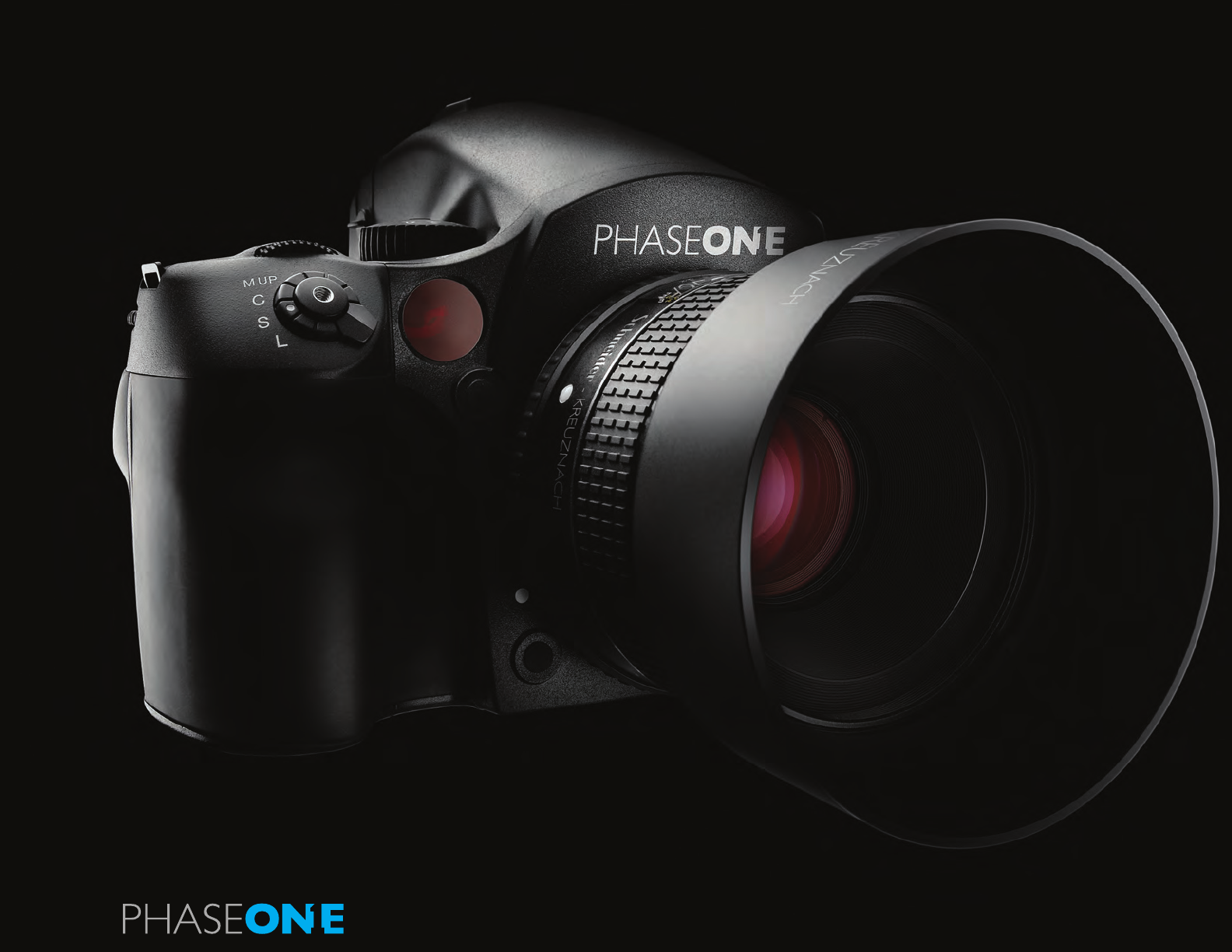
User Guide Phase One 645DF+ Camera and IQ-series Digital Back
User Guide: Phase One 645DF+ Camera and IQ2 Series Digital Back

2
On Rights
©2013 Phase One A/S. All rights reserved. Made in Denmark.
User guide version: 1.0
IQ2 Back rmware version: 1.0
Colorspace images created in CROMiX ColorThink.
Photos by:
Jens Honoré
Stefan Kapfer
Eugeni Pons
Douglas Sonders
Joe Cornish
Antony Spencer
Frederico Martins
Text By :
The dedicated Phase One sta.
On Liability
The information in this User Guide is provided “as is”.
Under no circumstances, including negligence, shall Phase One be liable for any incidental, special, direct,
indirect or consequential damages arising out of or relating to use of the information provided in this guide with
or without the software and/or hardware described in the guide.
Trademarks and Acknowledgements
Capture One and Phase One are either registered trademarks or trademarks of Phase One A/S in the European
Union and/or other countries.
All other trademarks are the property of their respective owners.
This product includes DNG technology under license by Adobe Systems Incorporated.
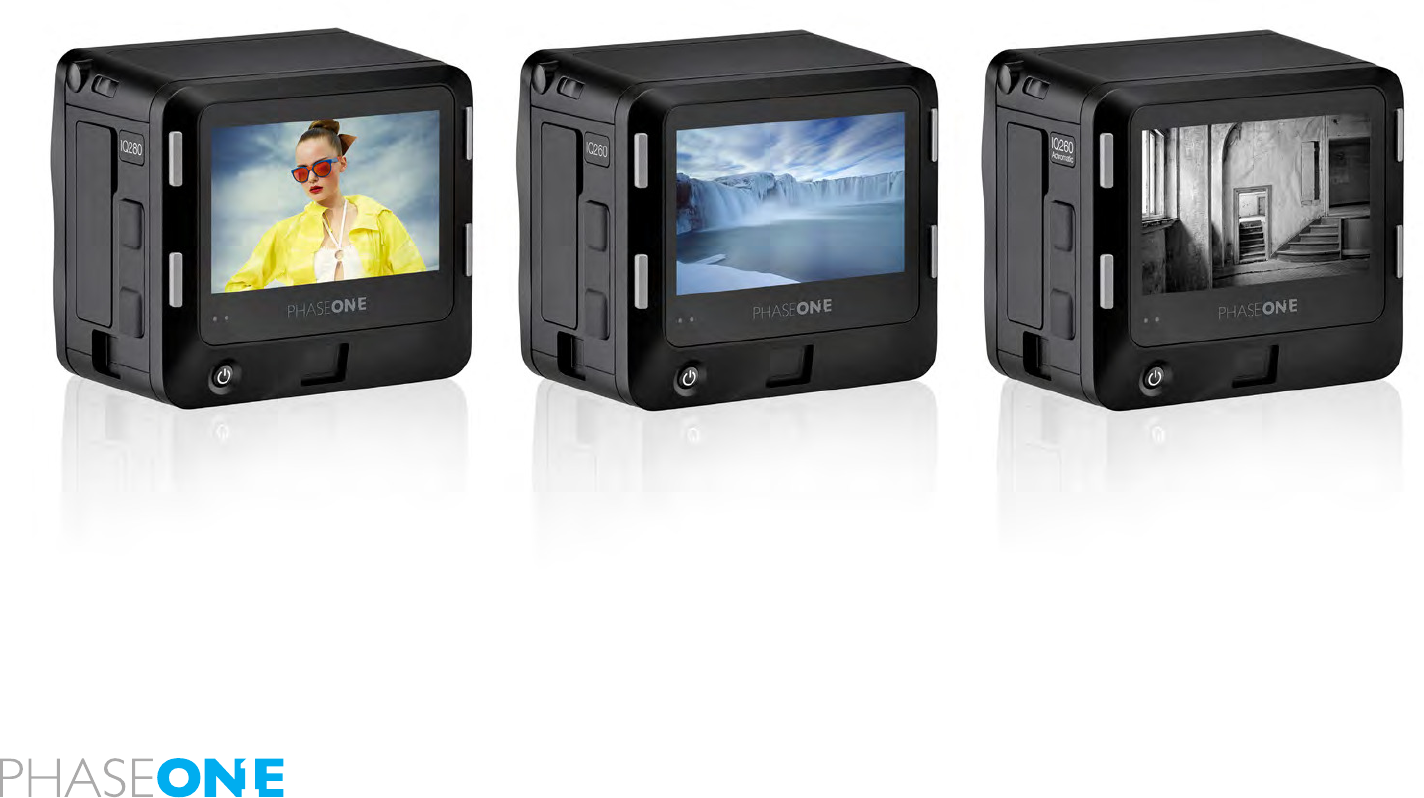
3

4
Contents
1.0 Introduction 8
1.1 Warranty 9
1.2 Installation and Activation of Software 9
1.3 Activation and Deactivation of Capture One 10
1.4 Screen Calibration 11
2.0 The 645DF+ Camera and IQ2 Digital Back System 12
2.1 Unpacking the 645DF+ and IQ2 Digital Back System 12
2.2 Value Added 13
2.3 Classic vs. Value Added 14
2.4 Charging the Batteries for the IQ2 Digital Back 15
2.5 Batteries for Camera (AA and rechargeable Li-ion battery) 16
2.6 Sleep Mode 17
2.7 Attach and Remove Lens 18
2.8 Adjusting the Strap 17
2.9 Attaching the IQ2 Back 20
2.10 Names of Parts and Functions (Nomenclature) 21
2.11 The Displays 22
2.12 Displays, Abbreviations and Electronic Dial Operation 23
2.13 The Buttons on the Back 24
2.14 LED Lights 24
2.15 Setting Date and Time 25
2.16 Setting Diopter 25
Replacing the Diopter Correction Lens 26
2.17 Eyepiece Shutter 26
3.0 Basic Functions 28
3.1 Setting ISO 28
3.2 Setting White Balance 28
3.3 Getting started: Setting the Shutter Release, Focus, Exposure
and Metering modes 29
3.4 Measuring Light – Exposure Metering 31
3.5 Focus Mode 32
3.6 Focus Areas 34
3.7 Using Focus Lock and Infrared Focusing 36
3.8 Drive Dial 38
3.9 Exposure Modes 39
3.10 Flash Photography 43
3.11 Flash Compensation Settings 46
4.0 Introduction to the IQ2 Series Digital Back 49
4.1 Quick Start (shooting untethered) 50
4.2 General Hardware Setup 51
4.3 Indicator Lights 52
4.4 Indicators 52
4.5 Tethered and Untethered Operations 53
4.6 CF Card Usage 55
4.7 Secure Storage System (3S) 56
4.8 Formatting your Memory Card 57
5.0 Navigating the IQ2 User Interface and Menu System 58
5.1 Menu Buttons 59
5.2 Shortcuts 59
5.3 Touch Screen Operation 60
5.4 ISO 61
5.5 White Balance 62
5.6 Custom White Balance 63
6.0 Play Mode 64
6.1 Play Mode Views 65
6.2 Play Mode: Context Menu 66
6.3 Info Bar 67
6.4 Play Mode Navigation 67
6.5 Zoom 67
6.6 Delete and Rating 68
6.7 Delete in Thumbnail View 69
6.8 Grid 70
6.9 Tools 72
7.0 Menu 73
7.1 645DF+ (Camera Custom Functionality from 7.1 to 7.1.28 ) 76
7.1.1 Setup C1, C2 or C3 76

5
7.1.2 Exposure Program 76
7.1.3 AF Area 76
7.1.4 Light Metering 76
7.1.5 Custom Function Set 77
7.1.6 Setup Custom A, B or C 77
7.1.7 EV Step 77
7.1.8 Lens Change 77
7.1.9 Sleep Timer 77
7.1.10 Battery Type 78
7.1.11 Bracketing 78
7.1.12 Front / Rear Dial 78
7.1.13 Rear Dial in P-mode 78
7.1.14 Dial Direction 78
7.1.15 AEL / AFL button 79
7.1.16 Release Button 79
7.1.17 AEL 79
7.1.18 AFL 80
7.1.19 M-Mode AEL 80
7.1.20 AF Assist Light 80
7.1.21 Flash Sync 81
7.1.22 Beep 81
7.1.23 Shutter in Tv/Av/P 81
7.1.24 Shutter in M/X 82
7.1.25 AF priority 82
7.1.26 Active Custom Set 83
7.1.27 Restore to Default 83
7.1.28 About System 83
7.2 Format Card 84
7.3 WiFi 84
WiFi (Cont.) 85
7.4 Power Management 86
Display O Time 86
Battery Charging 86
Auto Power Down 86
7.5 Check Disk 87
7.6 Storage Mode 87
7.7 File Format 88
7.8 Camera Mode 88
7.9 Shutter Latency 88
7.10 Image Orientation 88
7.11 Auto Preview Mode 89
7.12 Display 89
Brightness 89
Display O Time 89
Splash Screen 90
Background Image 91
7.13 Ready Beep 92
7.14 Date And Time 92
7.15 Language 92
7.16 Restore to Default 93
7.17 Firmware 93
Restore Firmware 94
Dump Log 94
7.18 About 94
8.0 IQ2 Series Digital Back Overview 95
8.1 IQ280 Digital Back Specifications 96
8.2 IQ260 Digital Back Specifications 97
8.3 IQ260 Achromatic Digital Back Specifications 98
9.0 Advanced 645DF+ Camera Functions 100
9.1 Exposure Compensation 100
9.2 AE Lock 101
9.3 Metered-Value Dierence Indicator 102
9.4 Auto Bracketing 103
9.5 Taking Photos with the Mirror Up 105
9.6 Mirror Up Delay 106
9.7 Bulb Mode & Long Exposure 107
9.8 Camera Display Light 107
9.9 Front/Rear Dial Lock Mechanisms 108
9.10 Self-Timer Mode 109
9.11 Interval Photography 110
9.12 Depth of Field 111

6
9.13 Infrared Photography 112
9.14 Custom Function 113
9.15 Types of Custom Functions 114
9.16 Custom Dial Modes C1, C2 or C3 118
9.17 Lenses and Multi Mount 119
9.18 Functions of the Phase One Lens 119
9.19 Function of the Phase One Lens Adaptor 119
9.20 List of Alternative Lenses 120
10.0 Maintenance 121
10.1 Changing the Focusing Screen 121
10.2 Battery Socket 122
10.3 Tripod/Electronic Shutter Release Contact 122
10.4 Camera Display Error-Notication 123
10.5 Lens Maintenance 124
10.6 Back Maintenance 124
10.7 IR Filter on the CCD 124
10.8 645DF+ Camera Body Specifications 125
10.9 Phase One 645DF+ Housing Specication 126
11.0 Software 127
11.1 To Import Images... 127
12.0 End User Support Policy 128
12.1 Web Resources 129
13.0 Appendix: Open Platform 131
Double Exposure Protection 131
13.1 IQ2 Back and Phase One 645AF/DF/DF+ and Mamiya 645 AFD 132
13.2 Mounting IQ2 back on the Phase One 645 AF &
Mamiya 645 AFD Series 132
13.3 More Details: Phase One and Mamiya 645 Series Cameras 133
Power Management and Shutter Latency 133
Studio Flash Sync on the Camera Body 133
Image Orientation 133
Mirror Up 134
T-mode on the Mamiya 645AFD 134
Viewnder Masking 134
14.0 IQ2 Back for Mamiya RZ67 135
14.1 Mounting IQ2 Back on the Mamiya RZ67 135
14.2 Viewnder Masking 136
14.3 More Details: Mamiya RZ67 137
Mode Selector 137
Shutter Latency Setting Mamiya RZ PRO II 137
Studio Flash Sync on the RZ lens 137
Mirror Up 137
Double Exposure 137
15.0 IQ2 Back for Hasselblad V Series 138
15.1 Mounting the IQ2 Back on a Hasselblad V Series 138
15.2 Mounting a Viewnder Mask on a Hasselblad V Series Camera 139
15.3 More Details: Hasselblad V Series 140
Sync Cable 140
Flash Lead Connection 140
Mirror Up and Shutter Latency Setting 140
Tethered Capture 140
15.4 Hasselblad 555 ELD 141
Shutter Latency Setting 141
Motor Cable on Hasselblad 555 ELD 141
15.5 Hasselblad 553 ELX 142
Cable Connections 142
Shutter Latency Setting 142
15.6 Hasselblad 501 CM and 503 CW without Winder 143
Shutter Latency Setting 143
15.7 Hasselblad 503 CW with Winder CW 143
15.8 Cables shipped with IQ2 back for Hasselblad V 144
16.0 IQ2 Back for Hasselblad H Series 145
16.1 Mounting the IQ Back on a Hasselblad H Series 145
16.2 Viewnder Masking 146
16.3 More Details: Hasselblad H Series 147
Camera Display 147
ISO Settings 147
Auto Exposure 147
Viewnder Information 148

7
Double Exposure Protection 148
Image Orientation 148
Flash Lead Connection 149
16.4 Cables Shipped with IQ back for Hasselblad H 149
17.0 IQ Back for Contax 645 150
17.1 Mounting the IQ Back on a Contax 645 150
17.2 Viewnder Masking 151
17.3 More Details: Contax 645 152
Exposure Modes 152
ISO Settings 152
Double Exposure Protection 152
TTL ash 153
Image Orientation 153
17.4 Flash Lead Connection 153
17.5 Cables Shipped with IQ back for the Contax 645 154
18.0 IQ Back for View Cameras 155
Phase One Sleeping Architecture 155
18.1 Using the 2-shot Release 156
18.2 Using the 1-shot Release 156
18.3 Phase One FlexAdaptor 157
18.4 Shutter Latency Settings for the FlexAdaptor and Other
Technical Camera Adaptors 157
19.0 List of Focusing Screens and Viewnder Masks 158
19.1 Full Frame Focusing Screens or with Engraved Masking 158
19.2 Viewnder Masks 158
20.0 Live View 159
20.1 Starting Live View 160
20.2 White Balance 161
20.3 Quality and Brightness 161
20.4 Zoom 162
20.5 Grid 162
20.6 Auto Stop and Start 162
20.7 Accessories 163
20.8 Live View Camera Support 164
View Cameras 164
Phase One 645AF/645DF/645DF+ 164
Hasselblad H1/ H2 164
Hasselblad V 165
Mamiya RZ67 Pro II/Pro IID 165
Contax 645 165
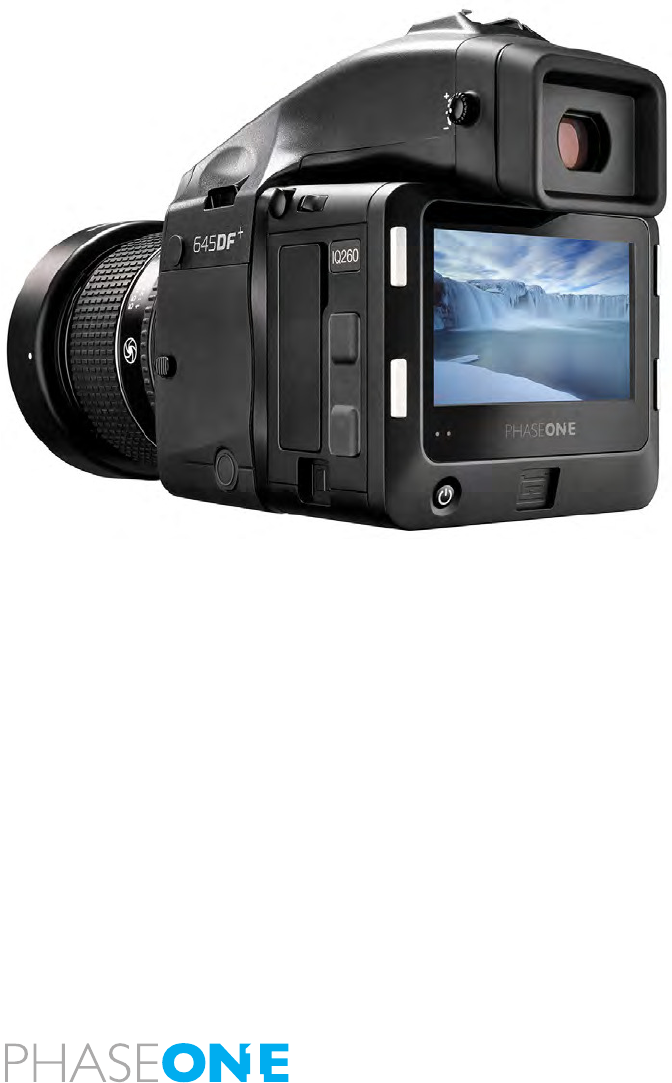
8
1.0 Introduction
Thank you for choosing the Phase One 645DF+ camera and the IQ2 Series
digital back solution.
The Phase One 645DF+ and IQ2 Series digital is the most powerful digital
camera solution whether you are working on location or tethered in a studio.
The Phase One IQ280, IQ260 and IQ260 Achromatic digital camera backs
feature maximum resolutions of 80, 60 and 60 high-quality megapixels
respectively. This series sets new standards for medium format camera
system handling and performance.
The Phase One IQ2 Series system gives you the absolute best solution when
it comes to image quality and workow. Capture One has been optimized for
shooting with Phase One IQ digital backs, and is available for both Mac OS X
and Windows operating systems.
Together with the IQ series backs this professional RAW converter and image
editing software will deliver the World’s highest image quality with excellent
color and detail. The software comprises all the tools required to capture,
organize, edit, share and print images for an ecient workow.
The Phase One 645DF+ camera delivers incredible versatility with support for
what is arguably the widest array of focal plane and leaf shutter lenses on the
market. Phase One is committed not only to provide the best digital solution
for the professional photographer, but also to ensure the photographer’s
freedom of choice regarding lenses, bodies, back, software and accessories.
The entire system comes ready to use in its own customized weatherproof
camera case.
At Phase One we are always committed to providing you with the best
solution for the professional photographer. This Users Guide covers the
specic Phase One 645DF+ and IQ2 Series features and functionality.
We sincerely hope you will enjoy working with this innovative camera
platform and IQ2 Series digital back.
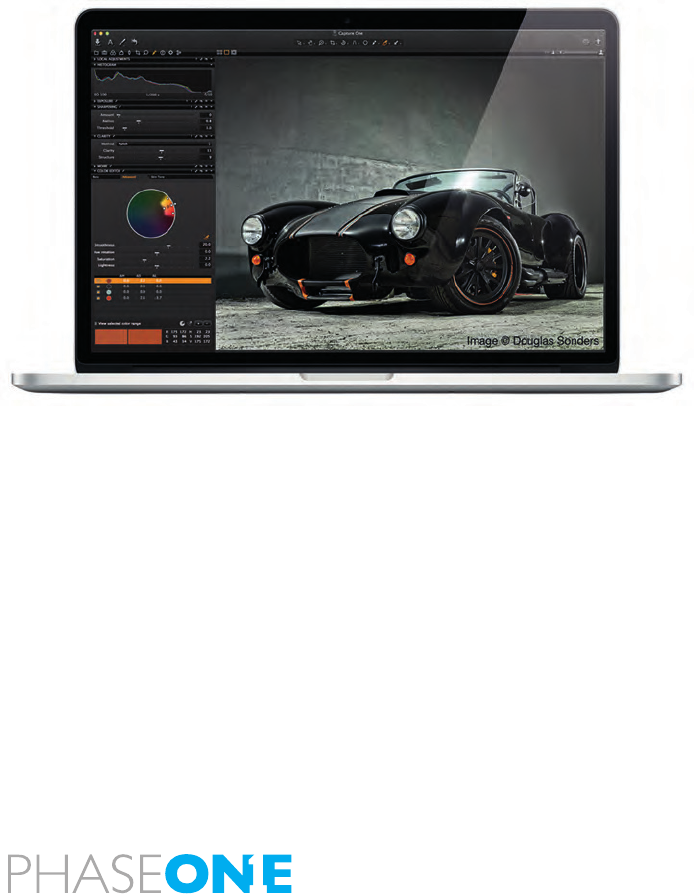
9
1.1 Warranty
Please read the enclosed warranty certicate. Should any problem occur,
please contact your local dealer (place of purchase) to facilitate a repair. DO
NOT try to repair the camera yourself. An unauthorized attempt to repair the
camera will terminate the warranty.
1.2 Installation and Activation of Software
An Internet connection is needed to install Capture One.
Install on Mac:
Capture One software includes an easy-to-use installer that will install all
the software necessary to run the application on Mac OS X 10.5.8 or later.
To install the software follow the procedure below:
1. Either load the Capture One DVD, or download the application from the
Phase One website: www.phaseone.com.
2. Open the Capture One disk image.
3. Read and accept the license agreement presented.
4. Drag the Capture One icon to the Applications folder.
5. Open Capture One from your Applications folder.
Install on Windows:
Capture One includes an easy-to-use installer that will install all the
software you need to run the application on a Windows based computer.
To install the software follow the procedure below:
1. Either load the Capture One DVD, or download the application from the
Phase One website: www.phaseone.com.
2. Run the executable software install le.
3. Read and accept the license agreement presented.
4. Follow the on-screen instructions to complete the installation.
N.B. Capture One will initiate installation of Microsoft® .NET Framework 3.0
if you don’t already have it installed on your computer.
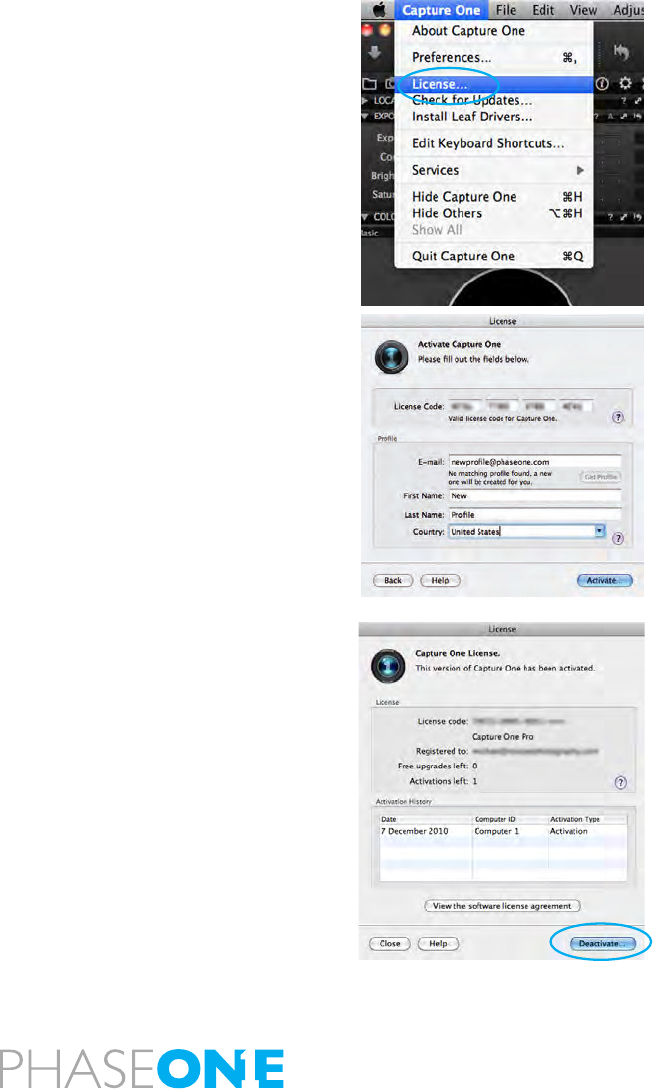
10
1.3 Activation
An Internet connection is needed to activate and update
Capture One.
1. Open the license activation dialogue box via the menu Capture
One>License.
2. Enter your License code and personal details in the required elds. (You
should have received an email with your Capture One license code or it will
be in the original software packaging that you purchased).
3. Once you have entered the information press the ‘Activate’ button and
your software will be validated by Phase One’s activation server.
Your software is now activated and ready for use.
Troubleshooting
If you are experiencing problems activating the software, follow the
instructions provided in the application, read the software manual
enclosed or visit our website for inspiration and troubleshooting:
http://www.phaseone.com/support
Deactivation of Capture One
An Internet connection is needed to deactivate Capture One.
1. Open the license dialogue box via the menu Capture One>License.
2. Press the Deactivate button.
3. Capture One will return to trial mode once it is deactivated. If the trial
period for the computer has expired, all current and pending processing
will be cancelled, and you will not be able to continue working with the ap-
plication until you reactivate it.
4. Conrm that you want to perform the deactivation. After doing so, you
can activate Capture One on another computer.

11
1.4 Screen Calibration
Having a properly calibrated monitor is a critical factor when viewing im-
ages. Ensure that digital viewing conditions are as accurate as possible. A
quality monitor and calibration tool should help guarantee that displayed
images on a screen are precisely rendered. Once a monitor has been
calibrated, the color and brightness controls should be locked to prevent
inadvertent changes.
Hardware-based monitor calibrators are now available at reasonable prices.
The process is simple, quick and enables images to be viewed with con-
dence. Many higher level monitors have internal calibrating software that
works with professional calibration devices for ultimate accuracy.
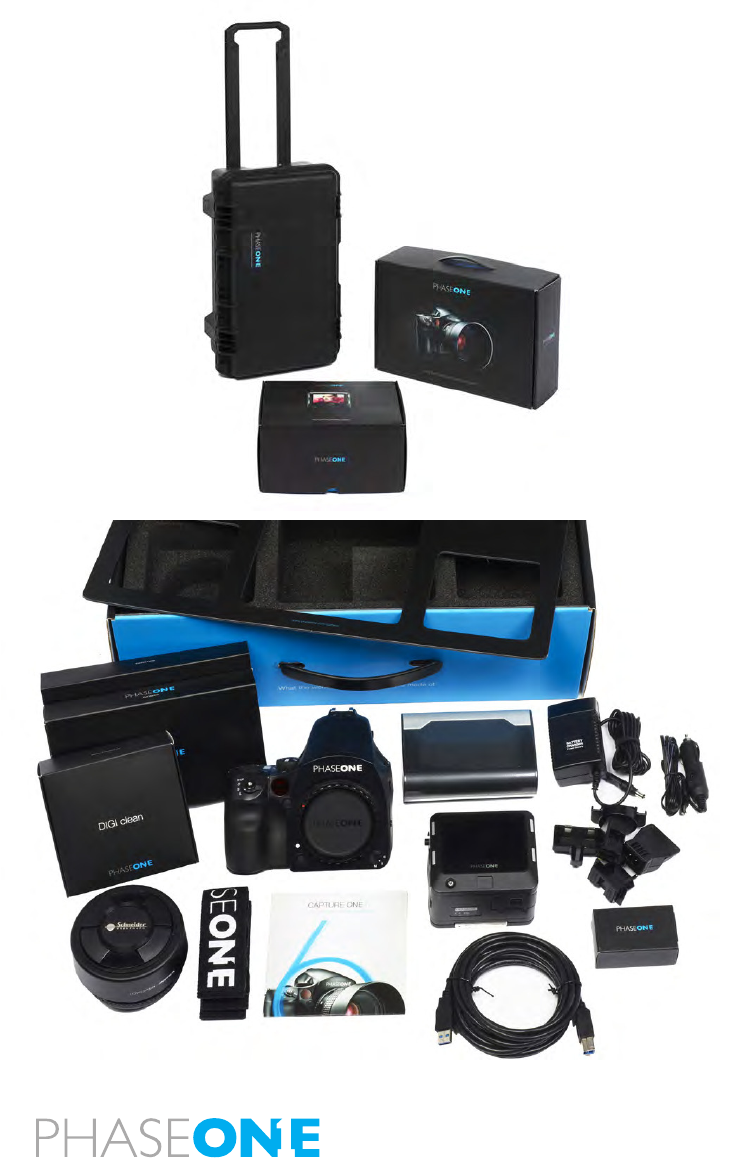
12
2.0 The 645DF+ Camera and IQ2 Digital Back System
The Phase One Camera system is created to provide as much exibility and
openness as possible. For years Phase One has oered two dierent digital
back or camera kit options; the Classic and Value Added.
2.1 Unpacking the 645DF+ and IQ2 Digital Back System
The Phase One 645DF+ and IQ digital back system is delivered in a case
created for the travelling photographer. The dimensions of this waterproof
and impact resistant roller case are compatible with most airlines carry-on
luggage requirements.
Classic:
• Phase One 645DF+ body
• IQ Digital Back
• Schneider Kreutznach 80mm LS f2.8 Lens
• Capture One software
• 1 Year warranty
Accessories
• Digital back battery
• Dual DB battery charger
• Phase One 645DF+ rechargeable Li-Ion battery
• Phase One 645DF+ rechargeable Li-Ion battery charger
• 4.5m FireWire 800 cable
• 3m USB3 cable
• Body and lens caps
• Camera neck strap
• Sensor cleaning kit
• Lens cloth
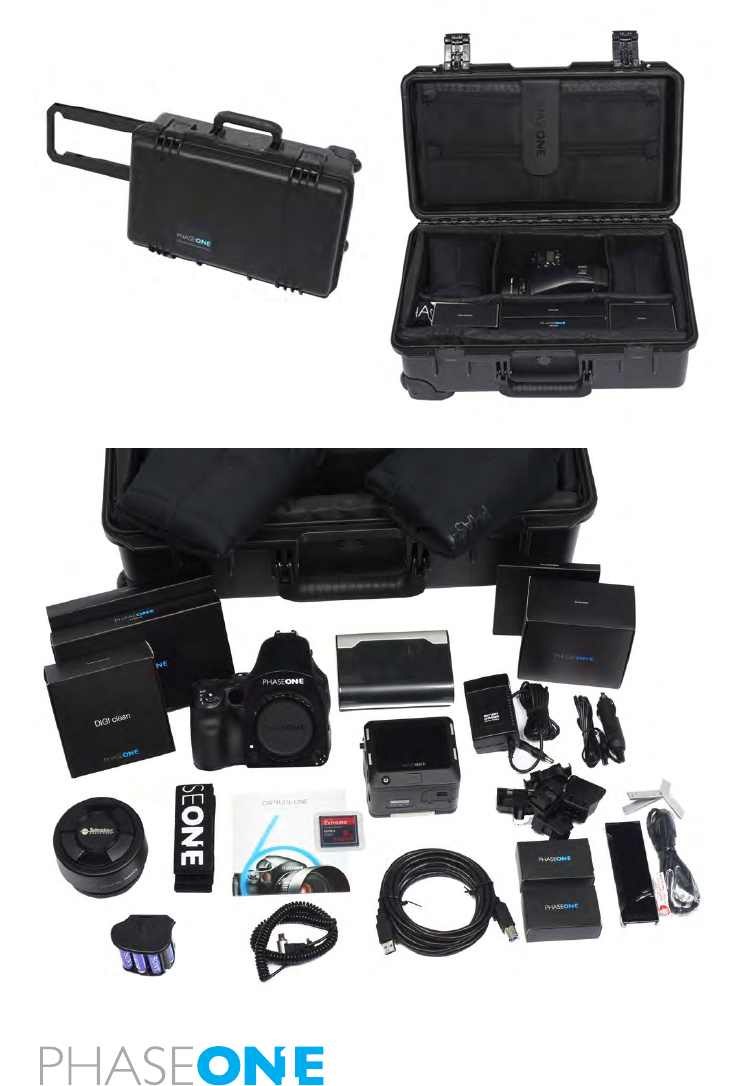
13
2.2 Value Added:
The waterproof roller case will hold:
• Phase One 645DF+ body
• IQ2 Digital Back
• Schneider Kreutznach 80mm LS f2.8 Lens
• Capture One Pro software
• 5 year Value Added warranty on IQ digital backs
Accessories
• Waterproof roller hard case with room for 17” laptop
• Multimount adapter for HB V-lenses
• 2 lens wrappings
• 2 digital back batteries
• Dual DB battery charger
• 2 Phase One 645DF+ rechargeable Li-Ion batteries
• Phase One 645DF+ rechargeable Li-Ion battery charger
• DB Multi connector cable
• LCC calibration kit and 10x10cm plate
• CF card
• CF card reader
• 4.5m FireWire 800 cable
• 3m USB3 cable
• Grey card
• Sensor cleaning kit and lens cloth
• Body and lens caps
• Camera neck strap
The interior of the Value Added case can be customized and congured into
a bespoke system suitcase. An extra set of dividers are provided inside the lid
of the suitcase which can be used to divide the compartments into smaller or
dierent sections to make an ideal storage solution for a camera and lenses.

14
Classic Value Added
IQ2 Series digital back IQ2 Series digital back
Waterproof roller case (with room for
laptop up 17-inch)
Two lens wraps
1 year warranty on IQ digital back,
body and lens
5 year warranty on IQ digital backs
Dual Battery Charger Dual Battery Charger
1 Battery 2 Battery
Focusing screen or Viewnder
Masks depending on camera model
Focusing screen or Viewnder Masks
depending on camera model
4.5m FireWire 800 cable 4.5m FireWire 800 cable
3m USB3 cable 3m USB3 cable
Multi-connector>minijack adapt. cable
Multi-connector sync cable
CF card
CF card reader
Capture One DB software Capture One PRO software
Sensor cleaning kit Sensor cleaning kit
Lens cloth Lens cloth
LCC Calibration kit
Grey card
Lens cast calibration plate
Extra 645DF+ camera battery cassette
for AA batteries
645DF+ camera body 645DF+ camera body
Schedier 80mm LS f2.8 lens Schedier 80mm LS f2.8 lens
Hasselblad V-mount lens adapter
1 year or 100.000 shutter releases on
Schneider Kreuznach lenses
3 year warranty on Phase One AF/MF
lenses
Free digital back loan unit during repair
2.3 Classic vs. Value Added
All the elements of the Value Added kit are available to buy as separate
spare parts. Please consult your local dealer about the dierent Phase One
or third party solutions if extra equipment is needed.
Securing the operational time of a camera and digital back solution is a
critical concern for professional photographers. To be as safe as possible,
consult your dealer to get information on the best solution. Most uptime
solutions provided by Phase One can be purchased after acquiring the back
or camera.
The 645DF+ camera and SK LS lenses have a warranty of 1 year or 100,000
shutter actuations, whichever comes rst. Phase One AF/MF lenses have a
warranty of 1 year in Classic or 3 years in Value Added. Refer to the Warranty
Brochure, which is shipped with the with the Camera System.

15
2.4 Charging the Batteries for the IQ2 Digital Back
Charge the batteries as soon as the camera system has been unpacked.
The Value Added roller case is delivered with two 7.2 volt Lithium-Ion
batteries and a duo-charger.
Although only one battery can be used in the IQ back at a time, it is
recommended to charge both batteries fully before you start.
Always keep a battery in the IQ back even when shooting tethered to a
computer via a FireWire or USB connection. (Go to page 84 for more details
about charging the battery while tethered to a computer).
The battery charger can adapt to voltages within a range of 110 to 250 volts.
It comes with an international set of power adaptors (located in the suitcase
utility compartment). Please select the appropriate one that ts your outlet
and slide it in from the top to mount it in place securely.
Connect the unit to the outlet and charge the batteries (approximately 2.5
to 3 hours).
After the rst initial charge, the batteries can be charged one at a time.
Purchasing Extra Batteries
The Phase One IQ back comes with two batteries. Phase One recommends
the Canon BP 915 (with more than 2500 mAh) if you need to purchase extra
batteries.
Some third party batteries may not t into the digital back’s battery
compartment due to dierences in the tolerances. Do not try to force a
battery into the compartment. When pressing the battery release button it
should slide in without being hindered.
Warning!
• Only use the Charger to charge the specied batteries
• Do not allow charger to get wet or get exposed to moisture
• Keep the Charger out of reach of children
• Once charging is completed, unplug the charger from power source
• Only use the original mains adaptor 12V DC or car lead
• Never apply excessive force when connecting or disconnecting a battery or contact plate.
• Keep all contacts clean.
• Do not force down any of the contacts.
• Do not short-circuit the contacts.
• Never store the battery connected to the charger for an extensive period of time.
• Do not expose to excessive heat or naked ame.
• Do not dismantle or carry out any alteration to the product
• Do not attempt to eat or swallow the battery
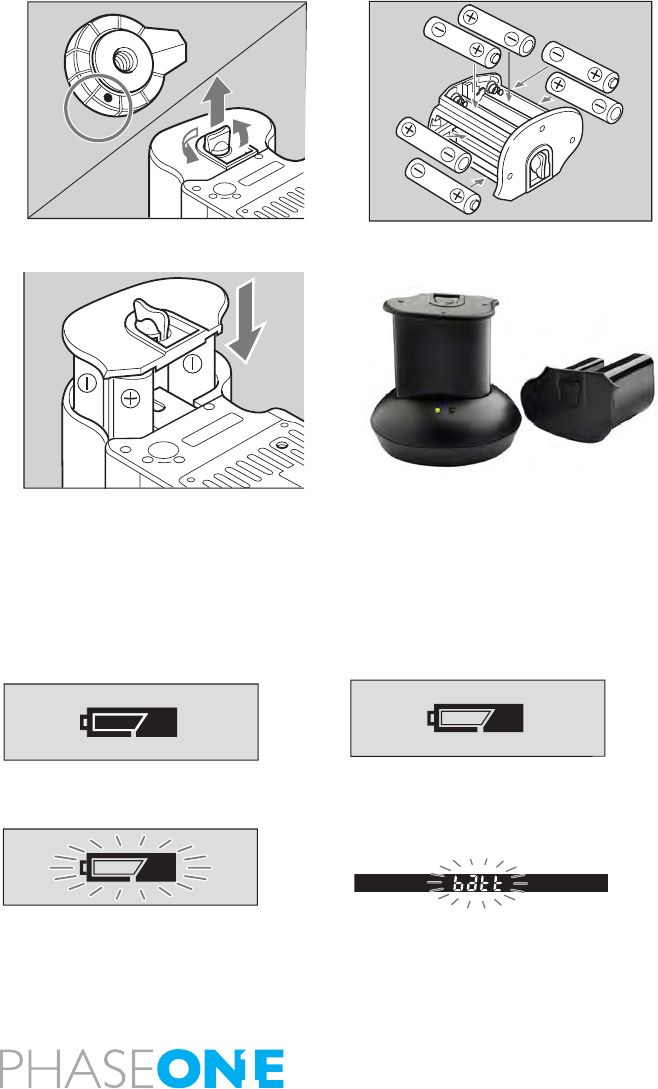
16
2.5 Batteries for Camera
Set the shutter release mode selector lever to L (to turn the power o).
Use six AA alkaline or rechargeable batteries.
NiCd or NiMH batteries should only be used in the camera body if CF04 is set
on rechargeable.
1. Lift the battery case lock lever, turn it counter clockwise and pull out the
battery holder.
2. Insert fresh AA batteries with the + and - ends as shown in the
illustration.
3. Return the battery holder to its case and lock it by turning the lever
clockwise. Make sure it is rmly attached.
N.B. Ensure that the batteries are placed with proper polarity.
Rechargeable Li-ion Battery
The Phase One Rechargeable Li-Ion battery Kit for 645DF+ is included with
the Phase One 645DF+ camera body as standard. (Part #70513)
Please go to page 112 for more information about setting battery type in
custom function 4.
The Value Added kit includes 2 batteries + 1 charger. The Classic kit includes
1 battery + 1 charger.
N.B. The rechargeable Li-Ion battery can be used instead of AA batteries with
the Phase One 645DF. The uptime of one fully charged Li-ion battery is up
to 3 times longer than using standard Alkaline batteries.
Checking the Battery Power
Set the Drive dial lever to S (to turn the power on).
Check the battery condition in the lower left corner of the top LCD screen.
Always use six new batteries of the same type when replacing batteries. Do
not mix dierent types of batteries or use old batteries with new ones. The
camera will not function without a power source.
Never throw out batteries. When a battery does not work, deliver the
battery for appropriate disposal.
C
S
L
M.UP
The batteries are suciently charged. There is little power remaining. Have new
batteries on hand. Camera will still operate.
There is very little power remaining. Camera
will not operate. Set the shutter release mode
selector lever to “L” (to turn the power o) and
replace the batteries with new ones.
When the batteries are emptied for power,
“batt” ashes on the main LCD and the
viewnder’s LCD when the shutter release
button is pressed.
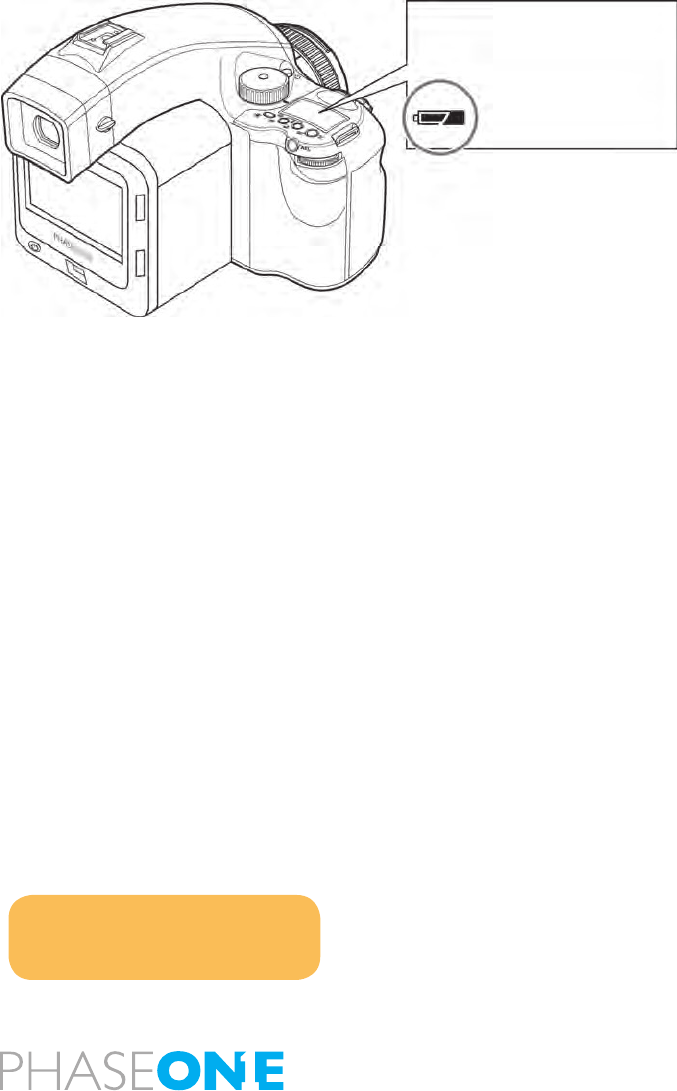
17
2.6 Sleep Mode
The camera’s power is switched on when the shutter release mode selector is
set to S, C or M.UP. In order to prevent the camera’s batteries from discharging,
sleep mode is automatically entered if no operations are performed for a
specic period of time while the power is ON (with exposure metering status
maintained).
In sleep mode, operating the shutter button or a function setting button
restores power ON status.
In sleep mode, the external LCD screens are not active, only the marks shown
in the gure are displayed. (These marks appear in program AE mode.)
1. Battery life of the originally supplied batteries is dependent on storage
conditions.
2. Blots and ngerprints on battery terminals may cause loose connection
and corrosion. Wipe them o before loading the batteries.
3. It is advised to carry spare batteries in remote or foreign locations.
4. Battery performance decreases in low temperatures. Keep them warm
when in cold climates or locations. External battery case PE401 is available as
an optional accessory.
5. Store the batteries in a cool and dry place, away from direct sunlight.
6. Remove the batteries from the camera body when they will not be used
for a long time.
7. Replace the batteries with new ones as soon as they are exhausted. Liquid
leakage from the battery may damage the camera.
8. Read the warnings on the batteries for their handling.
For the purpose of the descriptions and
explanations provided in these instructions, it
is assumed that the camera’s power is on.
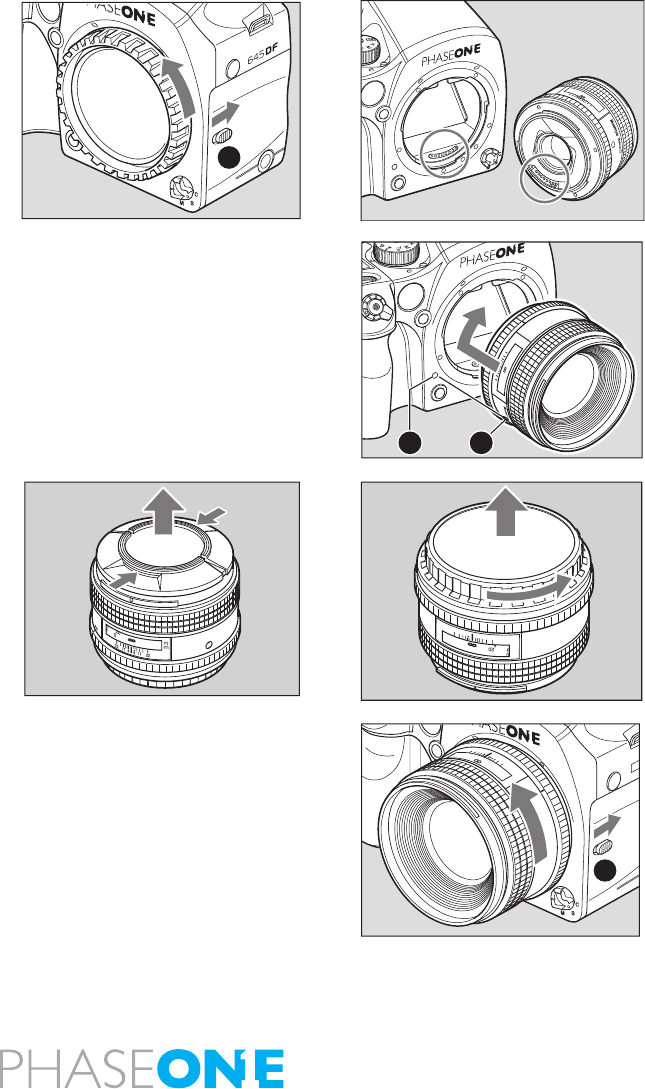
18
2.7 Attach and Remove a Lens
1. Remove the front body cap in the same way that you would remove a lens;
push the lens release button [A] backward and then turn the front body cap
or the lens itself counter clockwise and lift out.
2. Align the white alignment dot of the lens [B] (on the shiny ange) with the
camera’s white dot [C]. Mount the lens and rotate it clockwise until it clicks
into place.
3. To remove the front lens cap, squeeze the shiny sections together and lift
out. (See image far left). To remove rear lens cap turn it counterclockwise.
Remove a Lens
While sliding the lens release button[A] back, rotate the lens counter
clockwise until it stops, and lift it o. After removing the lens from the camera
body, protect both ends by attaching the caps.
N.B. Oil, dust, ngerprints or water on the electronic contacts could result
in malfunction or corrosion. Wipe such impurities o with a clean piece of
cloth. Do not tap the distance ring or other rotating parts when attaching
the lens. When installing a lens, do not press the lens release button.
MF
80mm
1:28
AF
22
22
11
11
44
ft
m
A
80mm
1:28
MF
AF
11
4
4
22
22
20
0
5
ft
m
CB
80mm
1:28
MF
AF
11
11
44
22
22
20
0
5
A
11
11
4
4
22
22
20
ft
m
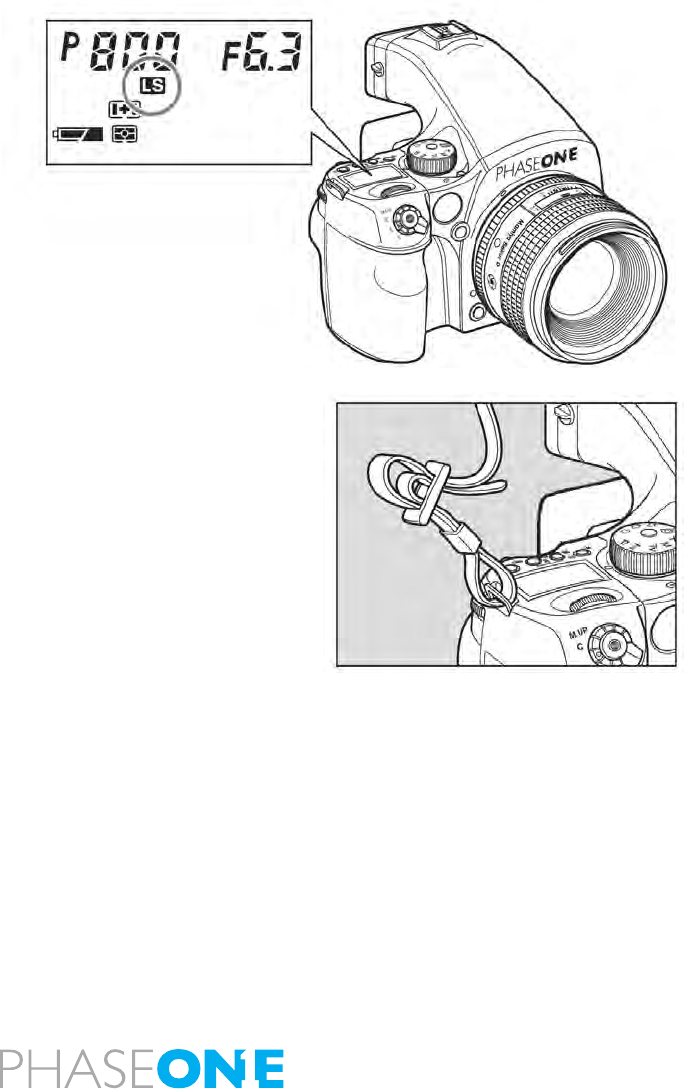
19
Attach a Leaf Shutter Lens
Leaf shutter lenses are equipped with an internal shutter. Leaf shutter
lenses are capable of high shutter speeds 1/800 sec. or 1/1600 on IQ Series
backs with ash synchronization, which is particularly useful for ll-in ash
photography in bright ambient shooting conditions.
When a leaf shutter lens is attached and the leafshutter is used and the letters
LS will appear in the main LCD screen.
2.8 Adjusting the Strap
Put the neck strap through the mounts and secure it to the buckle as
illustrated. After attaching the strap, pull it and ensure it does not loosen at
the buckle.
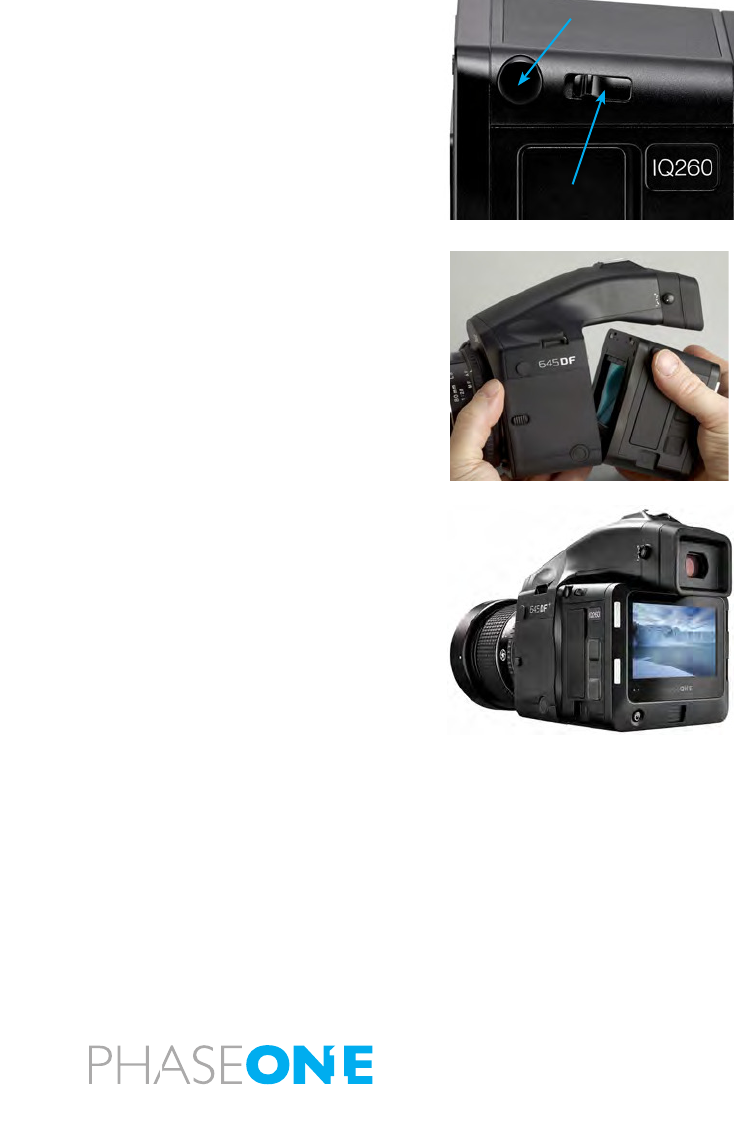
20
2.9 Attaching the IQ2 Back
The IQ back is fully integrated with the camera body and functions as a part
of the whole camera system.
Ensure that the Phase One 645DF+ camera mirror is up and the shutter is
open when no digital back is attached.
When attaching the IQ back to the camera body the shutter will close and
the mirror come down.
First remove the cover on the IQ back and 645DF+ camera. Next, slide forward
the lever [1] and push in button [2], and ensure that the bottom part of the
IQ back is placed correctly in the lower locking mechanism on the back of
the camera body before the upper locking mechanism is pressed together.
Failure to do this can cause an error with the camera body where the shutter will
continuously open and close. If this occurs, remove the IQ back. Make sure the
camera body is powered and press button while mounting the digital back.
Please be aware that the shutter should be in the correct starting position
(shutter open). If this is not the case, attach and remove the IQ back again to
make sure that the camera body gets in the correct starting position.
Remove the IQ back by sliding forward the lever [1], pushing in button [2],
and by gently pulling away the top of the back rst. Be careful with the
contacts and protective glass on the back. Your IQ back should always be
protected by its plate when it is not attached to the camera.
1
2
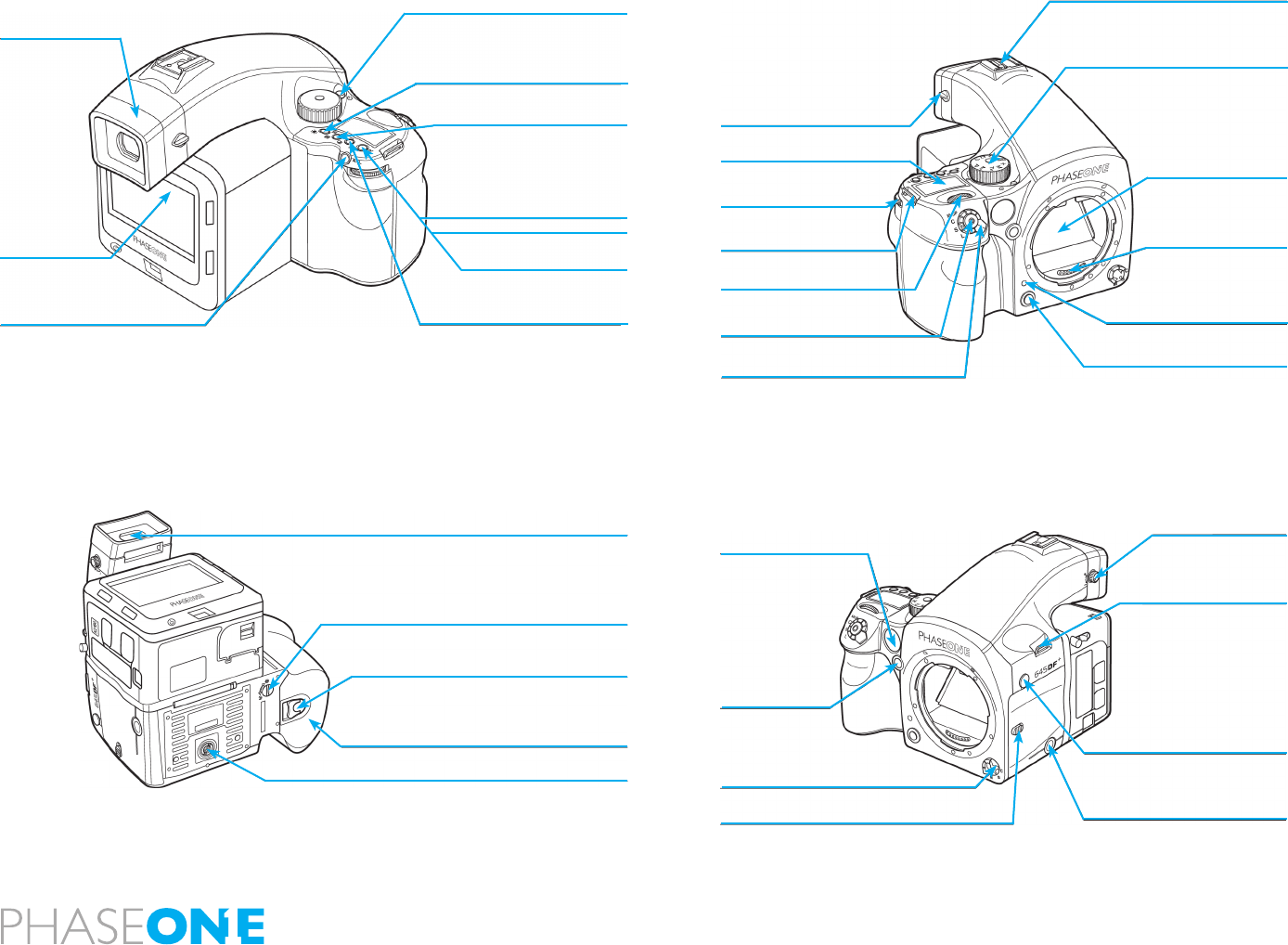
21
2.10 Names of Parts and Functions (Nomenclature)
Rubber Eye Piece
Digital Back
Auto Exposure Lock Button
AEL Exposure Metering button
Self Timer Button
Interval Button
Main LCD Backlight Button
Exposure Metering Mode Button
Focus Point Selector Button
Set Button
Flash Auto Adjustment Select
Button
Exposure Compensation Button
Auto Bracketing Button
Eyepiece Shutter Lever
Main LCD
Rear Dial
Strap Lug
Front Dial
Shutter Release Button
Drive Dial Depth of Field Preview Button
Lens Mount Alignment Mark
Electronic Contacts
Mirror*
*Do not touch the mirror
Exposure Mode Dial
Hot Shoe
Diopter Adjustments Lens (Standard Accessory)
External Power Socket
Battery Case Lock Lever
Battery Case
Tripod Socket
Auto Focus Assist Infrared Light Emission
Self Timer Lamp
Auto Focus
Lock Button
Focus Mode Selector Lever
Lens Release Button
Diopter Adjustments Dial
Strap Lug
Synchro Terminal
Electronic Shutter Release Contact
AEL Exposure
Metering button
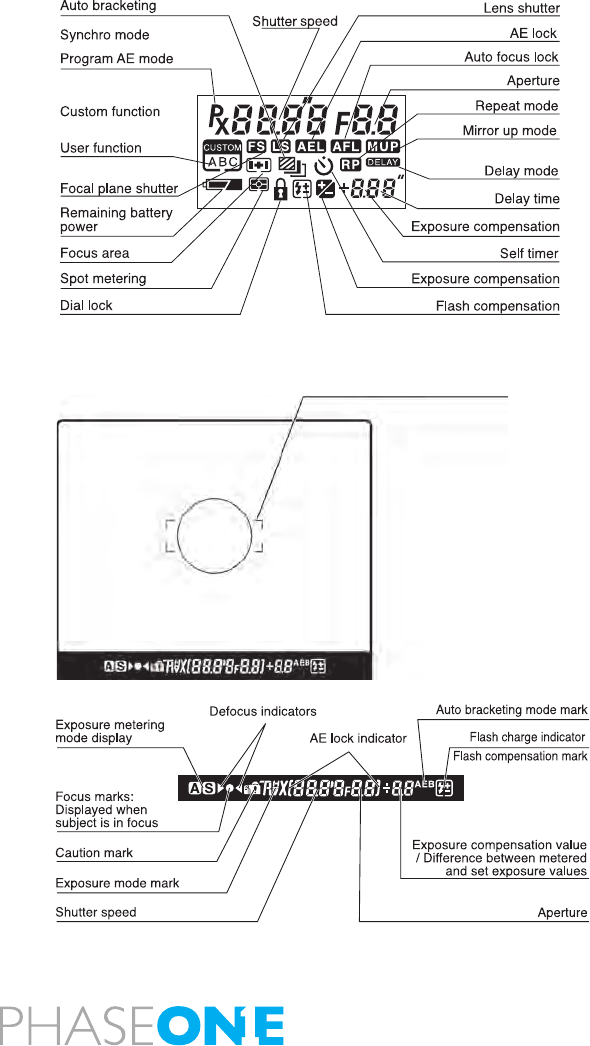
22
2.11 The Displays
The display on the camera body will provide you with a lot of valuable infor-
mation. This includes many features and settings including, but not limited to
shutter speed, aperture value, exposure program, exposure compensations
and metering modes.
Viewnder Display
The most relevant information regarding the exposure and camera settings
can be seen on the bottom display in the viewnder along with the autofocus
mark that indicates correct focus.
During actual use, only the relevant icons and indicators are displayed.
During actual use, only the relevant icons and indicators are displayed.
Auto focus area frame
Main LCD
Viewnder LCD
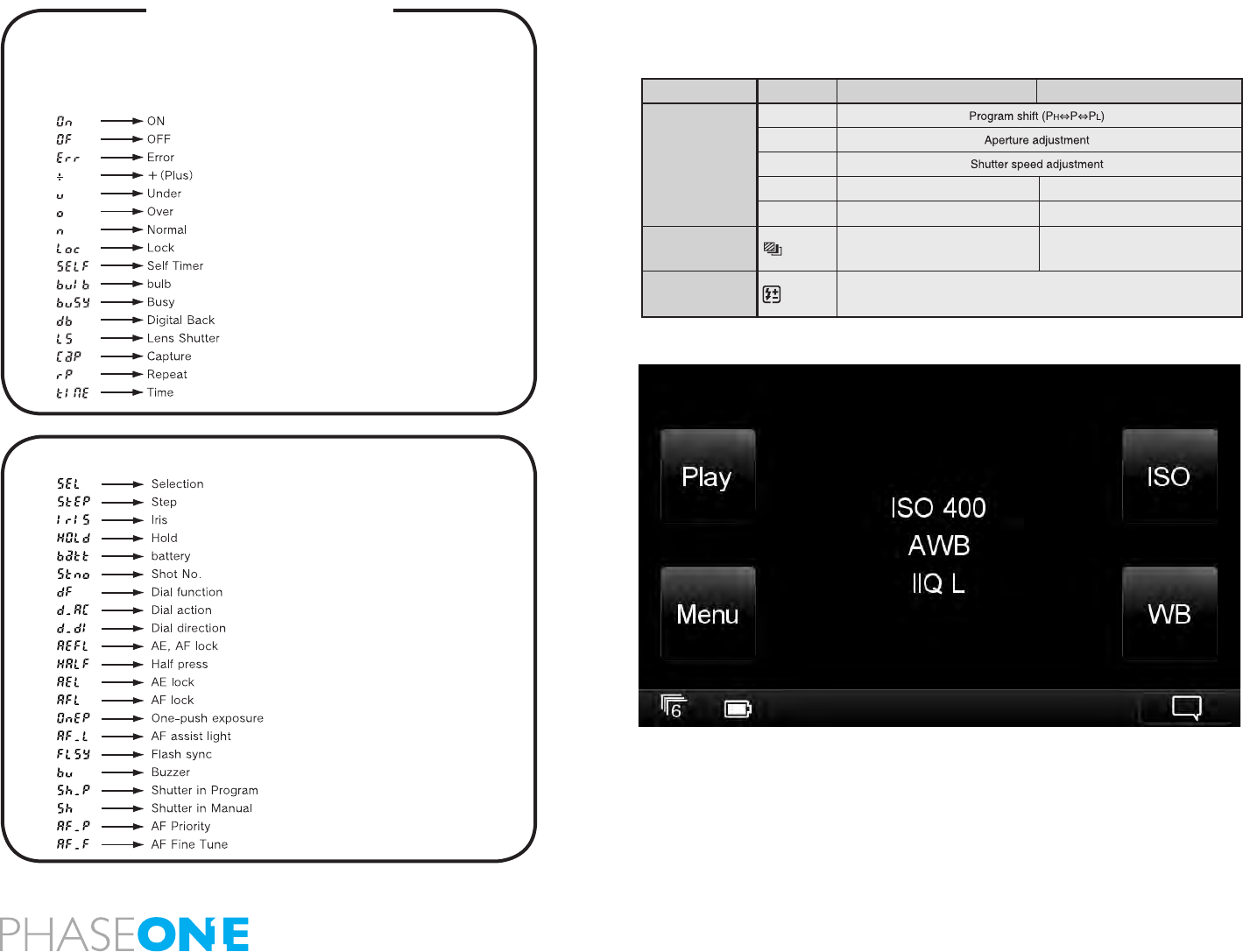
23
2.12 Displays, Abbreviations and Electronic Dial Operation
The touch screen on the of the IQ digital back is a multifunctional display,
where the menus change depending on the status and choices you make.
In addition to providing menu navigation, the display on the back can work
as a preview screen.
Exposure mode
Position
P
Av
Tv
M
X
Shutter speed adjustment Aperture adjustment
Aperture adjustment
Shutter speed adjustment 1/125 to 1/60.
Front dial Rear dial
Flash metering compensation
(when using Metz flash and SCA3952 adaptor)
displayed
displayed
Auto-bracketing
button
Flash auto
adjustment select
button
The multi-turn auto bracketing
repeat setting
Turn the auto bracket ON/OFF
Due to the limitations of the space and letters, words and letters on
the LCD are abbreviated.
Display examples of the main LCD
Liquid Crystal Display
Display examples in the custom function mode
Back Display
Electronic Dial Operation
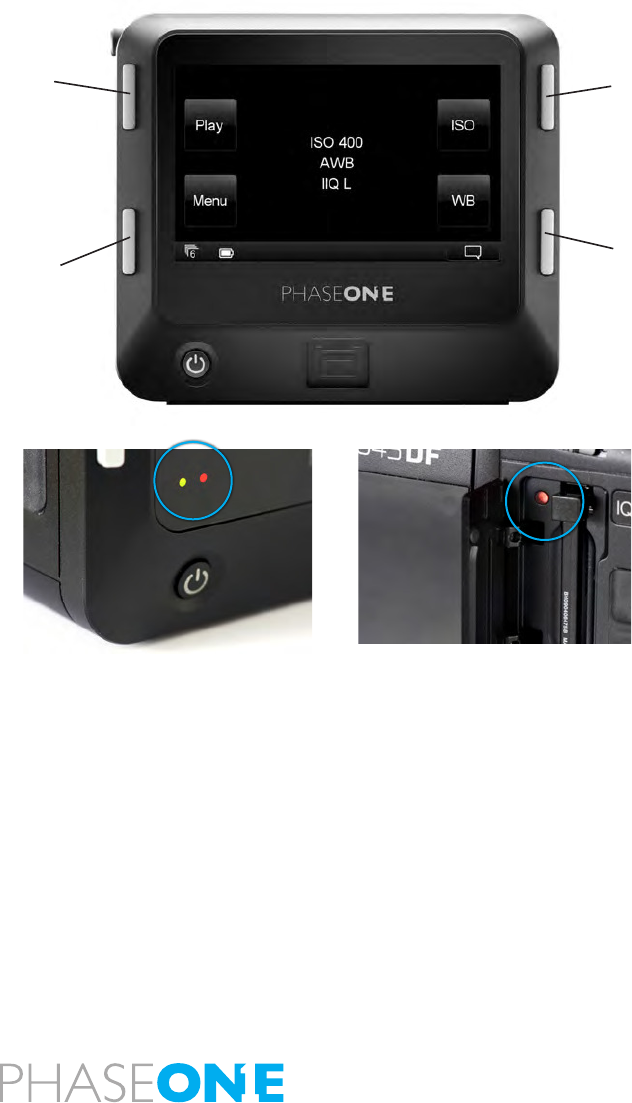
24
2.13 The Buttons on the Back
The IQ is equipped with four external buttons. The buttons will change
function to match the menu shown on the sceen. Find out more on the IQ
menus from page 75.
2.14 LED Lights
IQ Series digital backs feature two main LEDs located below the bottom left
corner of the screen.
Green: When capturing an image the green LED will blink rapidly to indicate
that the IQ back is busy.
A continuous green light indicates that the backlight of the display is dimmed
but the camera is still ready to shoot. (The Display O Time can be set in the
IQ back’s Menu mode in the Power Management options).
Red: A red LED indicates that the IQ back is writing to the storage media, and
therefore the buer has not been emptied.
There is an additional red LED indicator located next to the CF card slot (under
the cover). It is assigned to indicate CF card activity only. Do not remove a CF
card from the card slot when this red LED is on. Removing a CF card whilst
the red LED is on can damage the formatting of the card, and images or data
might be lost or corrupted.
The IQ Series Home screen
Menu
Play ISO
WB
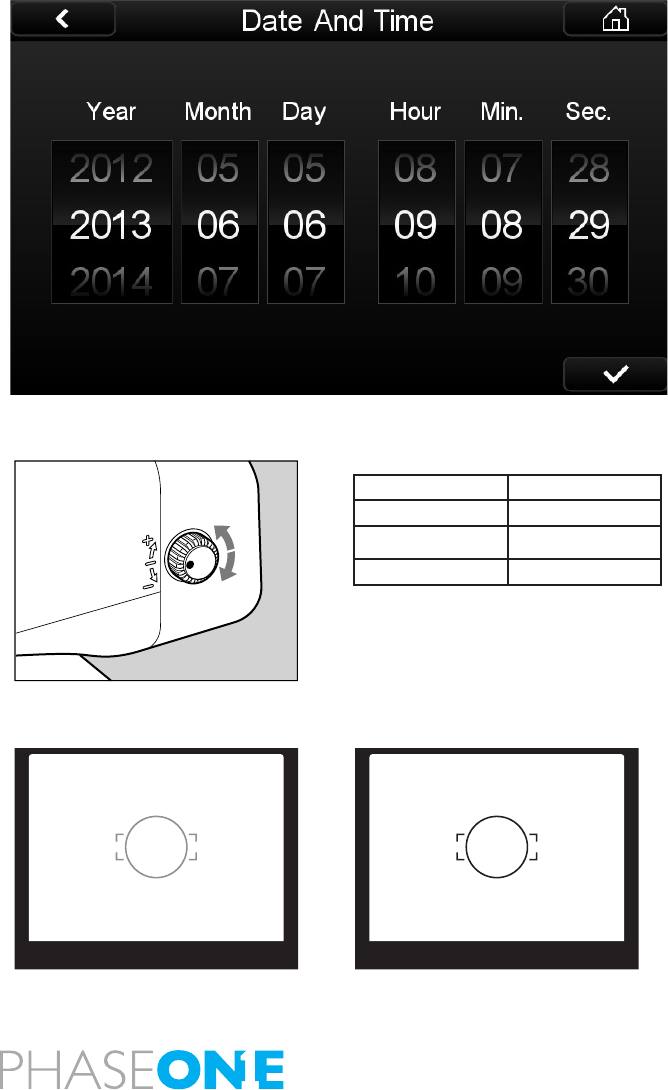
25
2.15 Setting Date And Time
Date and time parameters are set and controlled via the IQ back’s Menu
system.
If the IQ back has been without power for a long period of time, it will
automatically ask you to set the time and date on the next occasion it is
powered up.
Tap the screen and scroll through the numbers to attain the appropriate date
and time. Tap the check mark, which will appear in the bottom right hand
corner of the screen to conrm your entry.
The time and date is applied to the EXIF data in all les captured with the IQ
back.
Diopter not matching
2.16 Setting Diopter
Look through the viewnder and make sure that the focus frame (Rectangle
with Circle) is in sharp focus. If it is not, turn the diopter adjustment dial in the
“–” direction if you are nearsighted or in the “+” direction if you are farsighted.
If this is not sucient you may require an optional diopter correction lens.
Check the table for possible diopters.
Point the camera at a bright, plain object such as a white wall when making
this adjustment.
Diopter matching
Diopter correction lens Range of Adjustment
DE401 (standard) -2,5 to +2,5
DE402 (fnearsighted users) -5,0 to -2,0
DE403 (farsighted users) 0 to +3,0
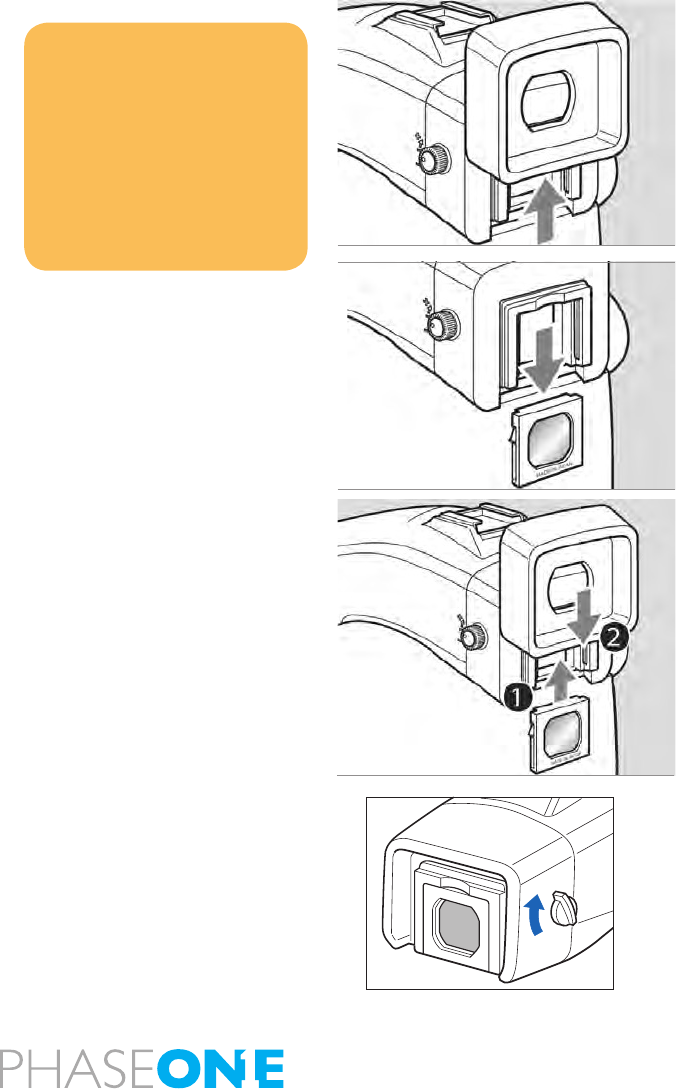
26
Replacing the Diopter Correction Lens
1. Press the Eyepiece Lock, which is located in a gap between the Eyepiece
and the Diopter Correction lens. (Turn the camera upside down to gain easy
access to it). Now remove the rubber Eyepiece by sliding it upwards
2. Remove the lens supplied with the nder by pulling it downward.
3. Remove the existing diopter by sliding downwards using the ngernail
groove and detach. Insert a new diopter by aligning it to the base of the
diopter holder and sliding it upwards into place. Finish by reattaching the
rubber eyecup.
Notice:
If there is dirt or dust on the lens surface,
remove it with a blower or sweep it o
gently with a lens brush
If there are ngerprints or dirt on the
lens surface, wipe them o with a piece
of clean, soft gauze
Using solvents could discolor the
discolor correction lens frame
2.17 Eyepiece Shutter
Close the eyepiece shutter when there is a strong light source behind the
camera or when pressing the shutter release button without looking through
the viewnder. (This prevents exposure error due to light entering from the
viewnder.)
Turn the eyepiece shutter lever in the direction of the arrow.
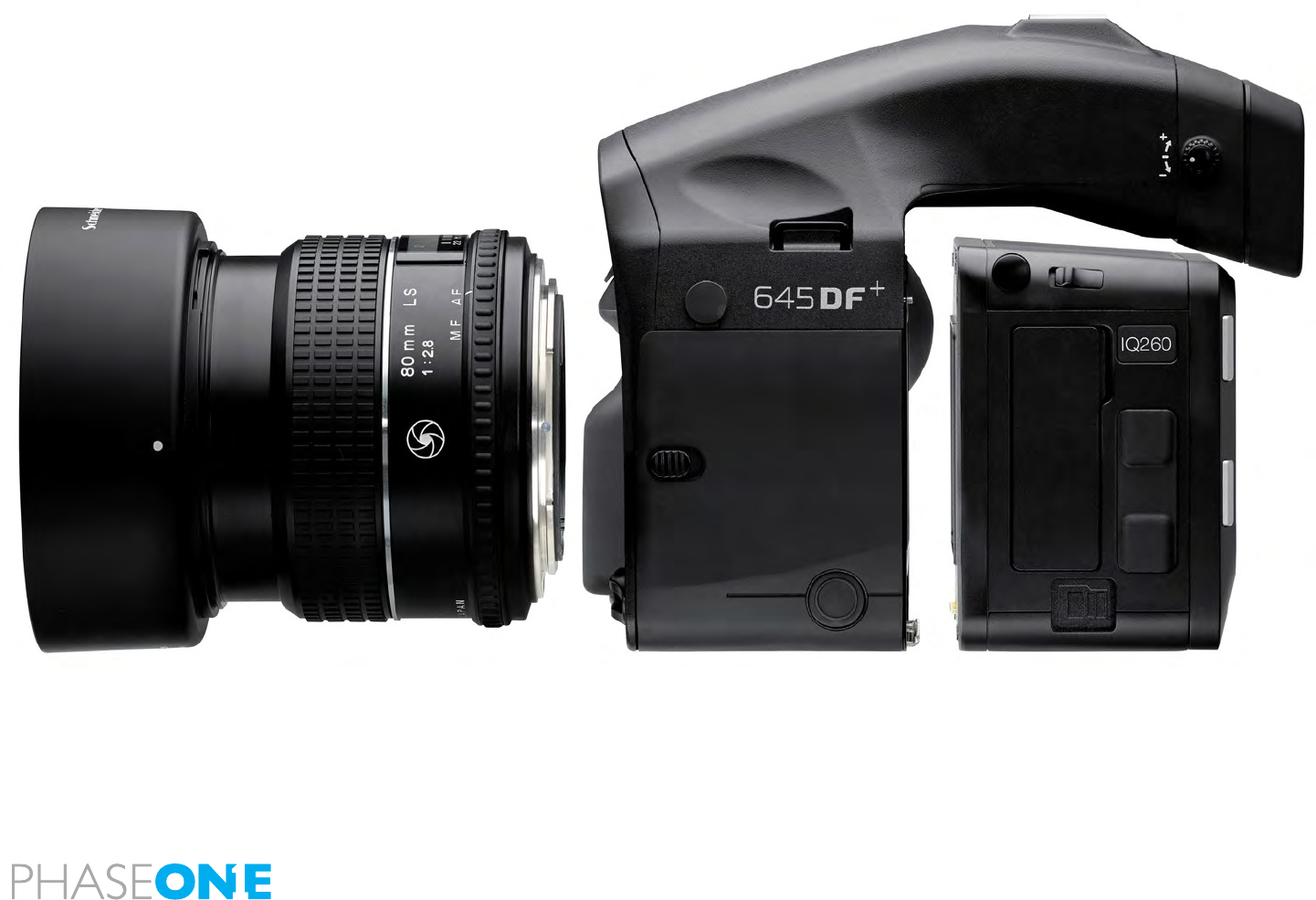
27
27
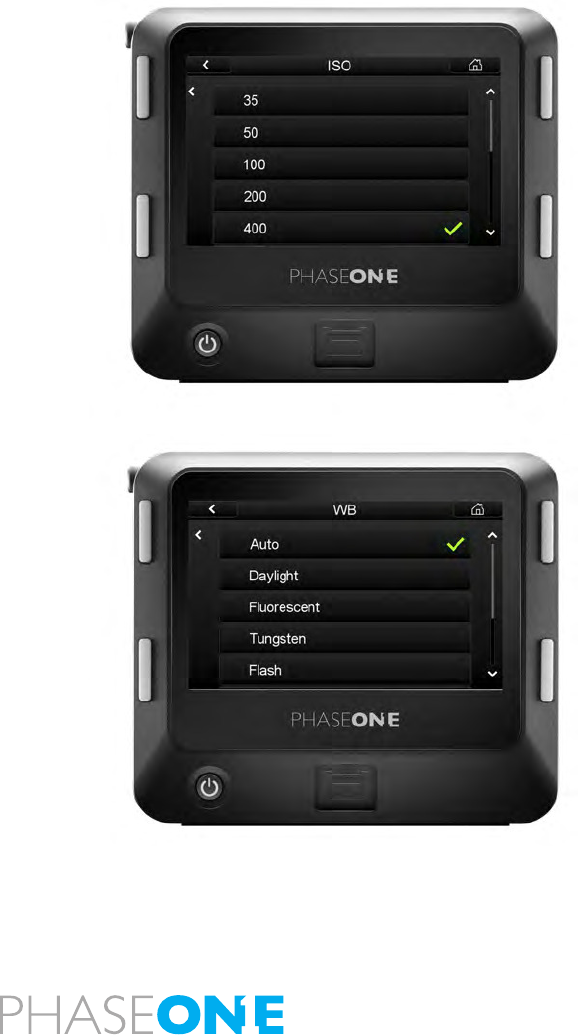
28
3.0 Basic Functions
ISO and White Balance
The IQ back’s Home Screen enables quick access to the ISO and WB settings
by either pressing the adjacent buttons or by tapping the screen directly.
Scroll up and down, then select the setting by tapping the screen next to the
desired rating so that a green check mark appears. White Balance and ISO
settings can also be controlled from Capture One if you are working tethered.
3.1 Setting ISO
The default ISO setting is 50 for all IQ Series models. Remember that the
higher the ISO setting, the higher the degree of image noise. The camera
system together with Capture One software deliver a powerful noise
reduction performance although it is possible to still see some noise at the
higher sensitivity settings.
Push the upper right button or tap ISO on the screen on the IQ back’s Home
Screen. You will be presented with the back’s ISO spectrum. Scroll up and
down and tap the screen to select the desired setting. A green check mark
will appear next to your chosen setting.
Find out more on ISO operation on page 61.
3.2 Setting White Balance
The default ISO setting is Auto that will calculate a White Balance based on
the information in the image. Auto WB is appropriate for most applications.
Push the lower right button or tap WB on the Home Screen. You will be
presented with the back’s White Balance settings. Scroll up and down and
tap the screen to select the desired setting. A green check mark will appear
next to your chosen setting and you will automatically return to the Home
Screen.
Find out more on White Balance operation on page 62.
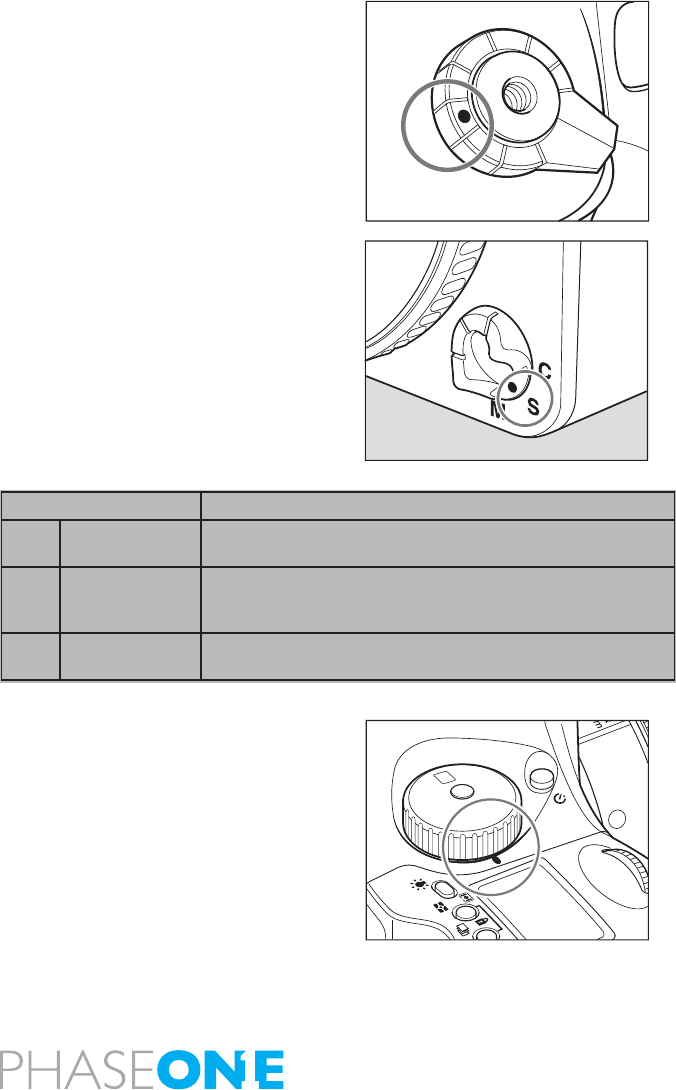
29
3.3 Getting started: Setting the Shutter Release, Focus, Exposure
and Metering modes
1. Set the Shutter Release mode selector lever to S (single-frame advance
mode).
There are two shutter release (drive) modes: S (single frame advance mode)
and C (continuous advance mode). When set to L the power is turned o.
2. Set the Focus mode selector lever to S (Single focus mode).
There are three Focus modes: S (single focus mode), C (Continuous focus
mode) and M (Manual focus mode). See page 33 for more information.
3. Set the exposure mode dial to P (Program auto exposure).
There are four exposure modes:
P (Program Auto Exposure)
Av (Aperture Priority AE)
Tv (Shutter Priority AE)
M (Manual)
N.B. Av stands for Aperture Value but is referred to as Aperture Priority AE.
Tv stand for Time Value but is referred to as Shutter Priority AE.
C
S
L
M .UP
Focus Mode Focusing
S Single focus
mode
Half-press the shutter release button to focus. When the focus mark
lights, the focus is xed and the shutter can be released.
C Continuous focus
mode
The camera keeps focusing continuously while the shutter release
button is half-pressed. The shutter can be released regardless of
whether or not the focus mark is lit.
M Manual focus
mode
Focus manually.
P
Av
Tv
M
X
CF
C1
C2
C3
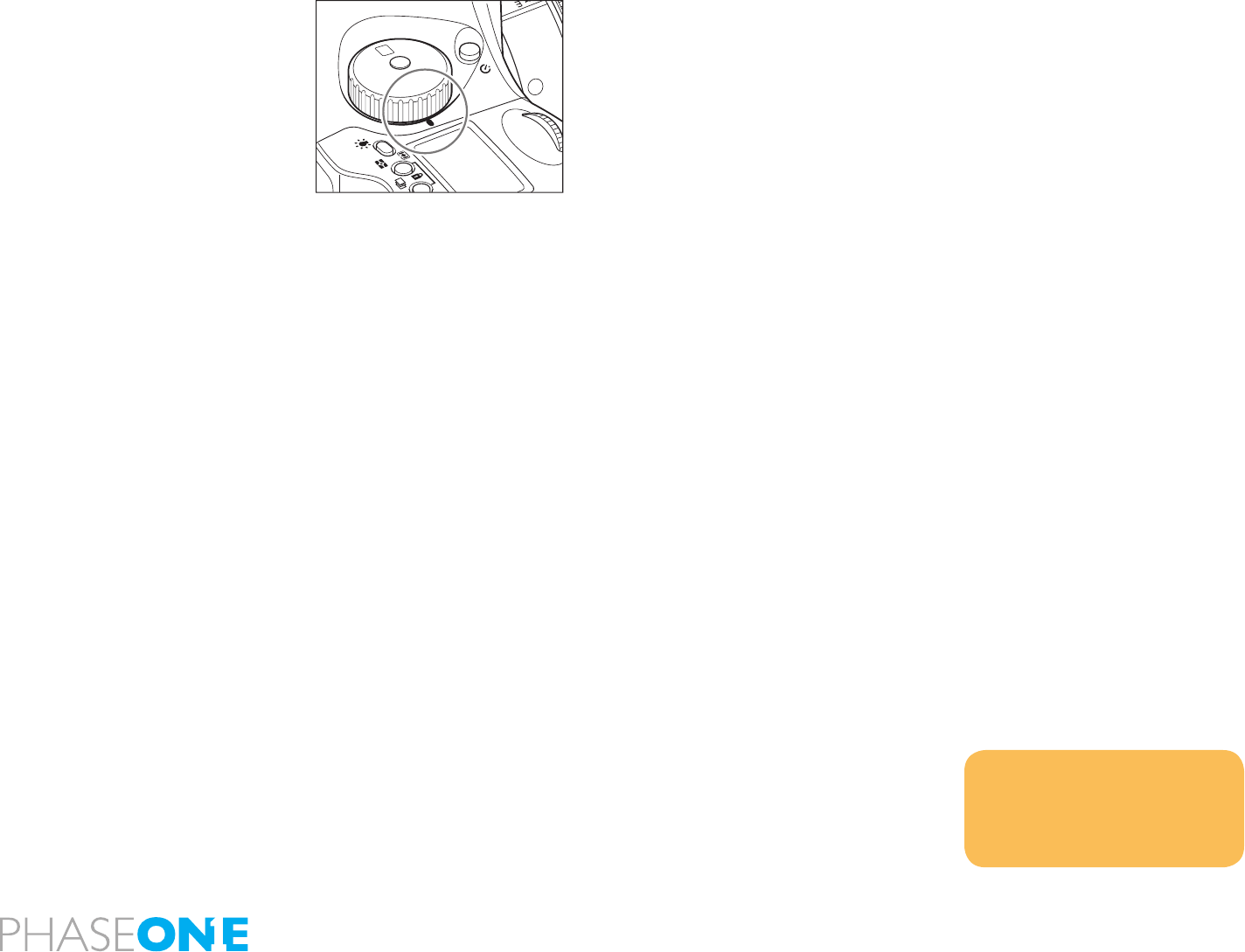
30
P: Program AE - The aperture and shutter speed are determined automatically
for the optimum exposure, according to the ambient light conditions. This auto
mode is best suited for general photography or for novice photographers, as
it leaves the user free to concentrate on framing and capturing the subject.
Av: Aperture priority AE - Set the desired aperture and the camera selects the
correct shutter speed. Use this mode to control depth of eld.
Tv: Shutter priority AE - Set the desired shutter speed and the camera selects
the correct aperture. Use this mode to stop motion.
M: Manual mode - Set this mode when you want to use special combinations
of the aperture and shutter speed.
4. Exposure metering mode is automatically set to average/spot exposure
metering before exposure metering is performed.
There are three exposure metering modes: In the A mode the average
brightness in the entire frame is measured with emphasis on the center
of the frame. The brightness at a specic spot in the center of the frame is
metered in the S mode. The A-S mode automatically switches between these
two modes depending on the contrasts in the picture.
NOTE:
When a polarizing lter is used, ensure that
a circular polarizing lter(C-PL) is used. The
correct exposure cannot be obtained with a
normal(linear) polarizing lter (PL).
P
Av
Tv
M
X
CF
C1
C2
C3
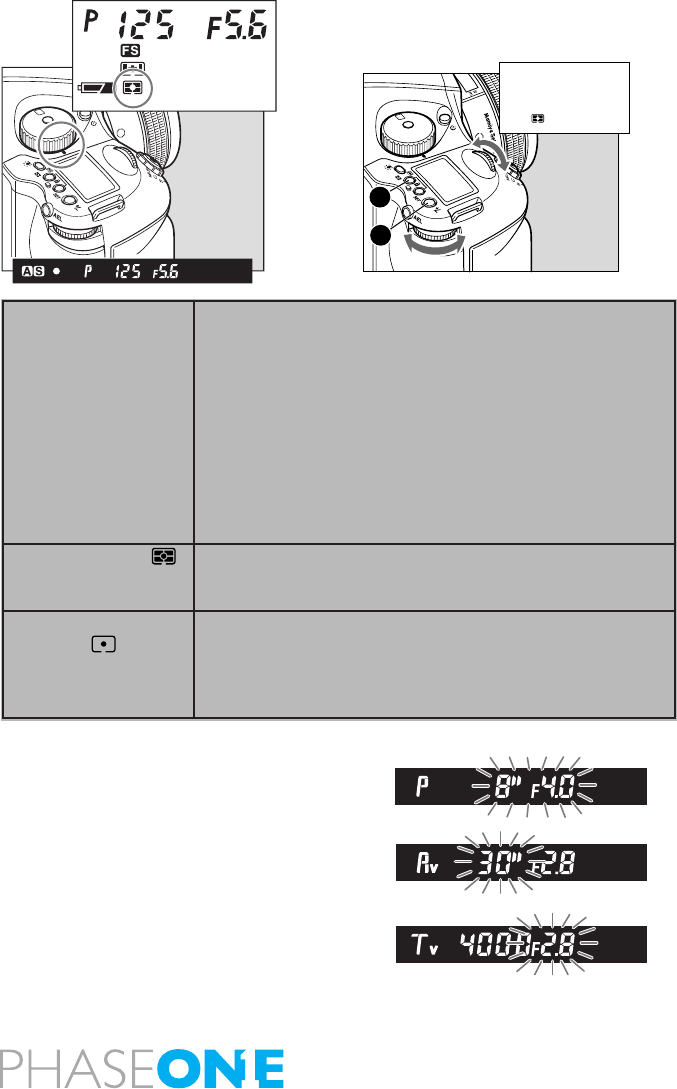
31
3.4 Measuring Light – Exposure Metering
1. Press button [A] to adjust the exposure metering mode. There are three
dierent exposure metering mode options that are displayed sequentially
when either the front or rear dial is turned. Select an appropriate exposure
mode. Your chosen exposure metering mode is displayed as an icon on the
camera’s LCD screen.
2. Press the SET button [B] or exposure metering mode button [A] to enter
the setting.
Exposure Warnings
Users are warned when shooting subjects that are too bright or too dark with
an inappropriate exposure setting. At such times, when the correct exposure
cannot be obtained, users will be alerted by the numeric exposure display
that will ash on the external LCD or on the display inside the viewnder.
Warnings that the exposure is outside the metering range
• Program AE (P)
The shutter speed and f-number blink.
• Aperture priority AE (Av)
The shutter speed blinks.
• Shutter priority AE (Tv)
The f-number blinks.
• Manual mode (M)
The exposure metering value dierence is displayed.
Average/spot auto
exposure metering
Exposure metering is performed after automatically selecting
average/spot exposure metering.• Depending on the subject
conditions, center-weighted average/spot exposure metering is
selected automatically, and the correct exposure is measured.
• Spot exposure metering is automatically selected when the
brightness of the spot exposure metering range becomes darker
than the brightness of the entire screen.
• If there is very little dierence between the spot exposure metering
value and center-weighted average exposure metering value, the
correct exposure level is obtained as the intermediate value.
Center-weighted
average/spot exposure
metering
The average brightness of the entire screen is measured,
emphasizing the center of the screen.
Center spot exposure
metering
The brightness of an area equivalent to 7.6% at screen center is
measured, and the exposure is determined. The circle at screen
center serves as a general guideline. This mode is suited to
measuring subjects with strong contrasts or measuring only screen
portions.
Viewer display
P
Av
Tv
M
X
CF
C1
C2
C3
P
Av
Tv
M
X
CF
C1
C2
C3
A
B
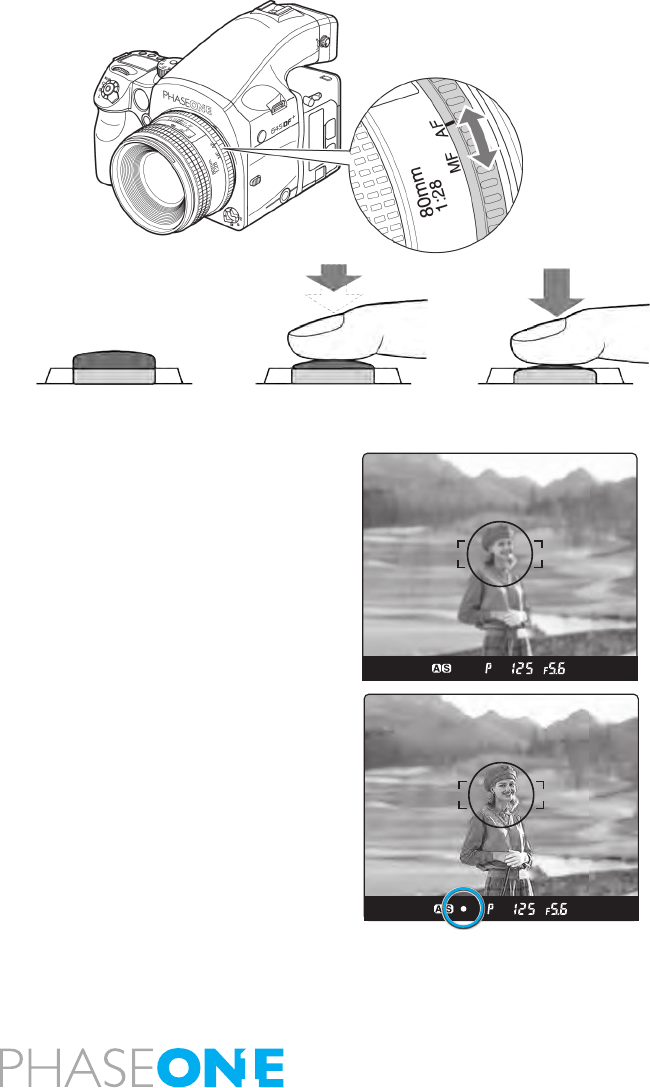
32
3.5 Focus Modes
To use the Auto Focus function, both the camera body and the lens have to
be set to their respective Auto Focus modes. Auto Focus does not function
when either the camera body or the lens are set to manual focus.
To activate Auto Focus (AF), rst select AF on the focusing selector ring on
the lens. Next, adjust the Focus Mode Selector Lever to either S (single) or C
(continuously) Auto focusing on the camera. The Focus selection ring on the
lens can help you to rapidly switch between AF and M, without having to
change your grip of the camera.
The shutter release button has a two-step action. When pressed lightly it stops
at a certain point. In this manual, this position is called the “half-press” position.
When you “half-press” this button, the camera functions are activated. When
the shutter button is pressed further down, the shutter is released. This position
is called the “full-press” position.
1. Aim the camera so that the subject is within the focus frame.
2. Half-press the shutter release button, and focus will be adjusted
automatically in AF mode. As default, you can now re-compose your image
without losing the original focus setting, by moving the camera and keeping
the shutter release button half-pressed. When the focus mark lights up, the
subject is in focus.
3. When the focus mark lights up, press the shutter release button further
down to release the shutter. (The focus mark is an illuminated dot (indicated
as this • symbol) at the bottom of the viewfinder display. See the focus the
illustration circled in blue).
Out of Focus Marks
When the picture is not focused the shutter cannot be released when in
single focus mode. Either press the shutter release button again to adjust the
focus or move the camera to change the position of the focus frame. Lenses
without the focus mode selector ring will automatically be set to AF if the
camera is set to Auto Focus. Do not touch the focus ring as you may cause
internal damage to the camera Auto Focus motor.
Lenses with the Focus Mode Selector
The focus modes can be switched between automatic and manual with the
selector on the lens when the focus mode selector lever on the camera body
is set to S or C.
Normal Half-press Release position
Full-press
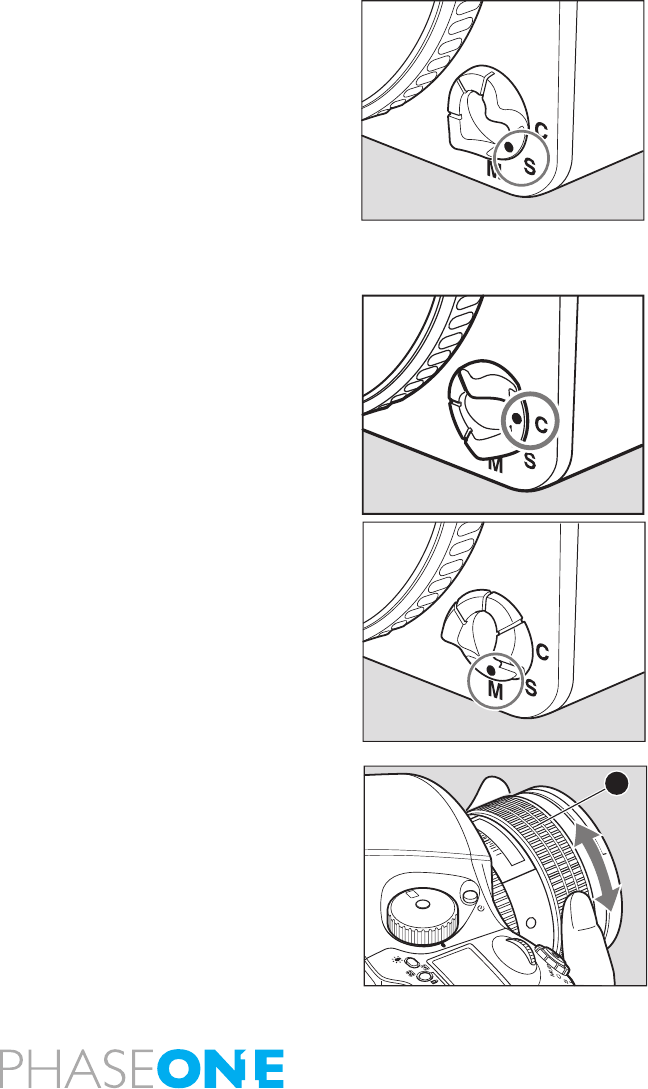
33
Single Focus Mode (S)
This mode uses the focus-priority mechanism. The shutter can be released
when the focus mark • in the viewnder is illuminated. This mode is suited
for still subjects. Focus is locked when the focus mark • is illuminated in the
viewnder’s LCD.
The shutter cannot be released if the subject is not in focus (if the focus
mark • does not illuminate).
To take another photo with a dierent composition, take your nger o the
shutter release button then re-press the shutter release button again.
Continuous Focus Mode (C)
In this mode shutter release has priority to focusing. The shutter can be
released regardless of whether the focus mark • in the viewnder’s display is
illuminated. Focus is adjusted continuously while the shutter release button
is half-pressed. This mode is suited for moving subjects.
Focus is not locked even if the focus mark is lit.
The shutter can be released even if the focus mark is not lit.
Manual Focus Mode (M)
To attain full manual control of the focus function you can change to manual
focus mode in two ways.
1. All lenses: Turn the focus mode selector lever to M (manual focus mode).
2. Manual Focus operation for telephoto and zoom lenses: All newer Phase
One, Mamiya and Schneider Kreutznach lenses can be switched from Auto
Focus to Manual Focus by using the AF ring or slider tted on the lens.
For lenses with AF slider, slide the focusing ring on the lens backward until
it clicks. When this is done, the Auto Focus inscription on the lens barrel is
covered and the lens can then be focused manually. For lenses with an AF ring,
simply rotate the AF ring to the MF position to select manual focus.
P
Av
Tv
M
X
CF
C1
C2
C3
22
25
2.25
0.7
0.8
ft
m
A
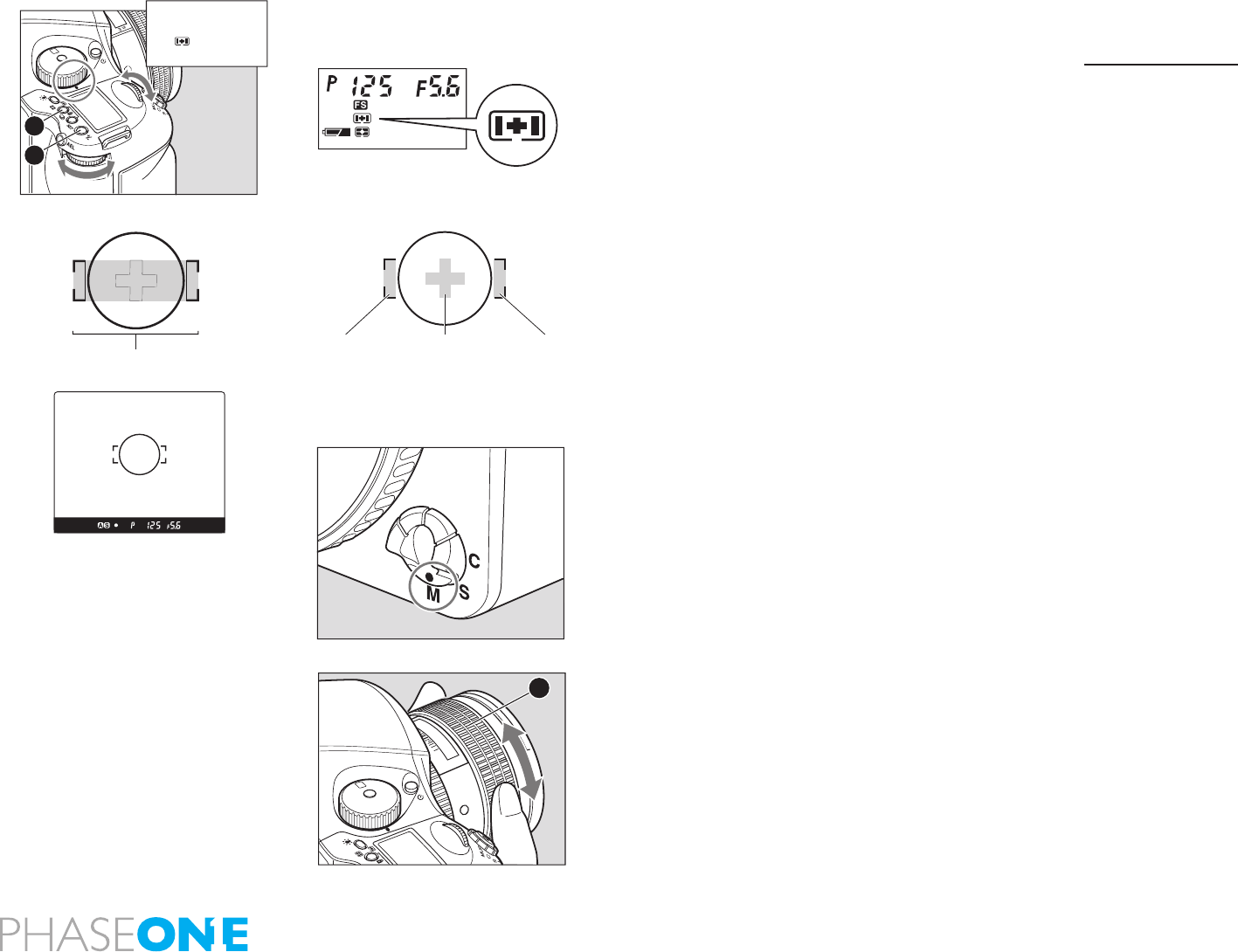
34
3.6 Focus Areas
You can select the focus area that best suits the kind of pictures you intend
to take. Push and hold the focus selection button [A] for at least one second;
then turn the front or rear dial to select the appropriate focus area. The
selected focus area can be seen on the main LCD panel. When the preferred
focus mark is selected, press the SET [B] button or the focus point selector
button [A] to exit the setting.
Multi Area Focus
When selecting multi area focus, the focus points are positioned in the
viewnder according to the illustration shown to the left.
If multiple objects are located within the focus frame, the camera will lock on
to the object closest to the camera.
Spot Focus Area
When spot focus is selected, the camera will lock on to objects positioned in
the center of the viewnder. The camera will focus on the center mark in the
focus frame [ O ] in the viewnder.
Manual Focus Mode (M)
To attain full manual control of the focus function you can change to manual
focus mode in two ways.
1. All lenses: Turn the focus mode selector lever to M (manual focus mode).
2. Manual Focus operation for telephoto and zoom lenses: All newer Phase
One, Mamiya and Schneider Kreutznach lenses can be switched from Auto
Focus to Manual Focus by using the AF ring or slider tted on the lens.
For lenses with AF slider, slide the focusing ring on the lens backward until
it clicks. When this is done, the Auto Focus inscription on the lens barrel is
covered and the lens can then be focused manually. For lenses with an AF ring,
simply rotate the AF ring to the MF position to select manual focus.
Adjust the Focus
Turn the lens focusing ring until the subject is in focus. When correct focus has
been achieved, the focus mark in the viewnder will light up.
Focus point selection mark
Left AF area Right AF area
Center AF area
Multi area focus Spot focus area
Inside the view-nder
P
Av
Tv
M
X
CF
C1
C2
C3
22
25
2.25
0.7
0.8
ft
m
A
P
Av
Tv
M
X
CF
C1
C2
C3
A
B
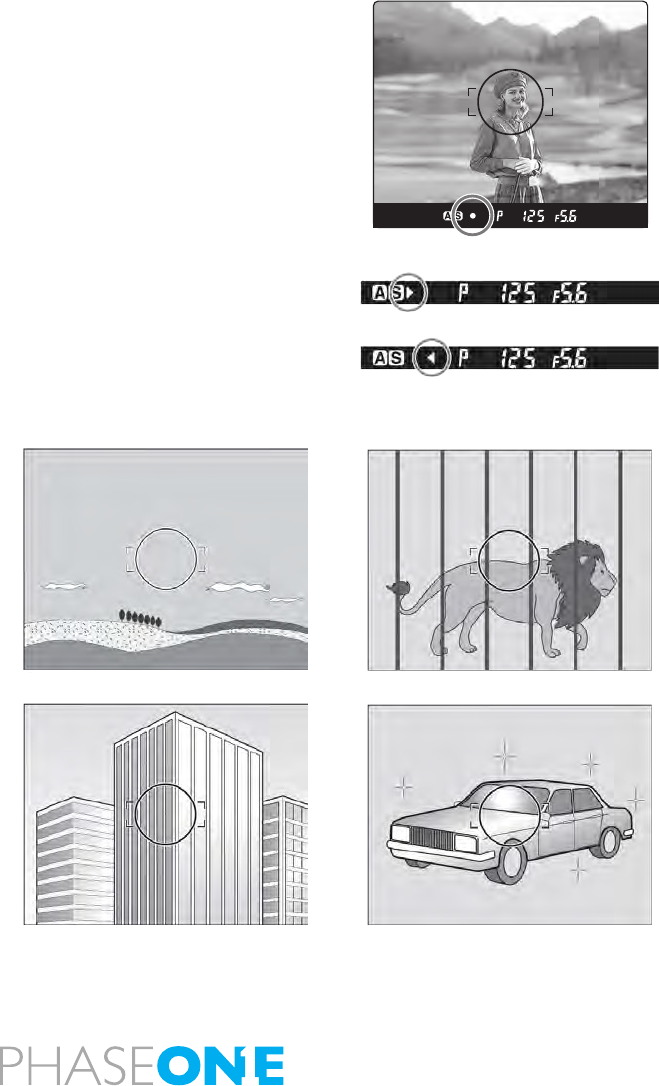
35
Manual Focusing using the Focus Mark (Focus conrmation method)
Half-press the shutter release button and turn the lens focusing ring to focus
on the subject. The focus mark is illuminated in the viewnder’s LCD to signal
that a picture is in focus.
If is lit in the viewnder’s LCD, the camera is focused on a point behind the
object.
If is lit, the camera is focused on a point in front of the object.
- Use the focus mark when taking photos in manual focus mode or when
using the M645 manual lens.
- If you adjust focus using the focus mark with an M645 lens, make sure to
open the aperture. You can use this function with the lens set to f/5.6 or
higher.
When Auto Focus Fails
The auto focus function requires contrast in the subject. Auto focusing may fail
to achieve focus with certain subjects described below. In such cases, either
switch to the manual focus mode (and focus manually) or focus on a more
contrast appropriate object at the same distance as the object you want to
photograph, lock the focus using the focus lock button on the front of the
camera body, then take a picture.
• Low-contrast subject (blue skies, white walls and other objects)
• Two or more objects overlapping at dierent distances within the focus
frame (animals in cages, etc.)
• Subjects with continuous repeated patterns (building exteriors, blinds, etc.)
• Extremely backlit reective subjects (car bodies, water surfaces, etc.)
• Or when the subject is far smaller than the focus frame
In focus
Turn focus ring clockwise
Turn focus ring counter clockwise
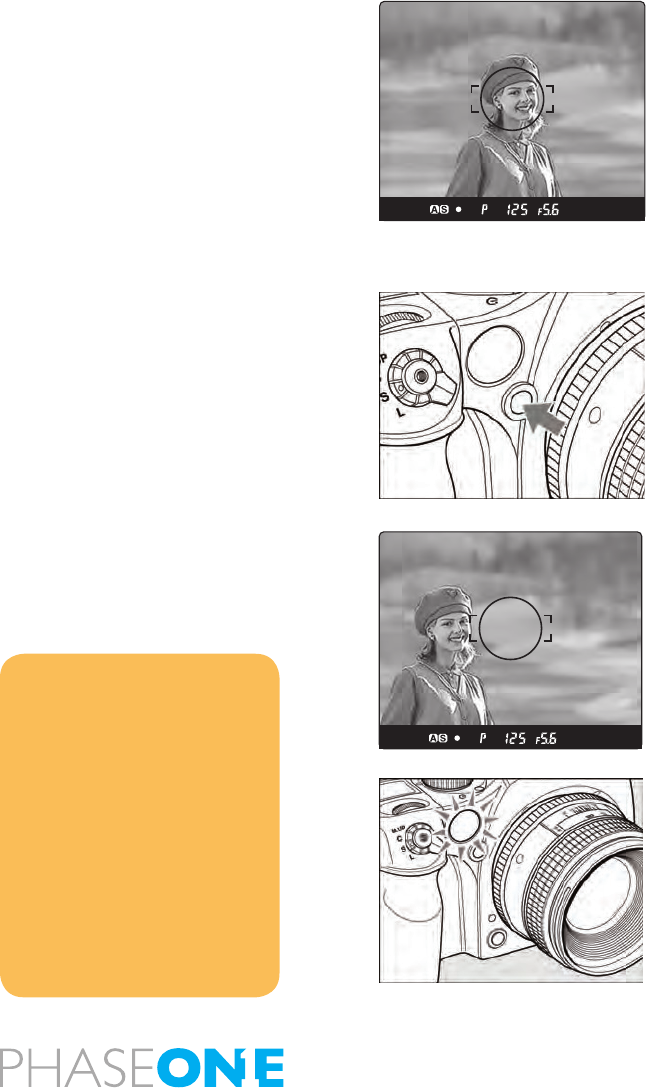
36
3.7 Using Focus Lock and Infrared Focusing
Use the focus lock when the your intended focus point is not within the focus
frame. In such cases where a subject is not located in the center of a frame,
use the focus lock function to lock the focus before releasing the shutter.
1. Set the focus mode selector lever to S or C.
Put the subject in the focus frame and half press the shutter release button.
2. Lock the Focus.
When the focus mark • in the viewnder LCD is lit, press the AF lock button
on the front of the camera to lock the focus.
3. Adjust the Composition.
With the shutter release button half-pressed, slide the camera to achieve the
desired composition, and release the shutter.
When the focus mode is set at S (single focus mode) and the focus mark • is lit,
hold the shutter release button halfway down to lock the focus.
AF Assist Infrared Light
Autofocus can fail when a subject is dark or very low-key. On these occasions,
a red lamp may be activated on the front of the camera when the shutter
release button is half-pressed to assist the camera’s auto focus function. The
AF assist infrared light is emitted only when the focus mode is set to S (single
focus mode).
Notice:
Eective range of the AF assist infrared
light is limited. It does not reach distant
subjects. - Range: 9m/29.5 ft. (using 80
mm f/2.8 lens)
Use of a lens hood or a bellows lens
hood (sold as an optional accessory)
may interfere with the assist light. It
is advisable to set the focus before
mounting the hood.
The AF assist infrared light can be
disabled.
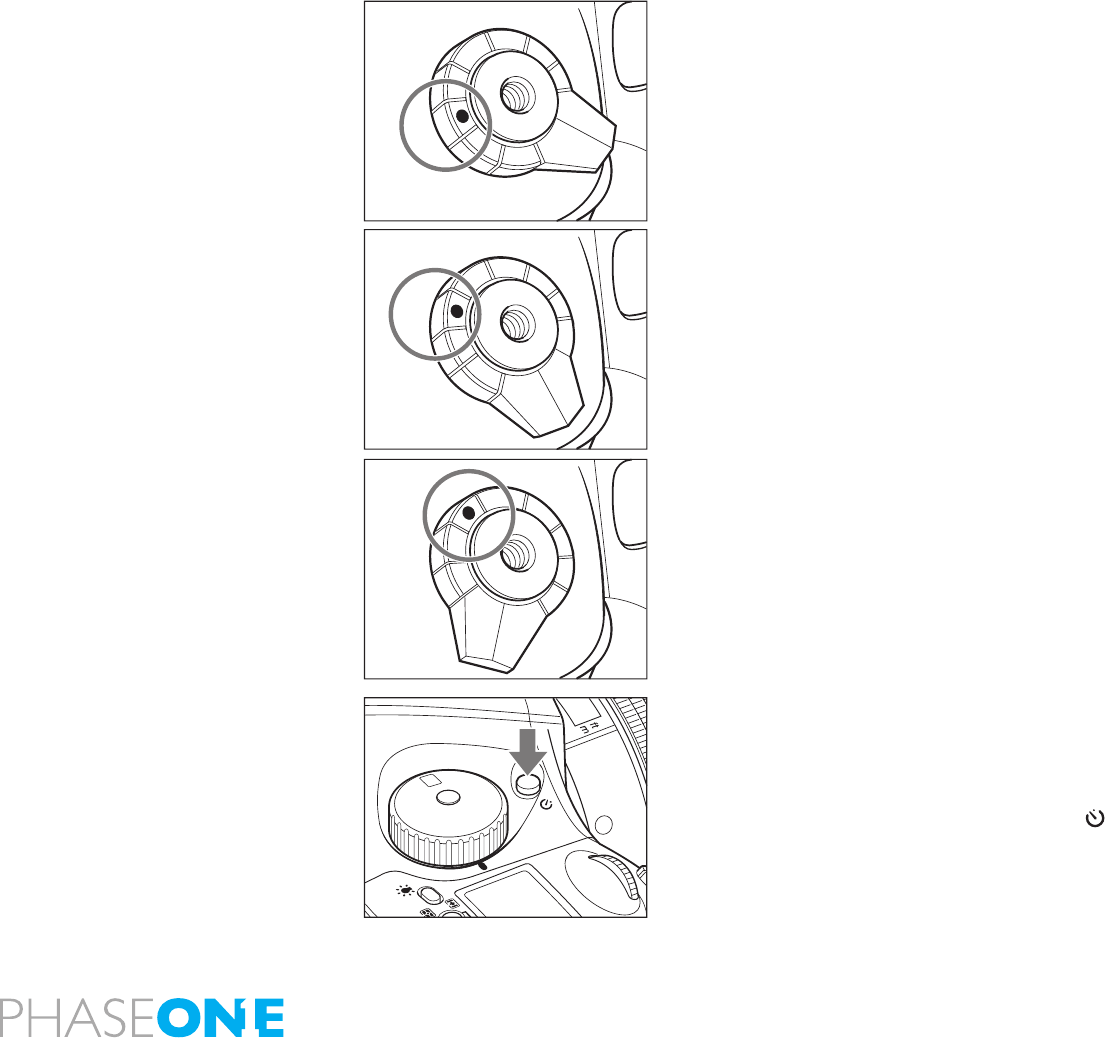
37
3.8 Drive Dial
Single-Frame Mode
One photograph is taken each time the shutter release button is pressed.
Set the shutter release mode selector to S.
Continuous Mode
Photographs are exposed as long as the shutter release button is pressed.
Set the shutter release mode selector lever to C. Photographs are taken
continuously at a rate depending on the buer speed of the digital back
mounted on the camera.
Mirror Up Mode
When the shutter button is pressed, the mirror moves up, and when the
shutter button is pressed again, the shutter is tripped and a picture is taken.
Self-Timer Mode
In this mode, the shutter will be released 10 seconds after the shutter release
button is pressed.
Activate the self-timer by pressing the button. Next, rotate the front dial
so that On is displayed in the camera’s LCD and press the shutter release.
When the shutter release is pressed, the self timer lamp will blink continuously
for 7 seconds, followed by 3 seconds of rapid blinking until the camera
releases the shutter.
C
S
L
M .UP
C
S
L
M .UP
C
S
L
M .UP
P
Av
Tv
M
X
CF
C1
C2
C3
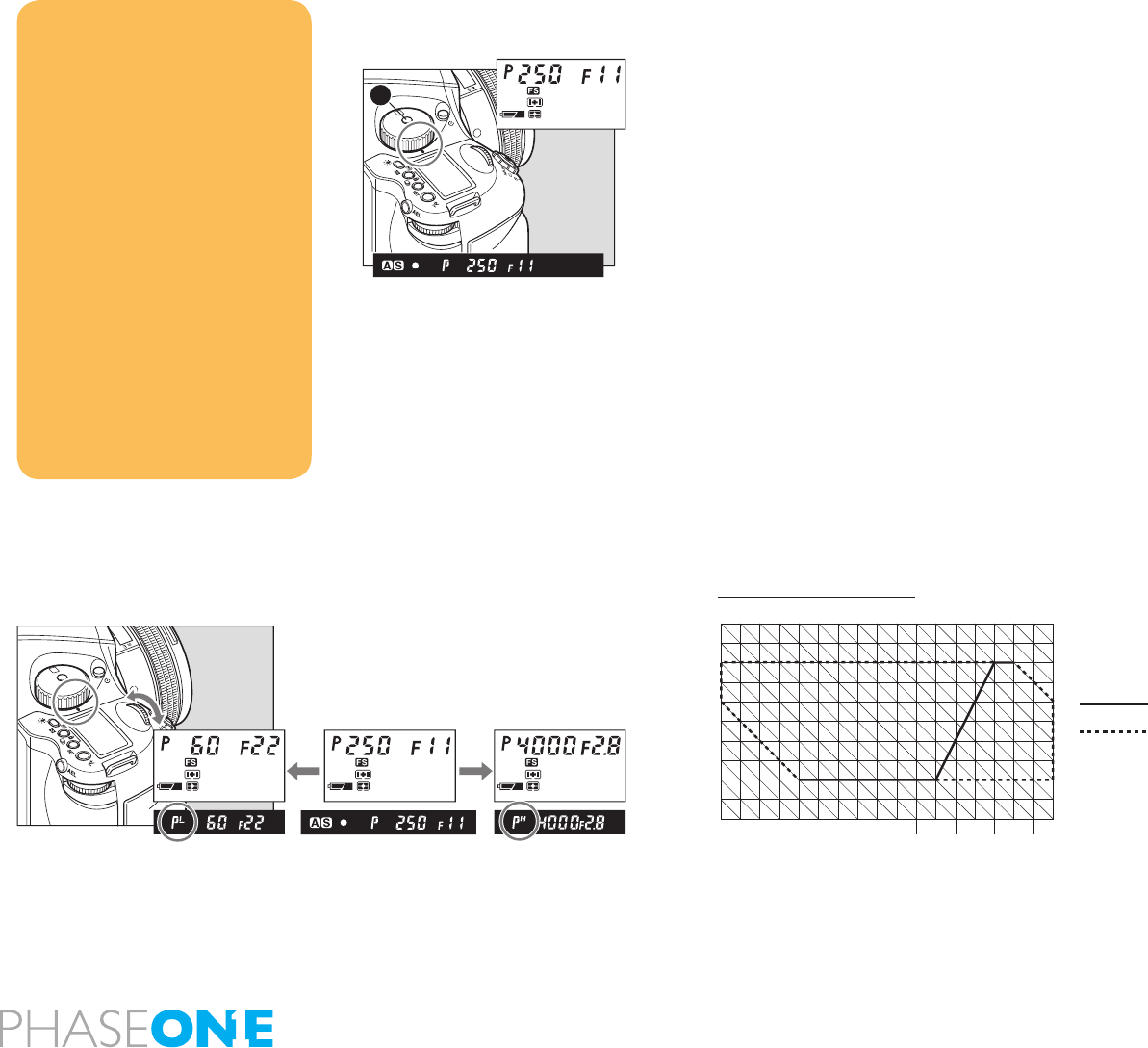
38
3.9 Exposure Modes
(P) Program AE
The aperture and shutter speed are determined automatically for the
optimum exposure, according to the ambient light conditions. This auto
mode is best suited for general photography or for novice photographers, as
it leaves the user free to concentrate on framing and capturing the subject.
Alter the shutter speed and aperture by turning the front and rear dials while
the “P” (Program AE) mode is selected.
Program Shift (PH/PL)
The shutter speed and aperture can be altered by turning the front and rear
dials while the P (Program AE) mode is selected. In order to avoid blurred
images (due to camera shake while releasing the shutter), or to open the
aperture, change to PH (high speed). For slower shutter speeds and wider
depth of eld, change to PL (low speed). This function allows these changes
to be made quickly.
NOTICE:
If a correct exposure cannot be obtained,
the shutter speed and aperture value blink.
In such cases, the pictures can be taken but
they may out too bright or too dark.
If the shutter speed and aperture values
blink on the main LCD and in the viewnder
display when the program line is shifted,
the proper exposure cannot be achieved.
Please select a dierent Program mode.
When the Program line is shifted, the
aperture value changes along with the
shutter speed to maintain the proper
exposure.
Increment of the aperture and shutter
speed can be set at either 1/3 or 1/2-stop.
P
Av
Tv
M
X
CF
C1
C2
C3
A
P
Av
Tv
M
X
CF
C1
C2
C3
5
4
3
2
1
0
-1
-2
-3
-4
30 15 8 4
2 1 1/2 1/4 1/ 8 1/15 1 /60 1/ 250 1/1000 1/ 4000
1/ 30 1/ 125 1/500 1/ 2000
6 7 8 9 10 11 12 13 14 15 16 17 18 19 20 21 22
EV
Shut ter speed
(ISO100/ A F8 0m m F2.8 D)
F
32
22
16
11
8
5.6
4
2.8
Phase One 645
program shift chart
Normal
Program shift area
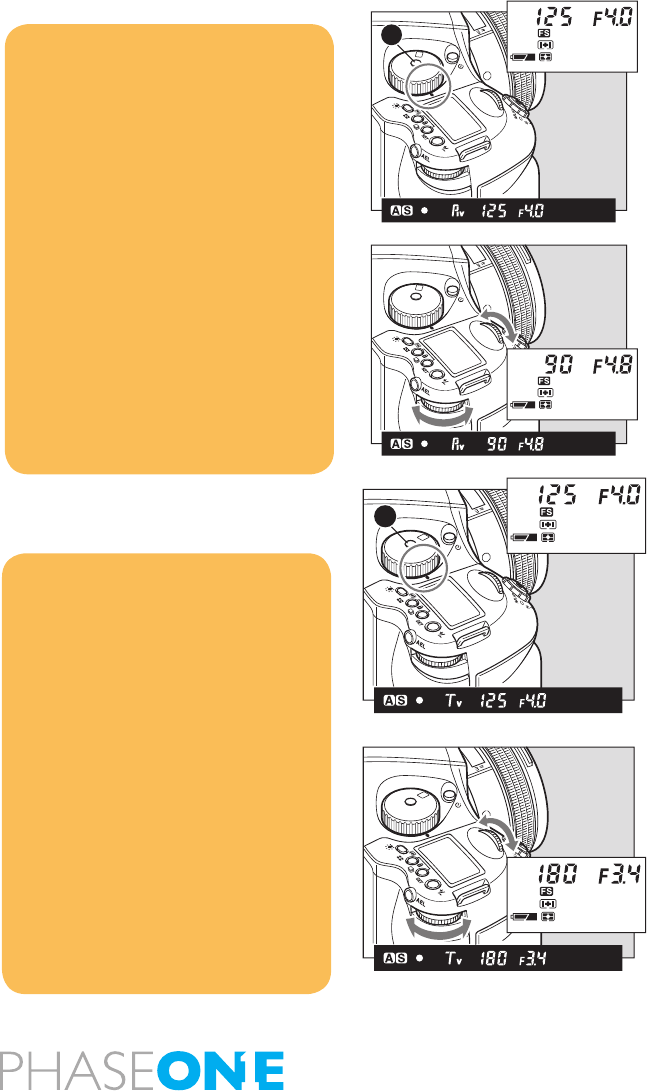
39
NOTICE:
The shutter speed value will blink when the
subject is too dark or too bright for a correct
exposure. To obtain the correct aperture, adjust
the aperture value until the shutter speed
value stops blinking and remains lit.
When the exposure is compensated with the
rear dial, the aperture can be set with the front
dial only.
Increment of the aperture can be set at either
1/3 or 1/2-stop.
Rotation direction of the dials to change the
values can be altered.
The selected aperture level can be locked.
NOTICE:
The aperture value will blink when the subject
is too dark or too bright for a correct exposure.
To obtain the correct aperture, adjust the
shutter speed value until the aperture value
stops blinking and remains lit.
When the exposure is compensated with the
rear dial , the shutter speed can be set with the
front dial only.
Increment of the shutter speed can be set at
either 1/3 or 1/2-stop.
Rotation direction of the dials to change the
values can be altered.
The selected shutter speed can be locked.
Aperture Priority AE (Av)
Set the desired aperture, and the camera selects the optimum shutter speed
accordingly. Use the Av mode to maintain specic control over depth of eld,
1. Turn the exposure mode setting dial to “Av” (aperture-priority AE) position.
2. Turn the front or rear dial to set the desired aperture.
- Swap from a leafshutter lens to focal plane shutter if a shutter speed above
1/800 second is need.
Shutter Priority AE (Tv)
Set the desired shutter speed and the camera selects the optimum aperture
accordingly. A fast shutter speed can be used to freeze motion and slow
shutter speed can be used to create motion blur.
1. Turn the exposure mode setting dial to “Tv” (shutter-priority AE) position.
2. Turn the front or rear dial to set the desired shutter speed.
- Swap from a leafshutter lens to focal plane shutter if a shutter speed above
1/800 second is need.
P
Av
Tv
M
X
CF
C1
C2
C3
A
P
Av
Tv
M
X
CF
C1
C2
C3
P
Av
Tv
M
X
CF
C1
C2
C3
A
P
Av
Tv
M
X
CF
C1
C2
C3
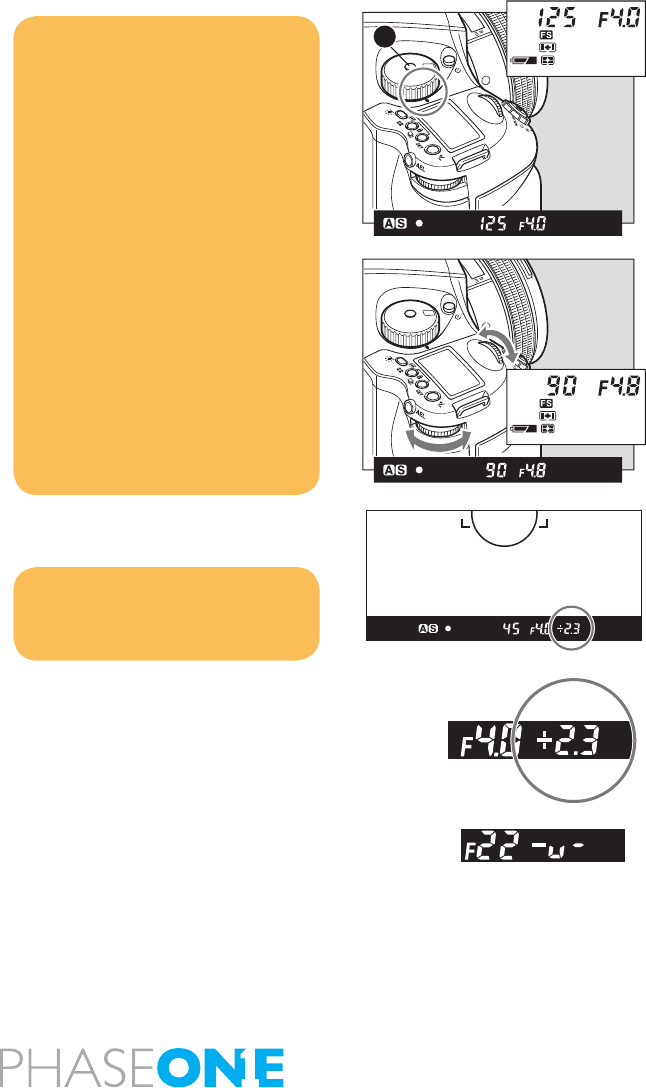
40
NOTICE:
When the exposure is compensated in the
Manual mode, the dierence between the
metered value and the compensated value
will be displayed on the viewnder LCD. In
the B (Bulb) mode, the dierence with the
metered value is not displayed.
Increment of the aperture and shutter
speed value can be set at either 1/3 or
1/2-stop.
The assignments of the front and rear dials
can be swapped.
Rotation direction of the dials to change the
values can be altered.
The selected aperture and shutter speed
can be locked.
NOTICE:
When the set value matches with the
metered value, the dierence indicator will
show “0.0”.
Manual Mode (M)
This mode is used to set both the aperture and shutter speed for total
exposure control. Varying shutter speeds can be selected, including “bulb”,
“tIME” and manually from 60 mins to 1/4000 sec. Aperture values can be set
from maximum to minimum aperture.
1. Turn the exposure mode setting dial to “M” (Manual) position.
2. Turn the rear dial to set the desired aperture.
3. Turn the front dial to set the desired shutter speed.
4. When the shutter release button is half pressed, the dierence between
the present settings and the metered value is displayed in the viewnder’s
LCD panel. The value is displayed in 1/3 stop increments within a range of
±6 EV.
When the dierence between the set value and the metered value is greater
than ±6EV and the set value is lower than the metered value, the indicator in
the viewnder LCD shows “– u –.” Contrarily when the set value is higher than
the metered value, the indicator shows “– o –.”
P
Av
Tv
M
X
CF
C1
C2
C3
A
P
Av
Tv
M
X
CF
C1
C2
C3
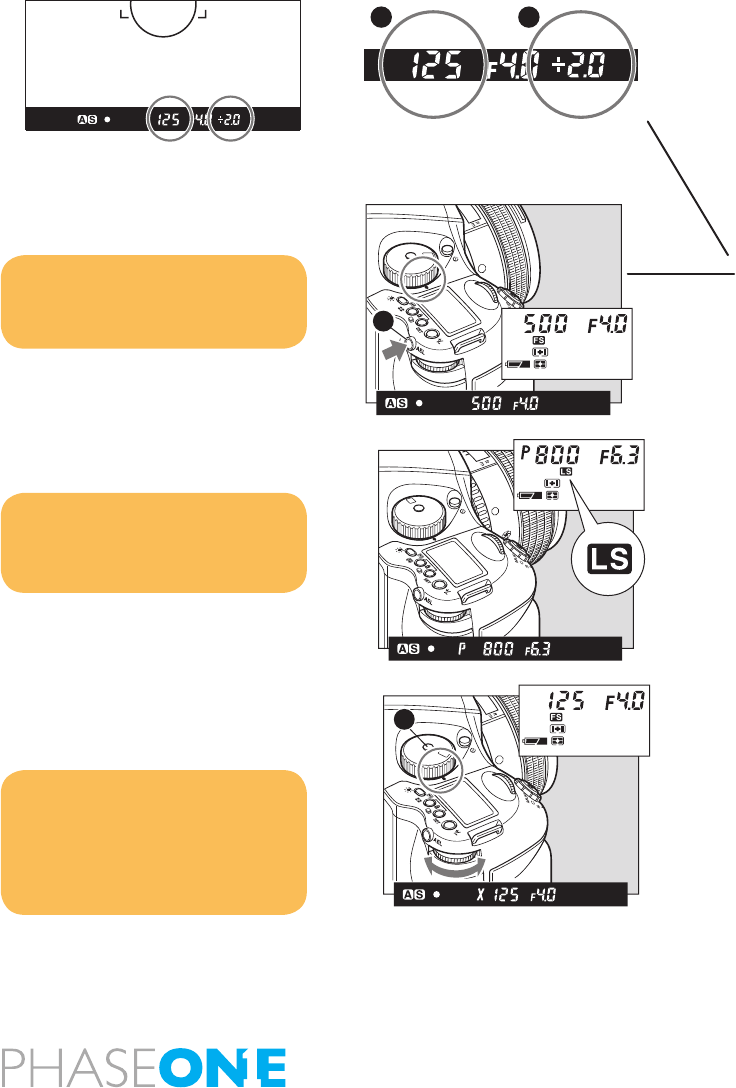
41
One-push Shift Function
When the dierence between the set value and metered value is displayed on
the viewnder LCD in the Manual “M” mode, press the AEL button for approx. 1
second and the camera will automatically adjust the shutter speed to achieve
the correct exposure based on the set aperture value.
While the dierence[B] between the set value[A] and the metered value is
displayed on the viewnder LCD, press the AEL button[C] for approximately
one second. The camera changes the shutter speed to an appropriate level.
Auto Mode Mechanism
A leaf shutter’s working range is from 1/800 sec. to 1 second. To achieve
other speeds (1/4000-1/800 sec., 1-60sec.., bulb) use the focal plane shutter.
Synchro Mode (X)
Select this mode when a ash is used. Choose “X” and the shutter speed will
be xed at 1/125 second for synchronization.
NOTICE:
The aperture level can be selected for the
parameter to shift.
NOTICE:
Photography using the leaf shutter or focal
plane shutter can be selected in customs
settings
NOTICE:
The selected aperture value can be locked.
When 1/800 sec. shutter speeds can not be
achieved even though the leaf shutter lens
is attached, try another exposure mode.
A B
P
Av
Tv
M
X
CF
C1
C2
C3
C
P
Tv
Av
M
X
CF
C1
C2
C3
A
P
Av
Tv
M
X
CF
C1
C2
C3
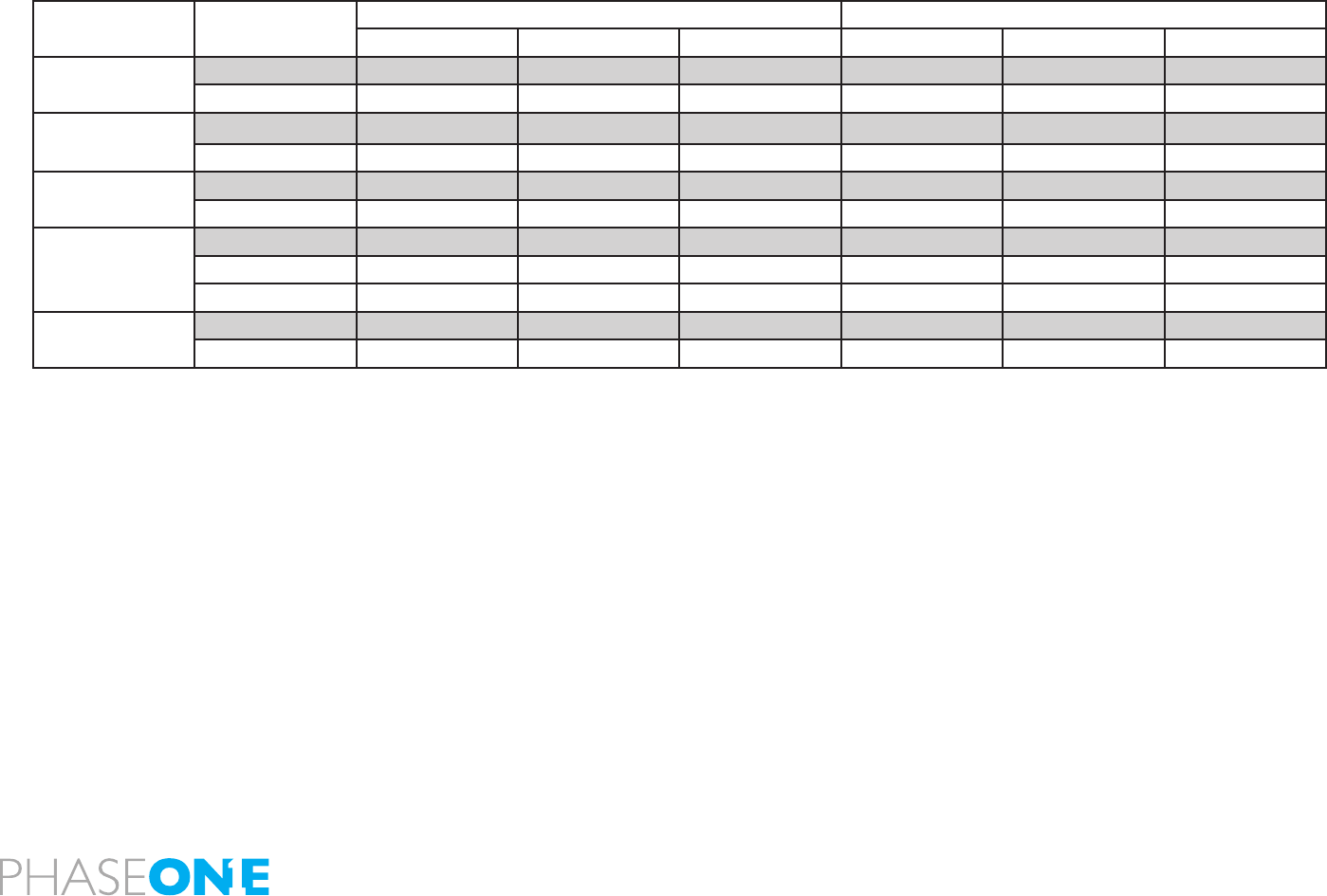
42
Exposure Mode Lens Mode Shutter speed X-Sync
1/4000-1/800 1/800-1S 1S - 30S+ 1/4000 - 1/800 1/800 - 1S 1s - 30S+
Program Leaf Shutter — LS — — LS —
Focal Shutter FS FS FS — 1/90 - 1S —
Tv Leaf Shutter — LS — — LS —
Focal Shutter FS FS FS — 1/90 - 1S FS
Av Leaf Shutter — LS — — LS —
Focal Shutter FS FS FS — 1/90 - 1S —
Manual Leaf Shutter — LS — — LS —
Focal Shutter FS FS FS — 1/90 - 1S FS
Auto FS LS FS — LS FS
X(*) Leaf Shutter — 1/125,90,60 — — 1/125,90,60 FS
Focal Shutter — 1/125,90,60 — — 1/125,90,60 —
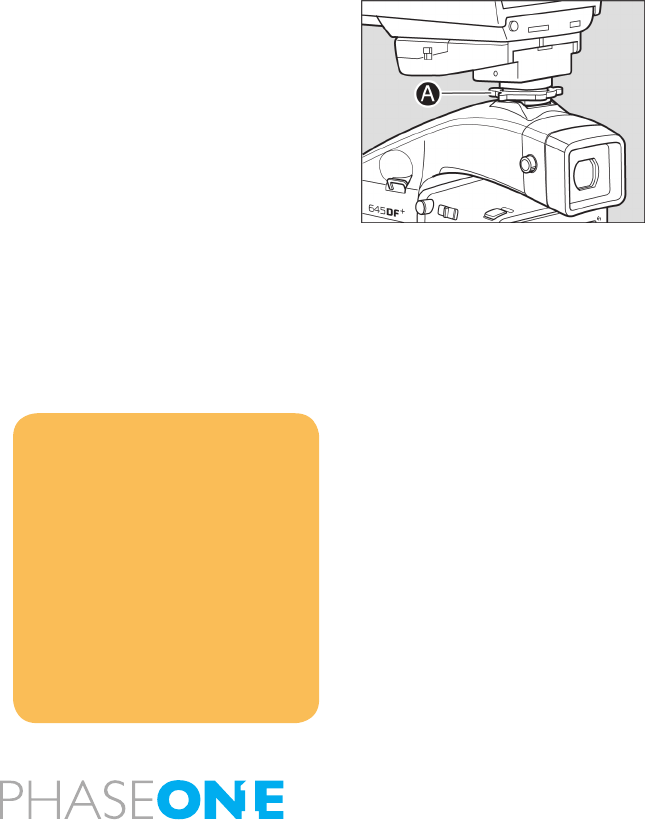
43
3.10 Flash Photography
The Phase One 645DF+ is equipped with a horizontal focal-plane metal
shutter and it is also compatible with leaf shutter lenses.
The focal-plane shutter provides higher shutter speeds than that of leaf
(central) shutter lenses. Focal-plane shutters allow you to shoot fast enough
to freeze moving subject matter. Leaf shutter lenses will allow faster shutter
synchronization to ash, making it ideal to freeze subject movement when
using strobe lighting.
The focal-plane shutter method allows for shutter speeds of up to 1/4000
sec. When shooting at higher speeds e.g. 1/500 sec. the two shutter blades
are moving in parallel creating a small slit allowing a small fraction of light to
reach the sensor area of the digital back. When using this type of shutter it is
not possible to achieve ash synchronization greater than 1/125 sec.
A leaf shutter will make it possible to achieve faster shutter and ash sync
speeds. An IQ Series back can achieve a maximum shutter speed of 1/1600
second. Do not use leaf shutter speeds above 1/1600 sec.
1. A grip type ashgun or a strobe (with electric contacts other than X
contact) can be operated with the Phase One 645DF+ by connecting a sync
cord into the camera’s sync terminal. (See the note in the bottom left corner
of the page about ash units designed exclusively for other camera makes.)
2. Turn the exposure mode setting dial to “X” (1/125 sec.) or M (manual).
When M (manual) is selected, turn the front dial and set the shutter speed to
1/125 sec. or slower.
3. Turn the rear dial to set the aperture, and then press the shutter button to
take a picture.
In addition to its standard ash sync system, the Phase One 645DF+ features
TTL (through the lens), o the lm (OTF) and electronic ash exposure
metering.
NOTICE:
This camera’s synchro contact is an X
contact.
Using ashes designed exclusively for other
camera manufacturers in the hot shoe may
damage the camera’s internal mechanisms.
In this situation, use an o-camera ash
bracket and connect a sync cord to the
camera’s synchro terminal.
When using ashes with a ash duration of
1/500 sec. or longer, set the shutter speed
to 1/30 sec. or less.
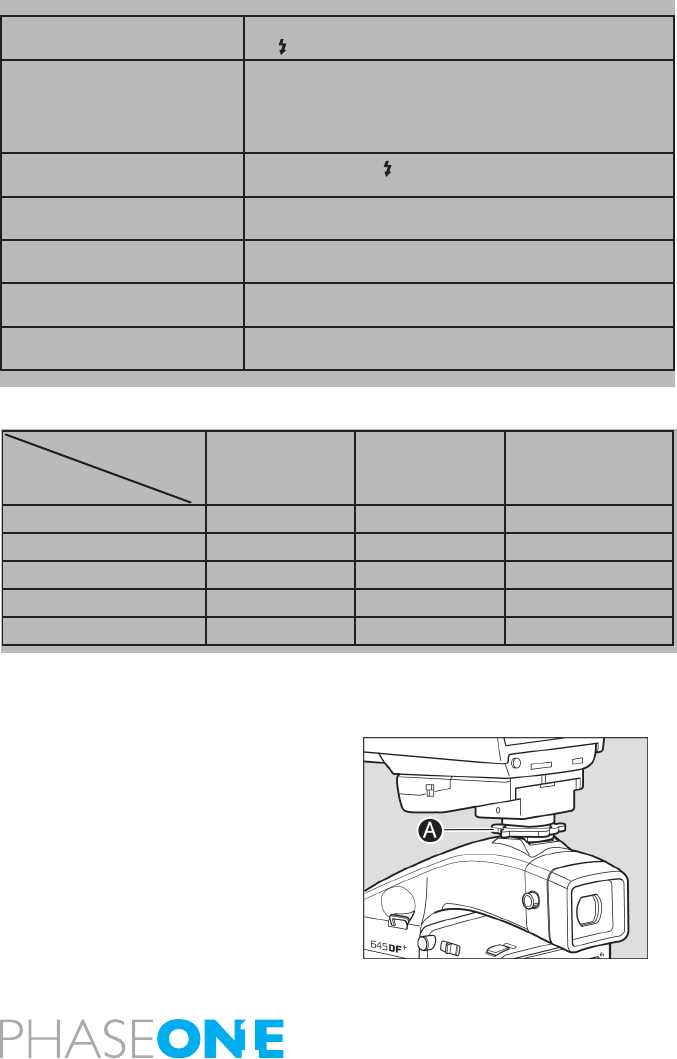
44
Phase One 645DF+ features TTL (Through The Lens), OTF (O The Film) and
electronic ash exposure metering. A ash sensor located inside the camera
body reads the ash light reected o the surface of the CCD at the moment
of exposure. The sensor is connected via the Phase One 645DF+’s dedicated
hot-shoe to a shoe or handle-mount style Metz ash unit via the Metz SCA
3952 TTL Adapter. Maximum ash speed is 1/125 sec. when the focal plane
shutter is used, making daytime synchronization possible.
The ISO of the ash is automatically set through the TTL connection from the
camera’s lm magazine; any adjustment to this is instantly recognized after
the setting is locked and the shutter release is half-pressed.
To utilize the TTL ash feature with all TTL-operable Metz ash units, a Metz
SCA 3952 module is required. Please see the chart for capability and/or
additional adapters that may be necessary.
The resulting ash exposure automation determines correct ash exposure
and automatically adjusts the output of the ash. It also automatically
corrects for exposure compensation normally required when using lters,
close-up bellows or extension tubes.
1. Mount the SCA3952 adapter onto the Metz ash, insert fully into the
camera’s hot shoe, and then tighten with the locking knob[A].
2. Set the exposure mode, and then check the shutter speed and aperture.
Type of ash SCA3952 Module Converter
Metz 44 MZ-2 shoe-mount x
Metz 54 MZ-3 shoe-mount x
Metz 45 CL-3 & 4 Digital Handle-mount x SCA 3045
Metz 60 CT-4 Handle-mount x SCA 3000
Metz 70 MZ-5 & 4 Handle-mount x
Adapter
Metz Flash Unit
For more info on Metz, contact the local Metz dealer or www.metz.de
Charging completed indicator in
viewnder
When charging of the ash is completed, a charging completed ash
icon will illuminate in the viewnders display panel
Automatic setting of ash
synchronizing speed
When exposure mode is set at “AV”or “P”, the shutter speed will be
automatically set to 1/60 to 1/125 sec. when charging of the ash is
completed.
When exposure mode is at “TV” or “M” and the shutter speed is faster
than 1/125 sec., the shutter speed will be automatically set to 1/125 sec.
Flash conrmation The ash charge mark ashes after the shutter is released to indicate
that the ash was emitted properly
Auto zoom control The power zoom reector is linked to the lens focal length
(excluding the Metz 32Z-2)
Auto AF assist beam When the focus mode is set to “S”, the autofocus assist beam is emitted
automatically in low light. (excluding the Metz 32Z-2)
Display of ash range (distance) Displayed on the ash’s liquid crystal display panel. (Metz 32MZ-3 and
Metz 32Z-2)
Data transfer The lm sensitivity data, exposure compensation data and aperture
data are sent from the camera to the ash.
Metz 3952 functions
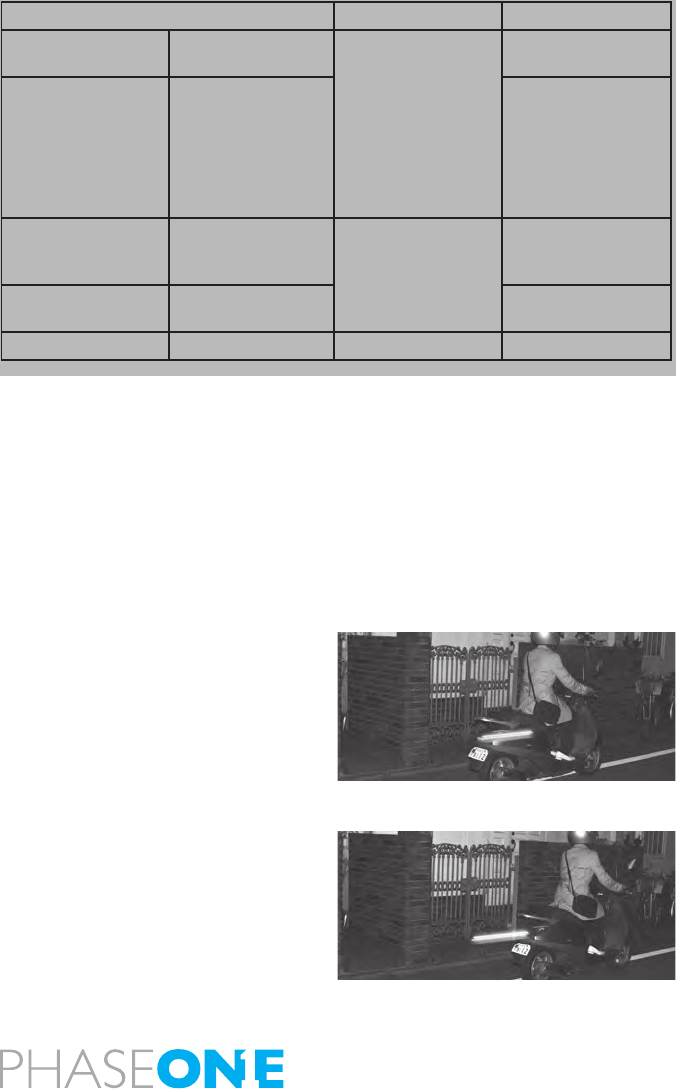
45
TTL ash
With TTL ash photography, the reection of the ash is metered and the
intensity of the ash is adjusted automatically, which can mean TTL ash
photography may not be suitable for all shooting conditions. In the cases
described below, we recommend that you use a ashmeter to check the
intensity of the ash or to use a manual ash setting.
Example:
1. When the size of the subject you want to light with the ash is relatively
small within the picture
2. When the background behind the subject is extremely bright or when
there is a strongly reective object in the background
3. When the background behind the subject is extremely dark (outdoors at
night, etc.)
4. For ash photography with a narrow lm latitude
Curtain Syncro
When a moving subject has been shot under this function, the ash of light
appears after the moving subject.
Rear curtain sync mode
Front curtain sync mode
This function is set by Custom function setting. Go to page 81 for more
information.
Exposure mode Shutter speed Aperture
P Program AE Automatically set by
camera to 1/60 sec.
when the metered
shutter speed is 1/60
or slower, and 1/125
when it is 1/125 sec. or
faster.
Automatically set by
camera
Av Aperture priority AE Any aperture
Tv Shutter priority AE Automatically set by
camera to 1/125 when
the set shutter speed
is 1/125 sec. or faster.
Automatically set by
camera
M Manual mode Any aperture
X Synchro mode 1/125 sec. or via CF Any aperture
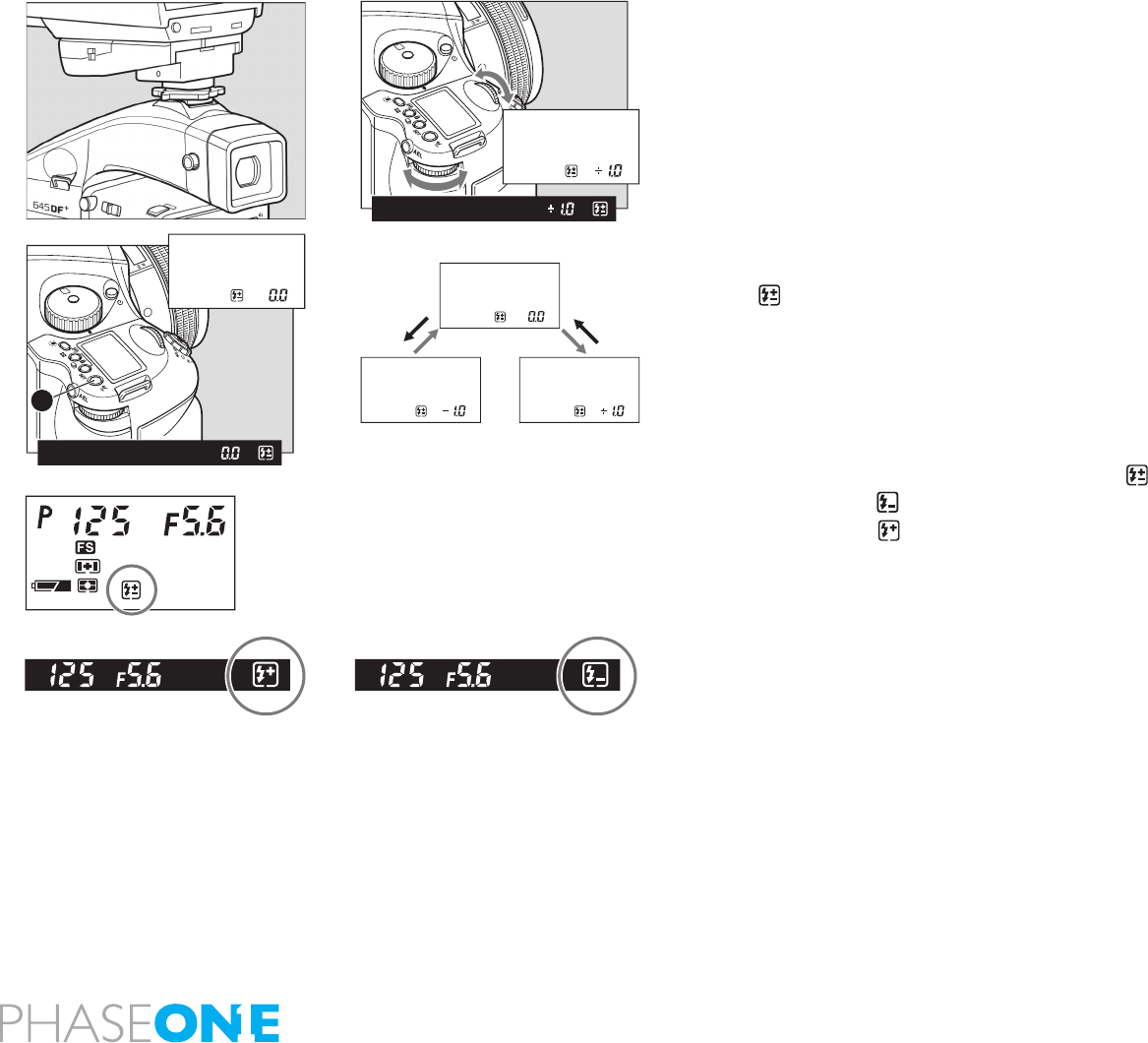
46
3.11 Flash Compensation Settings
By combining a Metz ash and the SCA3952 adapter, the camera adjusts for
ash. It can be adjusted within ±3EV in increments of 1/3 steps.
1. Turn on the Power
Install the SCA3952 adapter on the Metz ash, and attach it to the camera.
Lock the ash in place using the locking knob on the ash shoe. Turn the
shutter release mode selector lever to the S or C position, and turn ON the
ash power switch.
2. When the ash charge conrmation lamp lights, press the set button [A] .
The icon is displayed on the main LCD panel.
3. Turn the front or rear dial to select the ash compensation value.
External LCD Panel (normal display)
4. When the shutter button is half-pressed, the display appears on the
external LCD, and appears on the LCD inside the viewnder with a +
compensation, or appears with a – compensation.
Viewnder LCD Readouts
- If the ash-charge mark is not displayed, the ash compensation button [A]
cannot be used.
- Keep pressing the set button to activate the ash compensation mode. You
can check the exposure compensation value.
- If you turn the shutter release mode selector lever to the L (power OFF)
position, the compensation value will be cancelled.
P
Av
Tv
M
X
CF
C1
C2
C3
A
P
Av
Tv
M
X
CF
C1
C2
C3
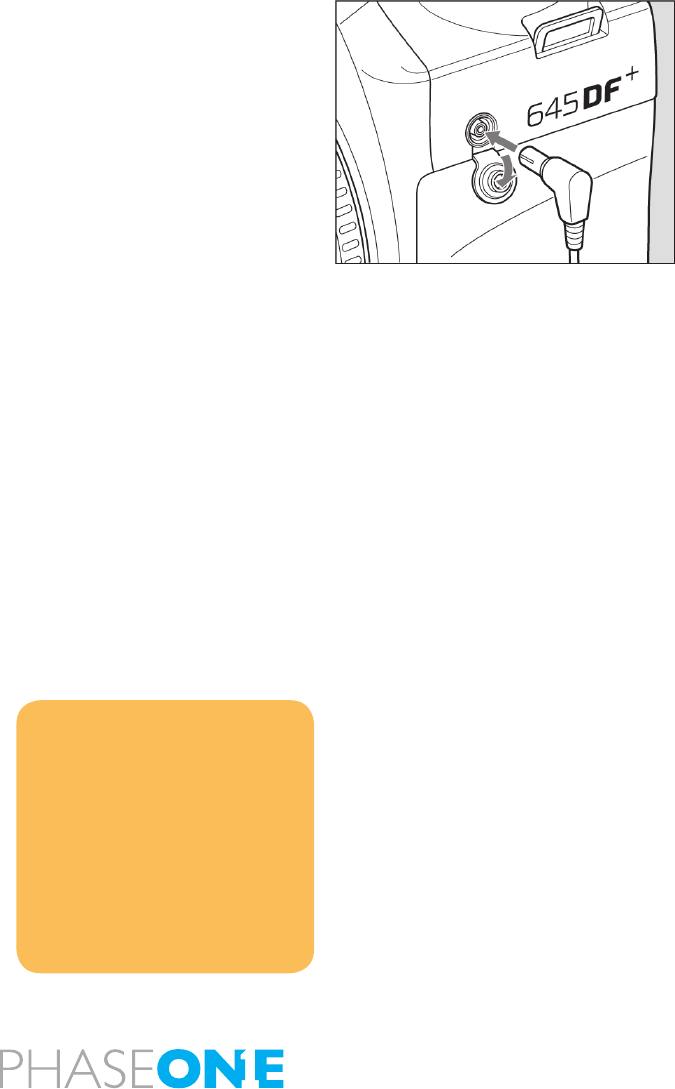
47
Flash Photography with Electronic Flash Models other than Metz units
1. To use a grip type ashgun or a strobe with other electric contacts than X
contact, connect the sync cord to the camera’s sync terminal.
(See note below about ashes designed exclusively for other makers’
cameras.)
2. While pressing the unlock button, turn the exposure mode setting dial and
set it to X (1/125 sec.) or M (manual).
When M (manual) is selected, turn the front dial and set the shutter speed
1/60 to 1/125 sec. or slower.
3. Turn the rear dial to set the aperture, then take the picture. (for M, use the
rear dial. For X, use the front dial).
This camera’s synchro contact is an X contact.
NOTICE:
Using ashes designed exclusively for
other makers’ cameras may
damage the camera’s internal mechanisms
if connected to the
camera's hot-shoe. In this situation, use an
o-camera ash bracket
and connect a sync cord to the camera's
synchro terminal.
- When using ashes with a ash duration of
1/500 sec. or longer, set
the shutter speed to 1/30 sec. or less.
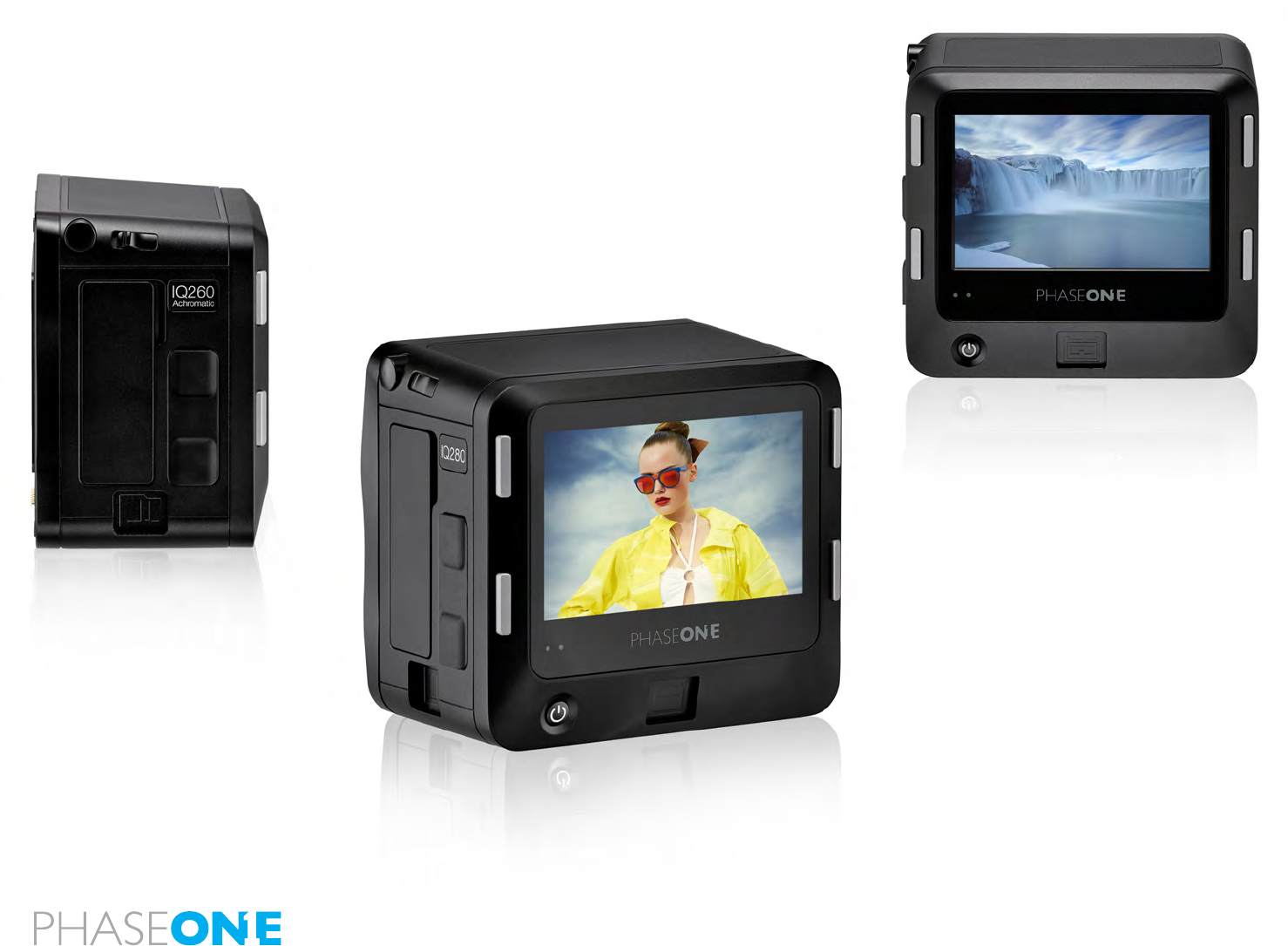
48
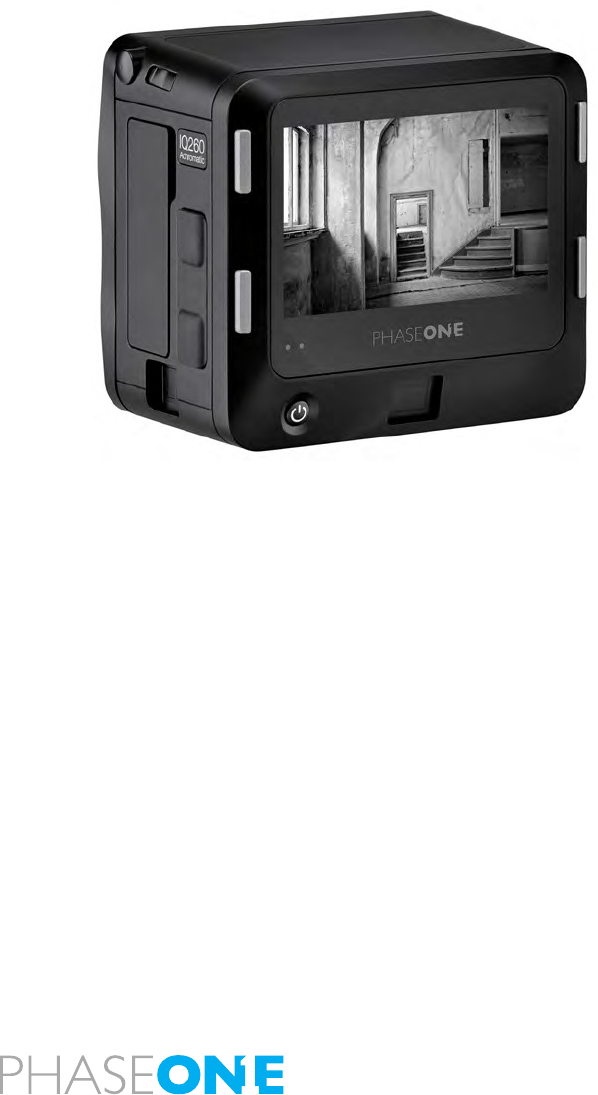
49
4.0 Introduction to the IQ2 Series Digital Back
System Overview
The Phase One IQ2 Series Digital Back is designed to t on the Phase One
645DF+ as well as several other brands or models of medium format cameras.
The IQ2 Series include three dierent models; the IQ280, IQ260 and the
IQ260 Achromatic. The backs incorporate 80 and 60-megapixel sensors for
the IQ280 and two IQ260 models repectively. They also feature USB3 and
FireWire 800 connections facilitating the fastest possible tethered image
transfers speeds. All three models have a 3.2 inch touch display that features
1.15 megapixel resolution. The wide format display allows for a full 4:3 aspect
ratio VGA resolution image next to histogram, highlight warning, focus mask,
File Info, and touch controls. This touch screen display is complemented by
Phase One’s intuitive 4-button navigation.
Phase One’s patent-pending Sensor+ technology, built into the Phase One
IQ2 Series models, supports a variety of shooting conditions. Images can
be captured at full resolution or, using Sensor+ mode, switch instantly to
capture images with 20 megapixels* resolution at 4 times higher sensitivity,
up to ISO 3200.
The following section deals with generic features that are available in all
three IQ2 Series digital back models.
* The IQ280 produces 20 megapixel resolution and both the IQ260 and IQ260 Achro-
matic produce 15 megapixel resolution when the Sensor + mode is activated.
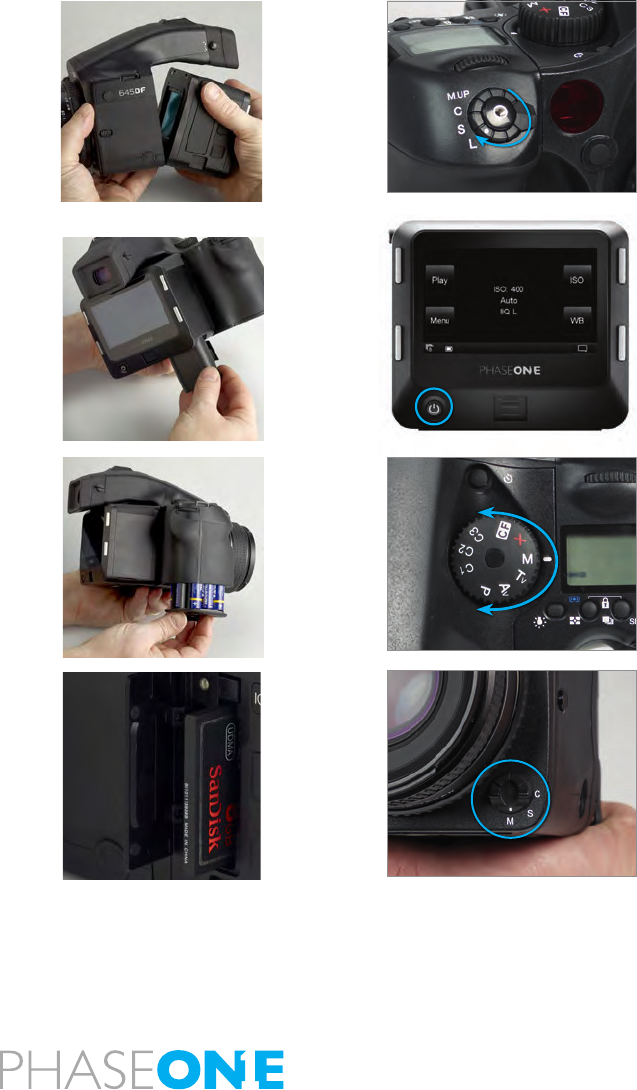
50
1.
2.
2.
3.
4.
4.1 Quick Start (shooting untethered)
1. Connect an IQ2 digital back to the camera and install the focusing screen
if applicable.
2. Charge the batteries (See page 16) then insert them into the camera.
3. Insert a CompactFlash card into the IQ2 Back.
4. Switch on the power to the back and camera and select a drive mode.
5. Choose an exposure mode.
6. Select a focus mode on the camera body and lens if applicable.
7. Set the date and time. (See page 25).
8. Set the ISO and White Balance. (See page 28).
9. After shooting, transfer images into Capture One software from the CF
card using a card reader.
10. Editing images in Capture One and output as required.
5.
6.
4.
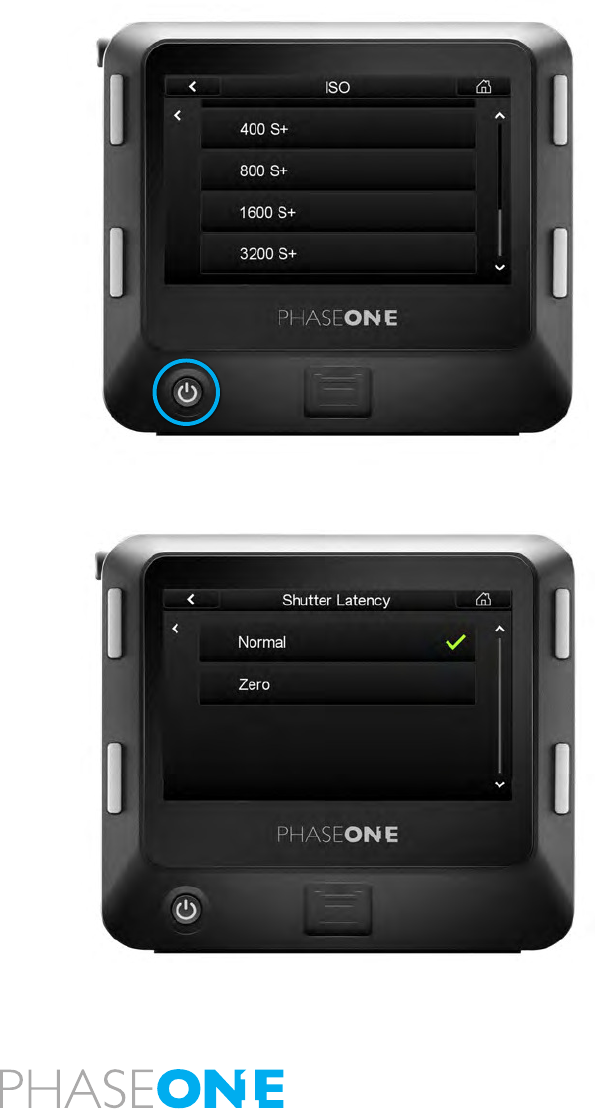
51
4.2 General Hardware Setup
Powering up the IQ2 back
After an IQ2 back is connected to a camera body, insert a battery and it will
automatically turn on. The back is switched on/o by pressing the power
button located below the IQ2 back display.
ISO Settings
The IQ280 back has an ISO spectrum from ISO 35-800. The IQ260 has a 50-
800 spectrum and the Achromatic back has a ISO range from 200-3200.
The default ISO setting for 50 for IQ280 and IQ260 models and 200 for the
Achromatic.
An ISO rating can be selected from the menu system (when untethered) or in
the Capture Tool in Capture One Pro software (when tethered).
Sensor+ technology, built into the Phase One IQ Series models, expands the
ISO range from 140 to 3200 at 20 megapixels resolution for the IQ280. The
IQ260 models have a Sensor+ ISO range from 200 to 3200 at 15 megapixels
resolution.
Power Management and Shutter Latency
The IQ2 back’s CCD needs to be constantly cleared of data from the previous
capture before the next exposure can be taken. This process requires some
power consumption. The default setting is Normal Latency, which should
remain unchanged under all ‘normal’ shooting scenarios. Only change
the setting to Zero Latency if you work on technical cameras, large format
cameras or certain manual cameras in special situations.
Double Exposure Protection
It is not possible to accidentally double expose an image by capturing one
shot quickly after another when an IQ2 back is used on cameras such as the
Phase One 645DF+/DF/AF, Mamiya 645DF/AFDIII, Hasselblad 555 ELD (DIG
mode), Hasselblad H or Contax 645. The electronic communication with the
body ensures that the IQ2 back is ready before allowing release of the next
shot. However, users of other camera bodies that do not use the electronic
interface from the IQ2 will have to wait for the ready beep signal before
releasing the next shot.
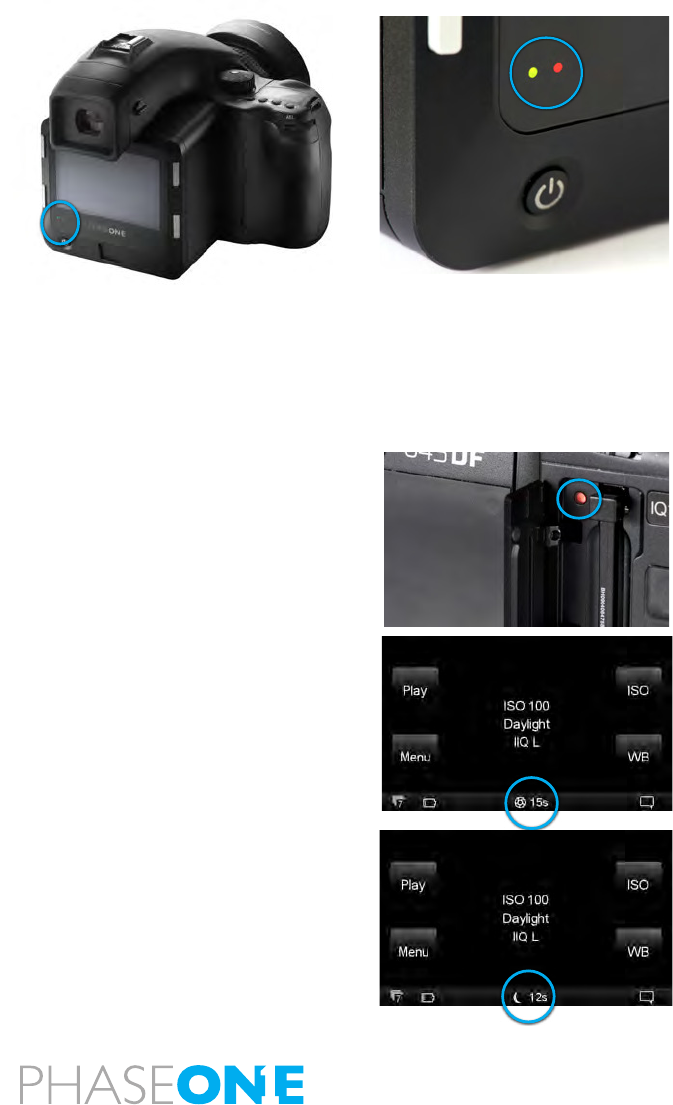
52
4.3 Indicator Lights
IQ2 Series digital backs feature two main red and green LEDs located below
the bottom left corner of the screen. When the IQ2 back is activated, the
green and red LEDs will ash shortly and a beep will sound to indicate that
it is ready to capture. In general, if the LEDs are not illuminated the camera
is ready.
A red indicates that the IQ2 back is writing to the storage media, and
therefore the buer has not been emptied. When capturing an image the
green LED will blink rapidly to indicate that the IQ2 back is busy exposing the
CCD or moving data from the CCD. A continuous green light indicates that
the backlight of the display is dimmed but the camera is still ready to shoot.
The IQ2 back also has an orange light to indicate that the battery is charging
when the back is connected to a computer via a FireWire or USB connection.
(Go to page 84 for more details about charging the battery whilst tethered
to a computer).
Additional Red LED
There is an additional red LED indicator located next to the CF card slot (under
the cover). It is assigned to indicate CF card activity only. Do not remove a CF
card from the card slot when this red LED is on. Removing a CF card whilst
the red LED is on can damage the formatting of the card, and images or data
might be lost or corrupted.
4.4 Indicators
Long exposure time indicator: An exposure time indicator will appear on
the IQ2 screen if the camera is set to expose for more than 2 seconds. The
indicator will count the seconds while the shutter is open. This indicator is
useful for timing long bulb exposures.
Long exposure black reference: In order to capture noise free long expo-
sures Phase One digital backs needs to capture a black reference after
each capture. This black reference requires the same amount of time as the
exposure itself.
A night symbol and a counter counting down the time left for black refer-
ence capture to complete will appear at the bottom of the screen while the
black reference is being captured. This function is performed automatically.
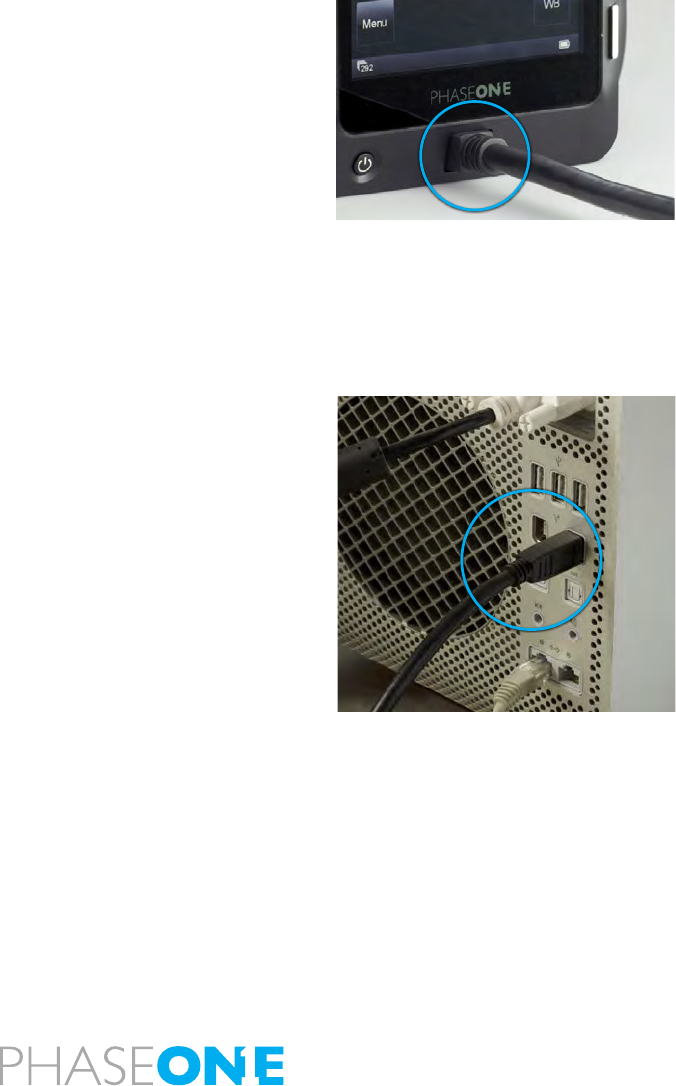
53
4.5 Tethered and Untethered Operations
Untethered: An IQ2 Series back can be operated as a fully portable battery
powered unit. Image les are shot and transferred to a CompactFlash card
which is inserted in the CF-card slot on the left side of the camera back.
Tethered: Remember to always keep a battery in the IQ2 back even when
shooting tethered to a computer via a FireWire or USB3 connection. When
operating tethered, image les can be shot to a CompactFlash card or
transferred directly to the assigned capture folder in the Capture One ap-
plication on the computer hard disk. (Go to page 84 for more details about
charging the battery whilst tethered to a computer).
Driver Set-up
Find out more on Installation and Activation of software on page 9 and 10 of
this User Guide. There is no specic program set-up. Check the Capture One
User Guide for recommended hardware. Eventual rmware announcements
will be available on our website, and in our newsletters.
Connecting
The maximum length of a compatible FireWire cable is 4.5 meters. Longer
cables might require a third party power solution or a FireWire hub. IQ2
Series backs match the FireWire 800 standard.
Plug the FireWire 800 cable into the IQ2 unit and into back of your Mac or
Windows PC. (It is not recommended to use a FireWire port on the front of a
computer as it can be less stable). Capture One will automatically recognize
the IQ2 back and settings shared. (Read more on shooting tethered in the
Capture One software manual).
N.B: IQ2 backs are compabile with FireWire 400. Please order a Phase One
FireWire 800 to 400 cable 4.5M. Part No: 50300164
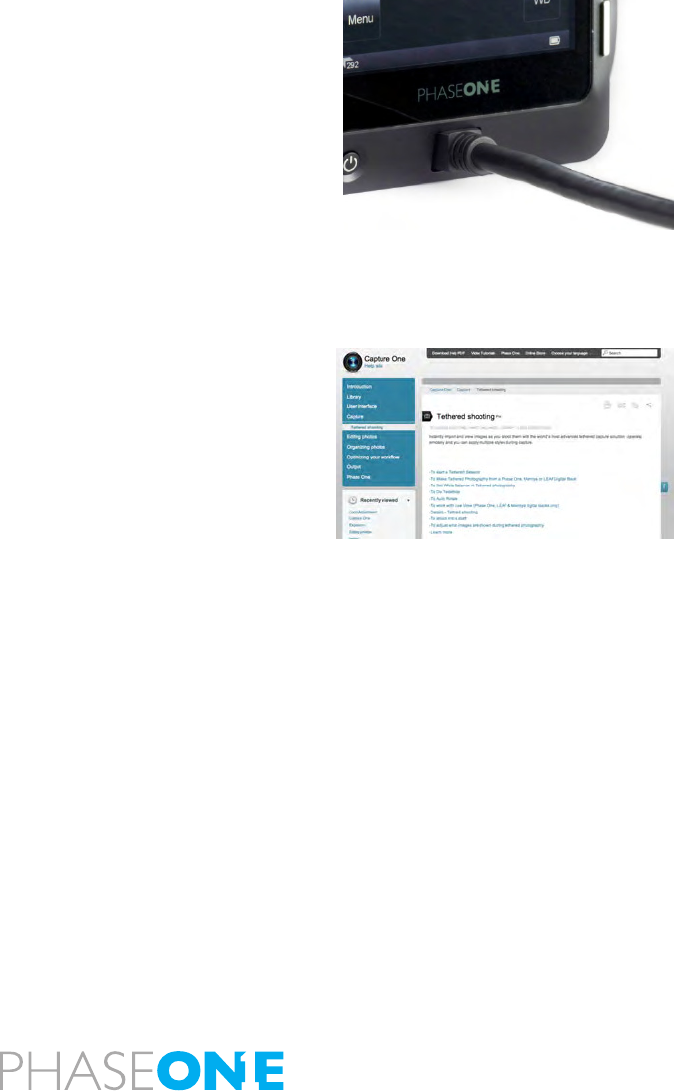
54
Tethered Operations Continued
The display on an IQ2 Series back can be either be turned o while shooting
tethered or set to display the images while they are shot, just as if shooting
untethered. It is also possible to enlarge a section of an image on the IQ2
screen to help check focus of the current and upcoming captures.
An IQ2 back will default to its untethered mode when the FireWire 800 or
USB3 cable is removed in its Auto Storage setting. Captured image les will
be stored on a CompactFlash card, and the unit’s battery will provide power.
(The IQ2 back can be forced to shoot to either CompactFlash or via a FireWire
800 cable to a computer. Find out more on the Storage Mode on page 85).
Online Support
For more information on shooting tethered with Capture One please consult
the online user guide available in the Capture One Help menu or go direct to
http://help.phaseone.com/en/CO7/Capture/Tethered-Shooting.aspx
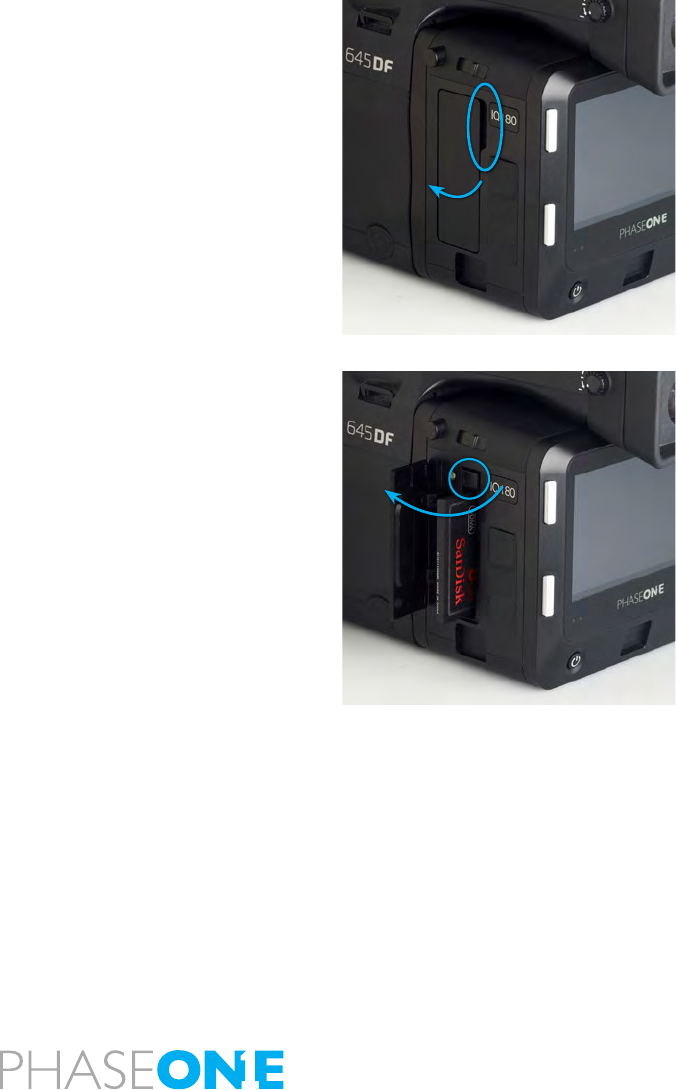
55
4.6 CompactFlash Card Usage
It is important to follow a few simple guidelines to help avoid loss of data
when working with CompactFlash cards, card readers and digital cameras.
Phase One recommends that you test-drive all new CompactFlash cards
including the one that comes with your IQ back. By performing an initial test
to verify that the capture les are stored properly on the card and can be
accessed on a computer you will avoid unpleasant surprises on location or
when you return from a job. CompactFlash cards are manufactured by other
suppliers and Phase One cannot guarantee that the cards are not defective.
Inserting and Ejecting on the IQ2 Back
The CompactFlash card is inserted in the hidden slot located under the cover
on the left hand side of the IQ back.
Insert the CompactFlash card with the brand label facing the display end of
the digital back as shown in the image.
The cover can be closed when the CompactFlash card is fully inserted.
To eject the card push the small button above the card once, and an ejecting
pin will come out. Pushing this pin all the way back in will eject the card.
Microdrives are not recommended for use with IQ backs.
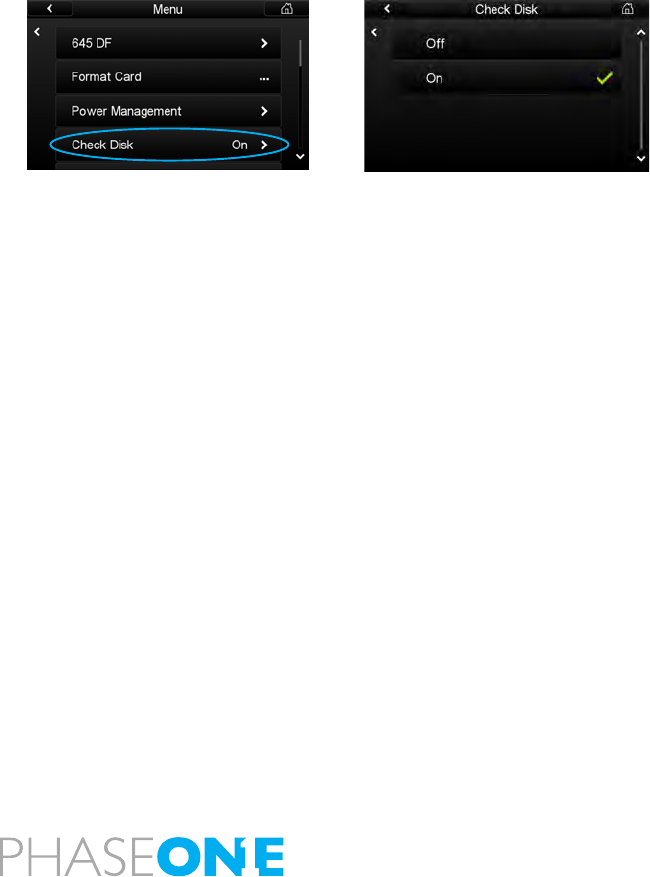
56
4.7 Secure Storage System (3S)
You can always be sure that your data is safe when working with memory
cards in a Phase One IQ2 back. The Phase One Secure Storage System (3S)
provides the industry’s safest memory card handling. The 3S technology
automatically checks your card’s le structure every time it is inserted into
the IQ2 back. If the disk check function nds any errors, it will prevent usage
of the card until these are corrected or the card is formatted.
How does 3S work?
A complete disk check for a valid le structure is performed as soon as a card
is inserted into the IQ2 back.
Lower gigabyte capacity cards will load quicker than high capacity versions.
It is not recommended to turn o the Check Disk function. If you want to turn
it o go to Menu>Check Disk.
Disk Check Summary
3S technology is a safe storage system integrated into the IQ2 back and is
much more rugged than anything else seen in the industry. No other digital
back or DSLR camera has this level of storage security.
Benets include:
• There is no need to format a card on a computer
• Damaged or incorrectly formatted cards will be detected immediately. IQ2
backs also have the ability to reformat and correct these cards.
• Ejecting a card while it is writing a session will not necessarily damage the
le structure of the entire CompactFlash card. Only the image being written
and the images in the buer can be damaged.
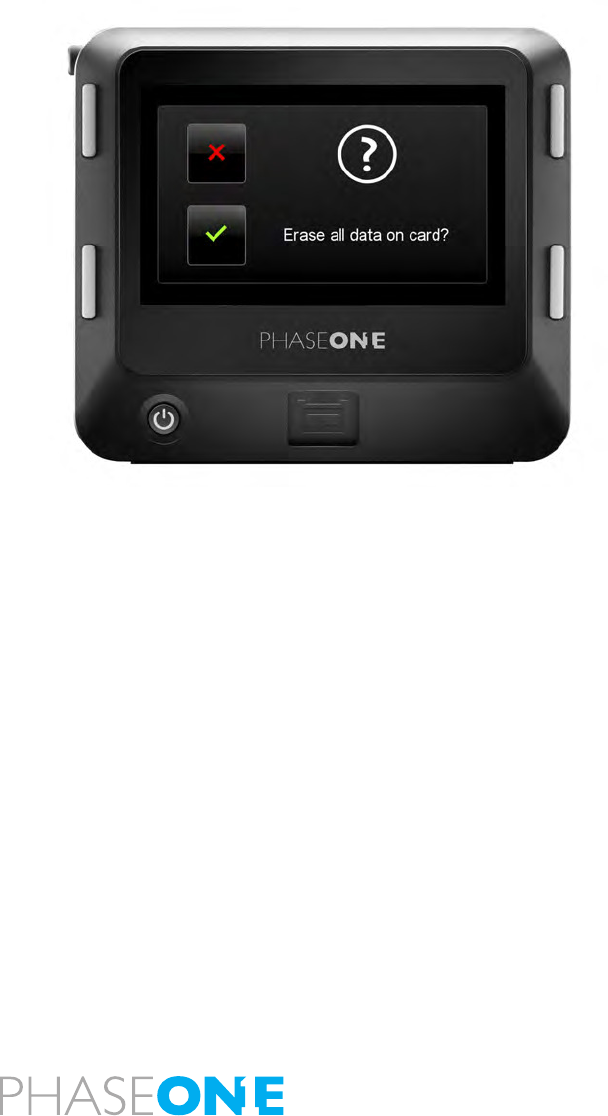
57
4.8 Formatting your Memory Card
Most CompactFlash cards are preformatted and ready for use in the IQ backs.
However, Phase One recommends that all cards should be formatted in the
IQ back to ensure their optimum performance.
Memory card formatting is done in either FAT 16 or FAT 32 depending on
card size. (IQ backs support CompactFlash cards formatted in both FAT 16
and FAT 32).
Using CompactFlash Cards in a Card Reader
A card will be mounted as a removable drive on a computer after it has been
inserted into the card reader and connected to a Mac or PC. Windows and
Mac OS X will have the required drivers for the CF card reader. For information
on how to import les to Phase One Capture One, please consult the Capture
One online user guide available under Capture One Help in the Help Menu.
Warning!
Ejecting a card or removing the battery while the IQ2 back is still writing
(when the red LED is on) will cause images that are not written to the card
to be permanently lost or damaged. Do not bend or ex your Compact-
Flash card. Please keep the card away from moisture, grit and sand. Use the
supplied CompactFlash card case as a storage container when not in use.
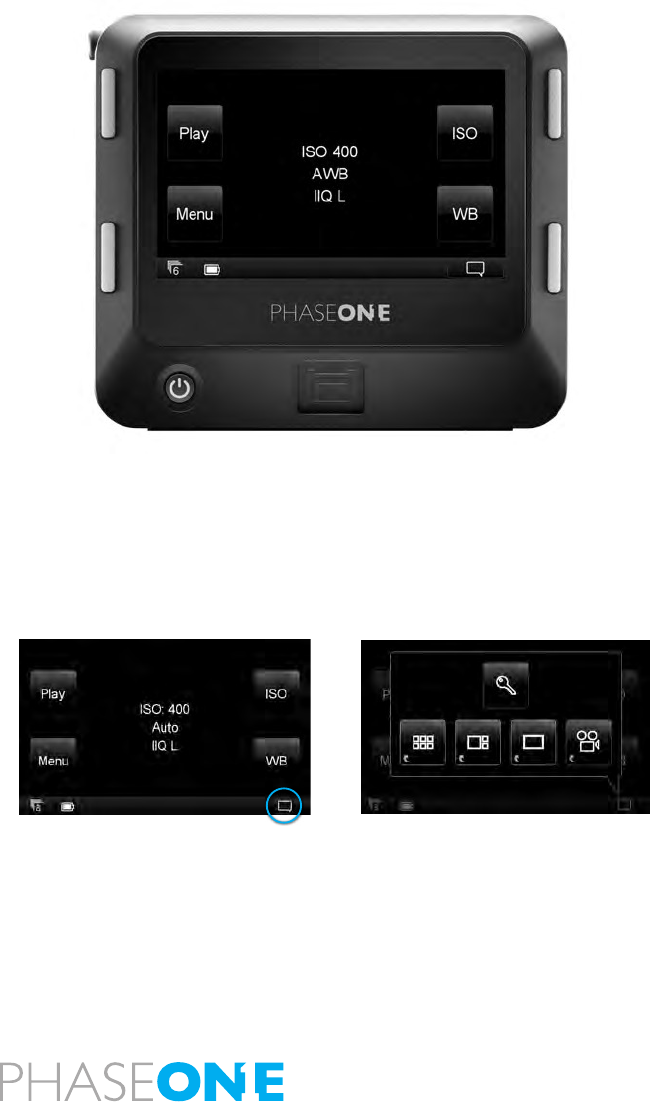
58
5.0 Navigating the IQ2 User Interface and Menu System
Home Screen
The IQ2 Home Screen is the rst view users will see as soon as the back is
switched on. This is the back’s default screen and the starting point in which
to negotiate the menu system. It enables direct access to the Play mode to
view captured images, the Menu to congure the IQ back’s setup and ISO
sensitivity and White Balance (WB) settings.
The bottom of the Home Screen features an Info Bar that displays a Power
Indicator that shows the remaining battery capacity or a FireWire icon if the
IQ2 is being used to shoot tethered via a FireWire 800 connection. The Power
Indicator will start blinking when it runs low to warn users that the battery
needs to be replaced before capturing any more images.
The selected ISO rating, White Balance setting and the IIQ Raw le format are
all displayed in the center of Home Screen. A ‘S+’ icon will appear next to the
le format indicator if the Sensor+ function is in use.
Press and hold the top left button to immediately return to the Home
Screen regardless of where you are in the menu system.
Context Menu
Press the Context Menu button in the bottom right corner of the Home
Screen to quickly access three image review options. Select either the
Thumbnail, Tool View or Full Screen mode. Select the key icon to lock the
four (external) menu buttons and the touch screen functionality.
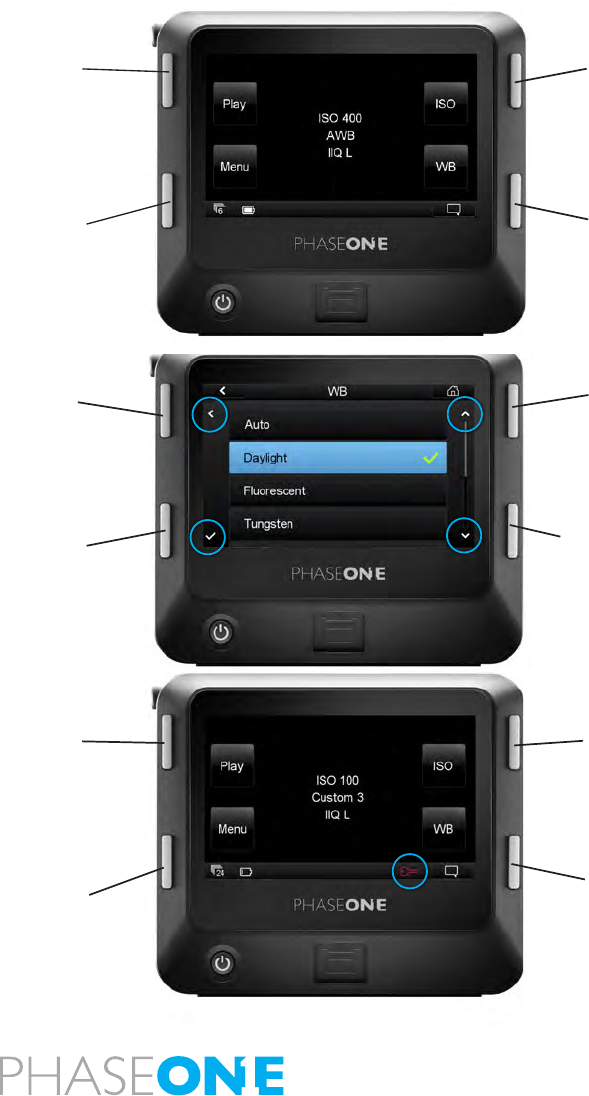
59
5.1 Menu Buttons
The IQ2 back is equipped with four external buttons. The buttons will change
function to match the menu shown on the display.
The four external buttons are assigned to the Play, Menu, ISO and WB options
when the IQ2 back is in its default Home Screen position. (See image left)
The function of the four buttons changes once one of the Menu, ISO and WB
options has been selected. In general, the two buttons to the left are used
to exit the screen and select a menu option. The two buttons to the right are
used to navigate up and down in the menu system.
Press Play on the Home Screen. Here the four buttons take on a dierent
role as the two left buttons are assigned to zoom in and out image les and
used to display a thumbnail collection. The two right buttons are assigned to
scroll through thumbnails and image les.
Tip: The function of an external button is usually signalled by the icon
positioned nearest to it on the screen. (See blue circles on the left picture).
5.2 Shortcuts
Home shortcut: Press and hold the upper left (Exit) button to immediately
return to the Home Screen regardless of where you are in the menu system.
Button Lock shortcut: Hold down the upper left (Play) button whilst the
Home Screen is displayed and double press the lower right (external) but-
ton. The key icon will appear at the bottom of the screen and turn red to
conrm that the four (external) menu buttons and the touch screen func-
tionality has been locked. Repeat the procedure to unlock the buttons and
screen. (Hold down the Play button and double press the WB button).
Up
Down
Enter
Exit
ISO
WB
Menu
Play
Menu
Play ISO
WB
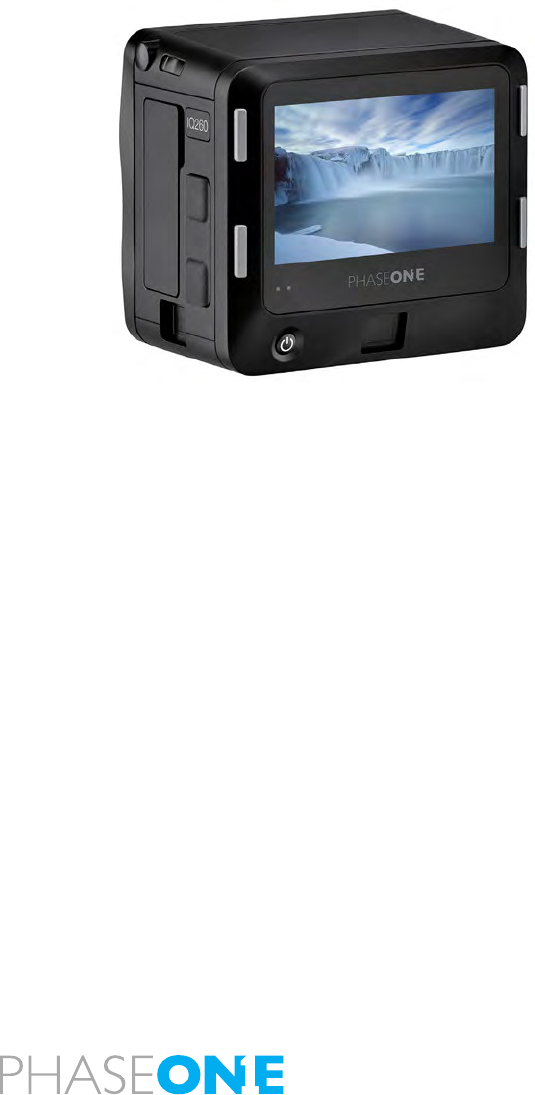
60
5.3 Touch Screen Operation
All three IQ2 models incorporate a 3.2 inch touch screen. The screen lets
you zoom, pan and browse through images fast and it is easy to navigate
between dierent menus and features. The IQ2 series backs are designed
with invisible controls that are context sensitive and appear only when
specic areas of the screen are touched. One example of this is the unique
instant zoom function, which allows you to zoom just by using one nger.
Small histograms and highlight warnings can be enlarged to full screen
view by simply touching them. Wide format display allows for a full 4:3
aspect ratio VGA resolution image next to histogram, highlight warning,
focus mask, EXIF data and touch controls. It is possible to operate the IQ2
back using the touch screen display or the well-known and intuitive 4-but-
ton navigation.
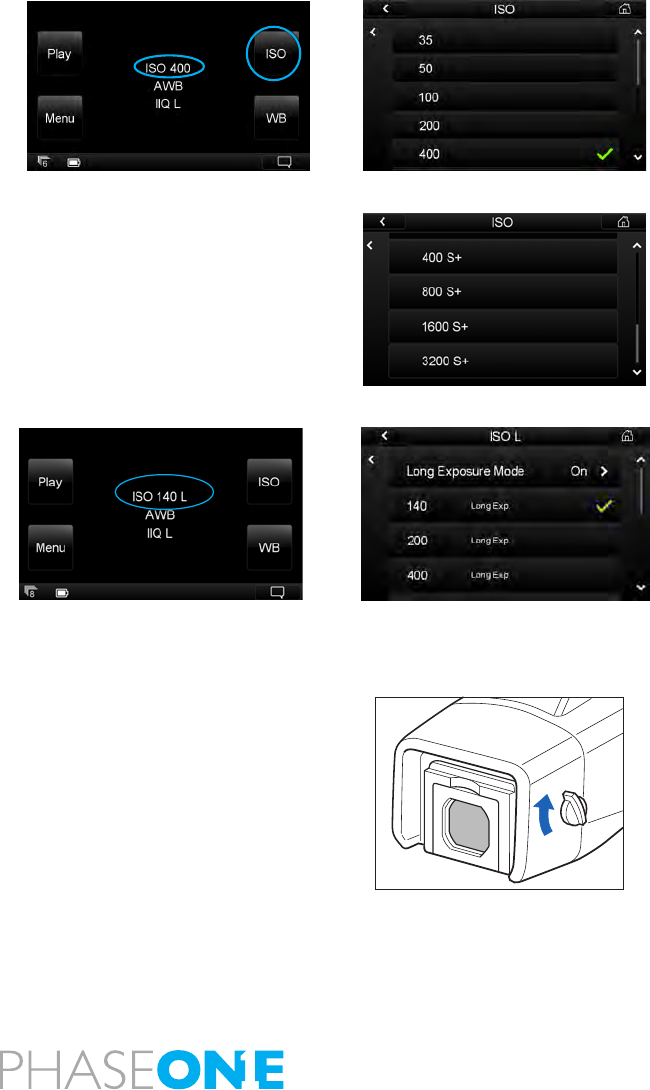
61
5.4 ISO
Push the top right button or tap ISO on the Home Screen. You will be
presented with the back’s ISO spectrum. Scroll up and down and tap the
screen to select the desired setting. A green check mark will appear next to
your chosen setting and you will automatically return to the Home Screen.
An ISO rating can also be selected from the Capture Tool in Capture One Pro
software (when shooting tethered).
The IQ280 back has an ISO spectrum from ISO 35-800. The IQ260 has a 50-
800 spectrum and the Achromatic back has a ISO range from 200-3200.
The default ISO setting for 50 for IQ280 and IQ260 models and 200 for the
Achromatic. Sensor+ technology, built into the Phase One IQ Series models,
expands the ISO range from 140 to 3200 at 20 megapixels resolution for the
IQ280. The IQ260 models have a Sensor+ ISO range from 200 to 3200 at 15
megapixels resolution.
Long Exposure Mode – IQ260
The Long Exposure Mode is a feature integrated into the IQ260 enbabling
noise free exposes of up to one hour. The default setting is On. When the
mode is O, the IQ260 will automatically display a dialogbox that suggests
using the Long Exposure Mode with exposures longer than than 10 seconds.
Long Exposure Mode is marked with an L after ISO in the Home Screen.
The Long Exposure Mode has an ISO range from 140 to 800 that can be
extended up to ISO3200 in Sensor + mode.
Precautions on Long Exposure Shoots
1. Close the eyepiece shutter to block any light from entering the viewnder.
2. When using extreme long exposure more than 5 to 10 minutes outside
in daylight, please take relevant precautions, e.g. avoid having camera and
digital back in direct sunlight.
3. Cover your entire camera with a Phase One lens wrap or similar light proof
material to eliminate stray light.
4. Remember that when you make a long exposure, the digital back will make
a black calibration after the capture of the same duration as the exposure.
Find more detailed information - Search for “Long Exposure” on:
www.phaseone.com/support
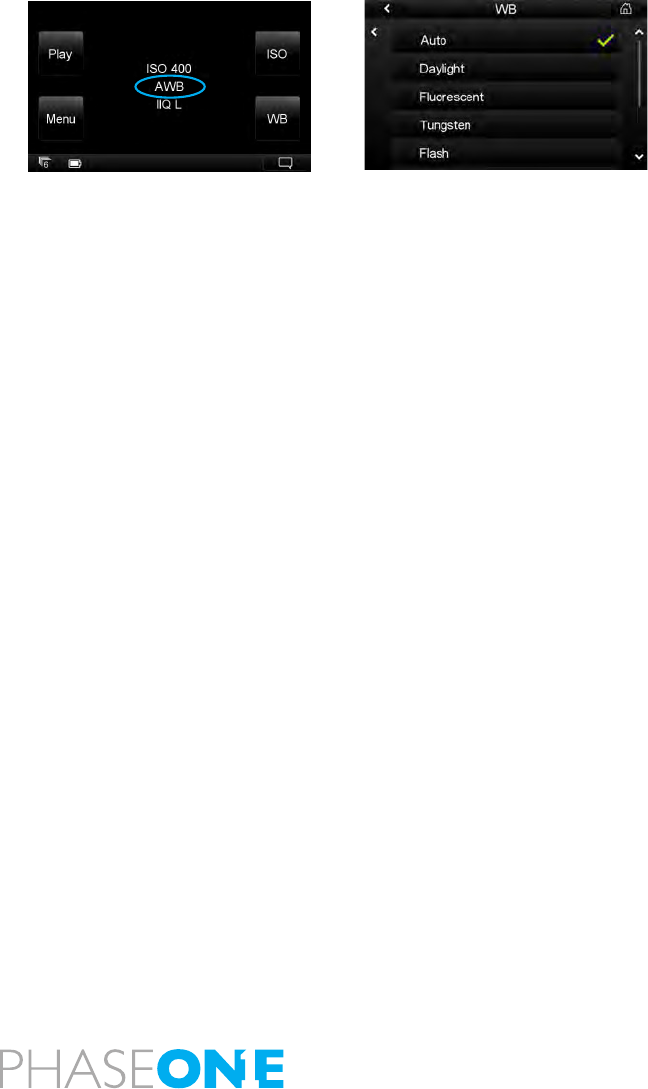
62
5.5 White Balance
Push the lower right button or tap WB on the Home Screen. You will be
presented with the back’s White Balance settings. Scroll up and down and
tap the screen to select the desired setting. A green check mark will appear
next to your chosen setting and you will automatically return to the Home
Screen.
The default ISO setting is Auto that will calculate a White Balance based on
the information in the image. Auto WB is appropriate for most applications.
A specic light source can also be selected in the WB menu. These include
Daylight, Fluorescent, Tungsten and Flash. It is easy to check the WB setting
as it is displayed in the center of the Home Screen below the ISO rating.
White Balance can also be set from within Capture One when shooting
tethered to a computer. Find out more on tethered operation from page 53.
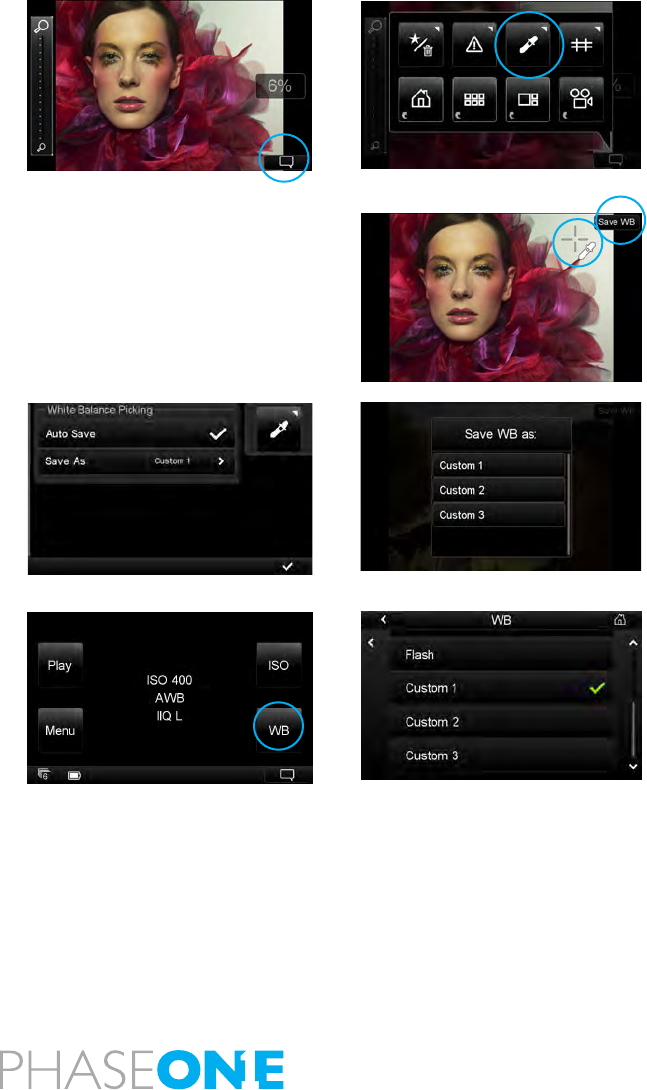
63
5.6 Custom White Balance
To create a new Custom White Balance, rst capture a reference White
Balance image. (Try to use a gray card or neutral white surface). Next, select
the Context menu and press the White Balance Picker icon. (Ensure that the
image is in full screen view)
Zoom in and pan to a desired part of the image and then tap on a white/
grey area to create a custom WB. A cross-hair icon will appear on the screen.
You can continue to pick WB point elsewhere in the image until you are
satised with the generated WB. The Custom White Balance is now set and all
subsequent captures will use this WB setting in Auto Save mode. The picked
WB is only applied to the current image if Auto Save mode is deselected.
The IQ Back enables users to create and store up to 3 Custom White Balance
settings. To create and store a Custom WB setting go to the Context menu
and long press the White Balance Picker icon. Deselect the Auto Save box in
the dialog box.
The next time you create a Custom WB setting you will be presented with a
Custom 1, Custom 2 or Custom 3 option. Choose a number to save and store
the WB setting.
This stored Custom WB settings can be accessed again for future use by
scrolling to the bottom of the WB options.

64
6.0 Play Mode
Play mode is used to review captured images. Its touch screen interface
makes it easy to delete, zoom, pan and browse through images quickly. Push
the upper left (external) button or tap Play on the Home Screen to enter this
mode.
Long press the upper left (external) button to exit the Play mode at any time.
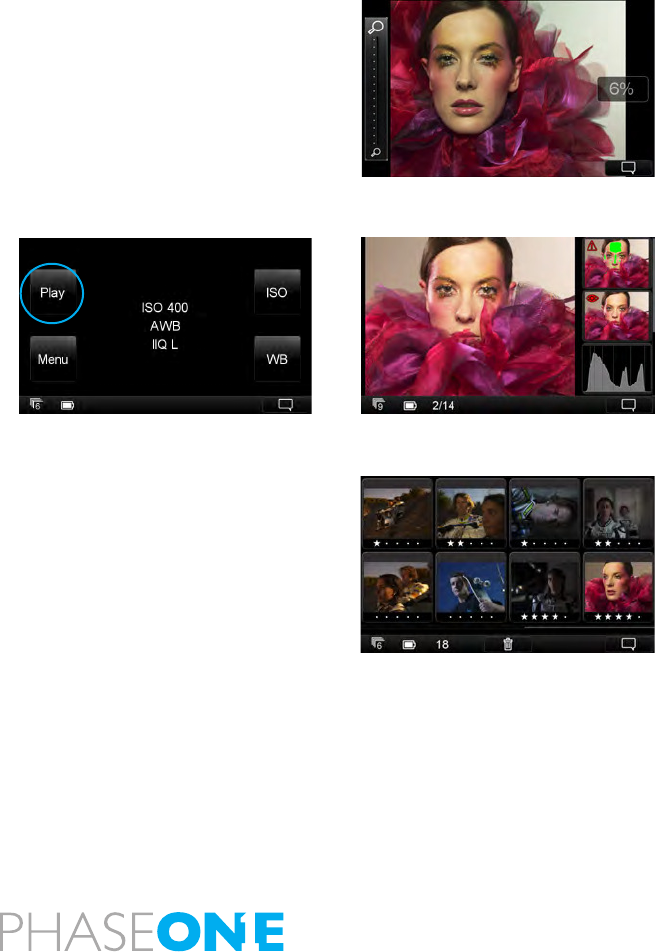
65
6.1 Play Mode Views
There are three Play mode views: Full Screen, Tool View and Thumbnail
View.
Full Screen displays an image in its entirety. A Zoom Slider, Context menu
too and zoom level percentage will automatically disappear after a few sec-
tions of inactivity.
The default Tool View features ve tools that include an Exposure Warning,
a Focus Mask, an Exposure Histogram, an Alignment tool and File Info.
The Thumbnail View displays all images stored on a CompactFlash card in a
series of 8 thumbnails.
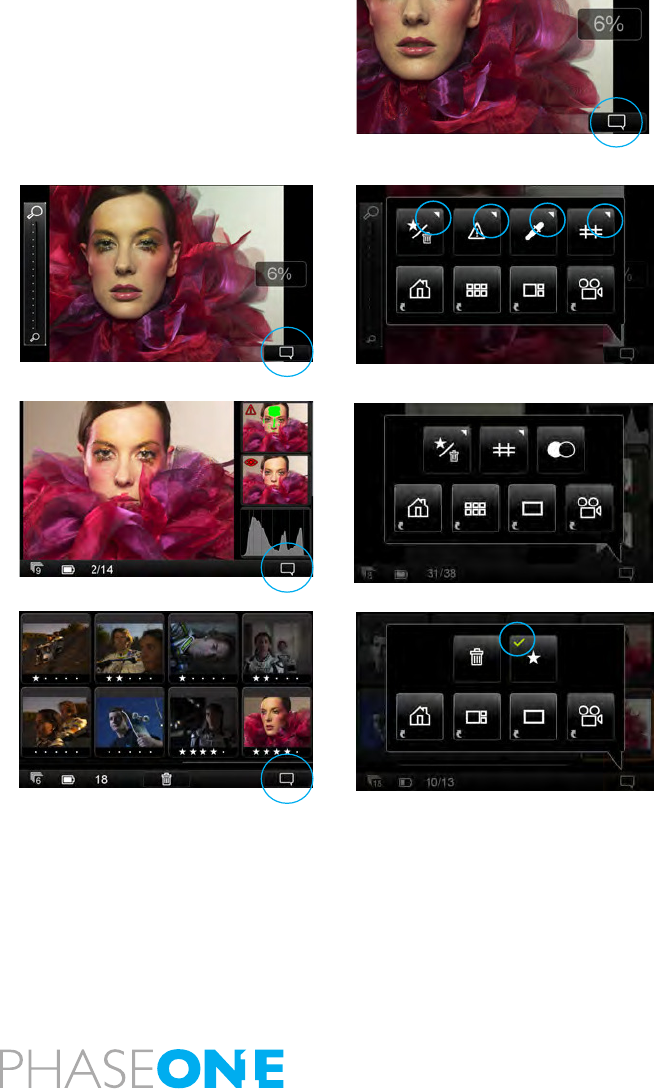
66
6.2 Play Mode: Context Menu
Press the Context Menu button in the corner of each Play mode. All Context
Menus feature three navigation buttons. Select one of the three bottom
items (from left to right) to switch to an alternative view.
The Full Screen Context Menu features a Delete/Rating, Exposure Warning,
Custom White Balance Picker and Grid options. Press and hold these icons
(with a white triangle in the corner) to further congure.
The Tool View Context Menu features a Delete/Rating, Grid and Black and
White options.
The Thumbnail View features a Delete and a Rating options. A green check
mark will indicate that a button has been activated.
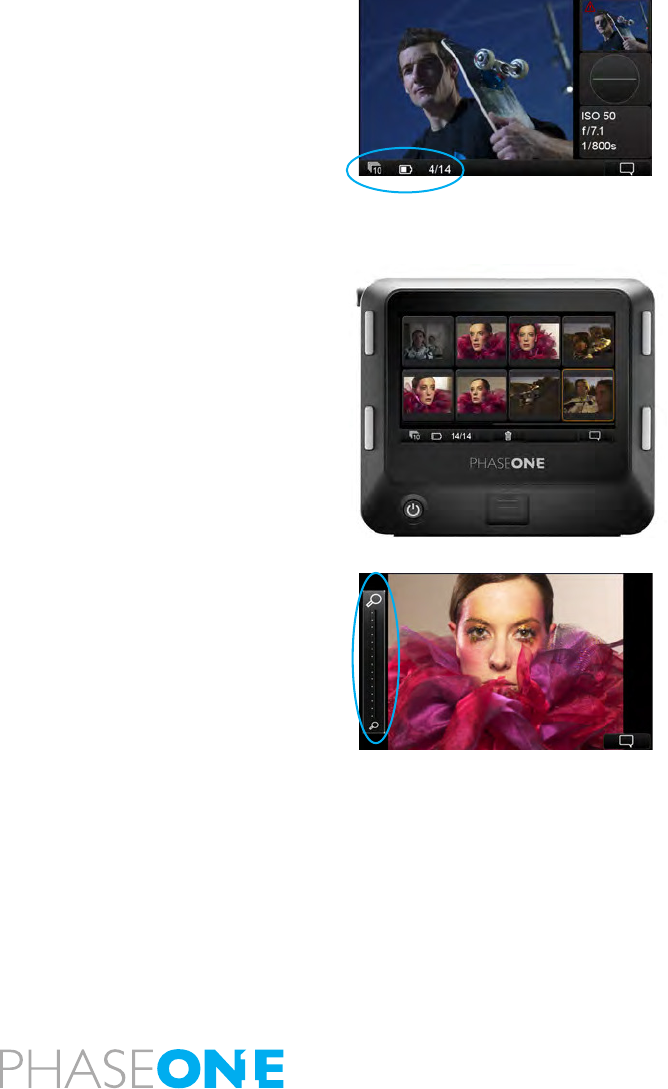
67
6.3 Info Bar
The bottom of the screen features an Info Bar that displays a Power Indicator
that shows the remaining battery capacity and a FireWire or USB3 icon if the
IQ2 is being used to shoot tethered. The Power Indicator will start blinking
when it runs low to warn users that the battery needs to be replaced before
capturing any more images. The FireWire or USB3 icon will also blink on and
o to signify that there is a connection problem when set to their respective
storage modes. (See Storage Mode on page 85)
Thumbnail and Tool View also display the current image number and the
number of images captured on the media. In this example it shows number
4 out of 14 images.
6.4 Play Mode Navigation
Press the Up and Down (right external) buttons to scroll through captured
images in all the Play modes. Press the upper and lower left external buttons
to zoom in and out of an image or switch to a dierent Play mode.
Swipe your nger left or right to scroll through captured images on all Play
mode views. The selected thumbnail is highlighted with an orange border.
6.5 Zoom
Tap the screen once in the Tool View to see a Full Screen image. The IQ back
enables users to zoom into a review image by up to 400%.
Instantly zoom into a specic area at 100% by tapping the screen twice or
by pressing the lower left (external) button. Double tap the screen again or
press the upper left button to return to the full screen view.
To zoom up to 400%, slide your nger up and down the Zoom Slider on the
left side of the screen. Use the Zoom Slider to also return to the Tool and
Thumbnail Views by sliding you nger down when a full screen image is
displayed.
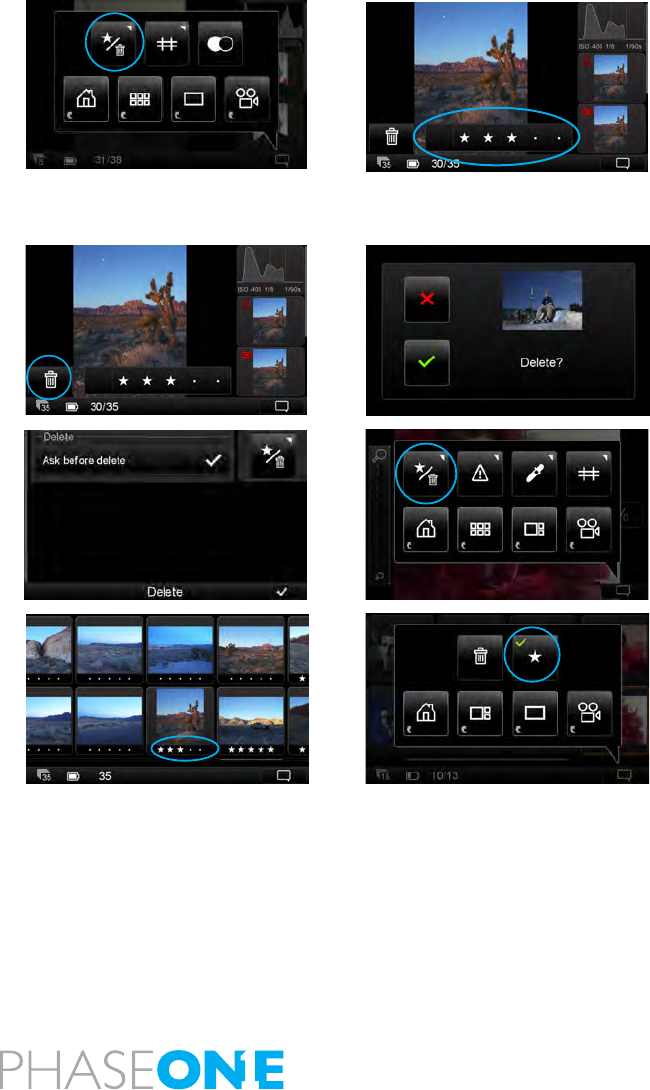
68
6.6 Delete and Rating
Choose the top left button in the Context . A grey bar will appear at the
bottom of the screen when reviewing in Full Screen or in the Tool View.
Tap the dot in the grey bar to select a star rating from 1 to 5. Alternatively,
swipe your nger along the bar to choose a star rating. Press the blank grey
area on the left of the bar to deselect a star rating to 0 (zero). Ratings will be
recognized in Capture One when they are imported from a memory card.
Press the trash button to Delete an image. A ‘conrm delete’ screen will
appear. Press the green check mark to permanently delete the image or
press the red cross to cancel.
To remove the Delete/Rating icon from view, press the Context menu icon
and press the same top left button. Long press the Star/Trash icon in the
Context menu to turned o the ‘conrm delete’ screen.
Star ratings can be seen in the Thumbnail view by pressing the Context menu
and selecting the Star button.
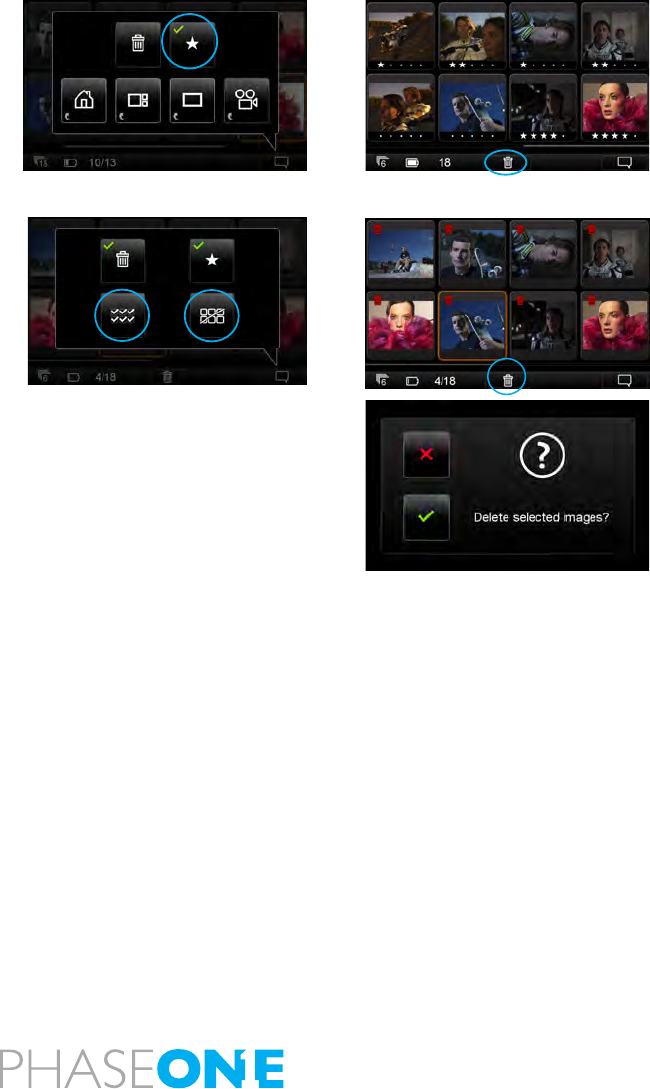
69
6.7 Delete in Thumbnail View
Select the trash icon to Delete images in the Thumbnail View. A trash icon
will appear in the Info Bar at the bottom of the screen. Tap each individual
thumbnail that you want to delete. (A small red trash icon will appear in
the top left corner of the thumbnail). Conrm that you want to delete the
selected thumbnails but tapping the white trash icon at the bottom of the
screen.
Press the Context menu once the Delete option has been selected. Select
the option below the trash icon to select all images les. (A red trash icon will
appear in each thumbnail). Press the option below the star icon to deselect
all the images.
If all the selected images have been selected, press the white trash icon
at the bottom of the screen. You will be asked to conrm that you want to
Delete all the selected images. Press the green check mark to permanently
delete or press the red cross to cancel.
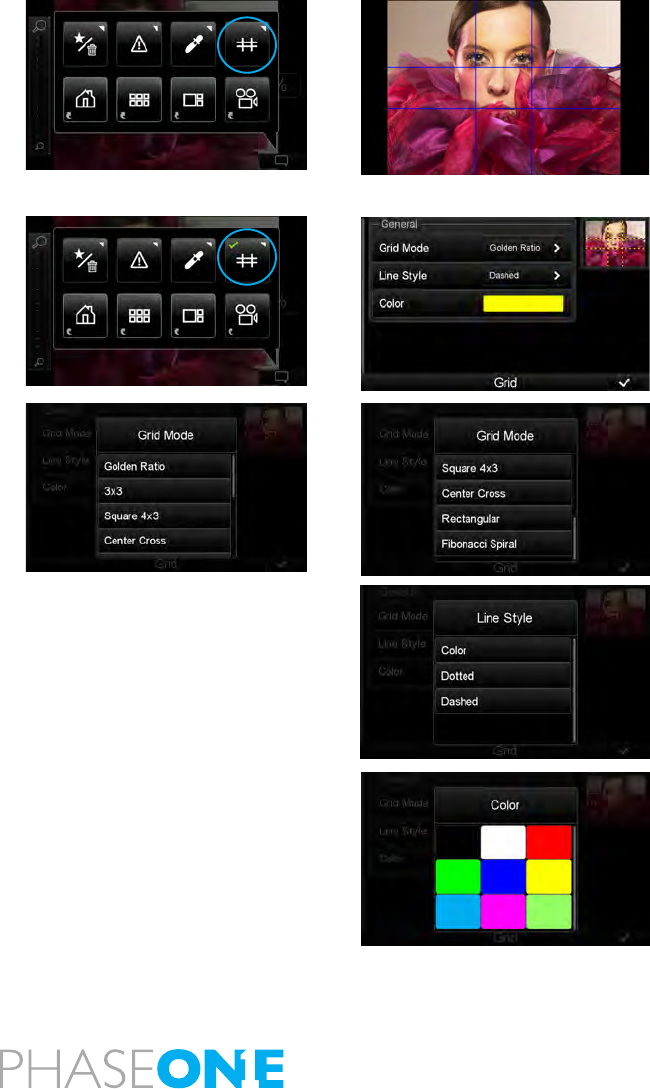
70
6.8 Grid
Select the Context Menu and choose the (circled) icon to overlay a grid on
captured images in Full Screen, Tool View and Play modes. Press the Grid
icon in Context Menu again to deactivate the Grid.
Long press the (circled) icon in Context Menu to congure the Grid. It is
possible to select a dierent Grid Mode, Line Style and Color.
The Grid Mode enables users to select one of six options that include a
Golden Ratio, 3x3, Square 4x3, Center Cross, Rectangular and Fibonacci
Spiral. Scroll down the screen to see the full list and tap the desired option.
The Line Style can be changed from a solid Color to a Dotted or Dashed line.
Change the color of the lines to one of 9 tones to help them stand out against
an image.
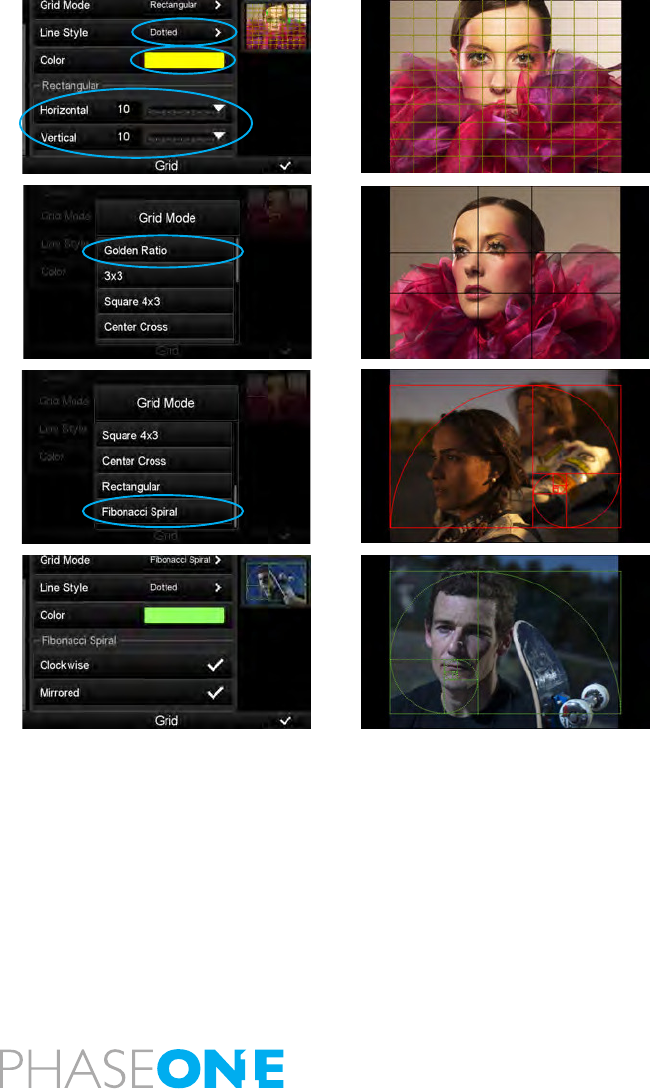
71
The Grid Mode provides numerous style combinations. The Rectangular
option can be congured to display up to 10 horizontal and vertical lines. In
this example (left) the Color has be changed to yellow and the Line Style is
Dotted.
The Golden Ratio grid helps photographers compose images within some
classic proportions. This grid lines divide the screen into nine parts using
two horizontal and vertical lines. Photographers can position important
elements along these lines or at the intersections.
The Fibonacci Spiral option is another classic guide that helps photographers
place subject matter within the curved lines.
The Fibonacci Spiral option can also be rotated clockwise or Mirrored to help
position important elements at the intersections of the lines. The Color and
Line Style can also be altered to help them stand out against an image.
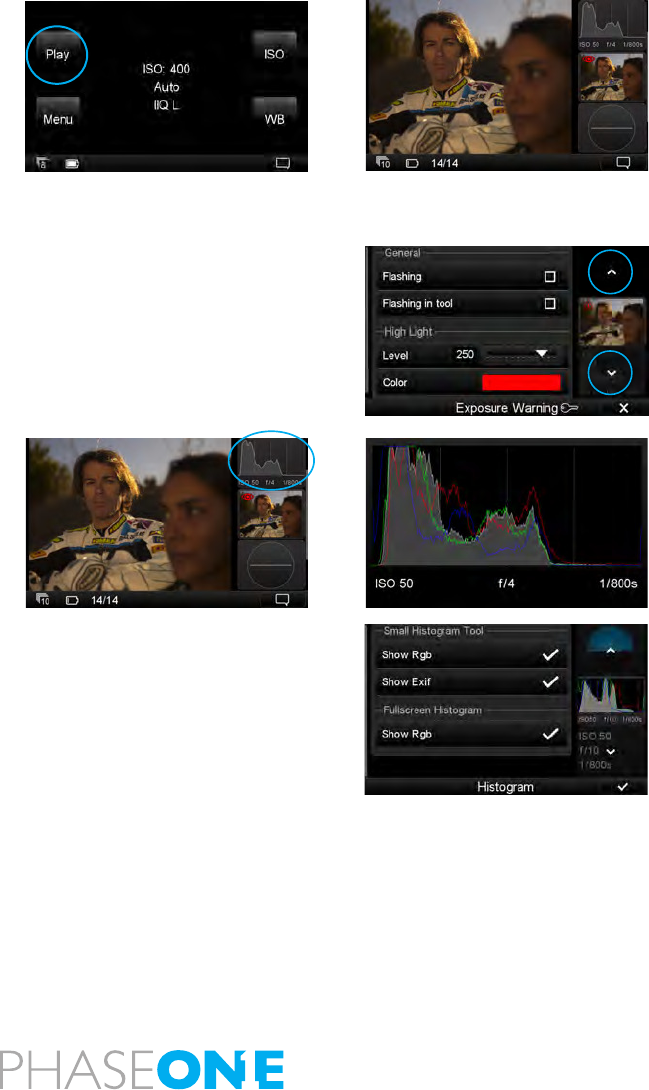
72
6.9 Tools
Play mode features ve Tools to aid the capture and the review of images.
The Tools include a Exposure warning, a Focus Mask, a Exposure Histogram,
a Alignment tool and File Info. Tap the screen to scroll vertically through the
tool selection. Tap the screen on the Alignment tool and Histogram to make
them appear full screen. Tap the screen on the Exposure Warning, Focus
Mask and File Info to make them overlay captured images. Tap each item
again to remove them from the full screen or overlay view.
Congure the Tools
Long press a specic tool to congure a Tool’s settings. The sequence of how
the Tools appear can be changed by pressing the white arrows.
Histogram
Tap the Histogram once to make it appear full screen. The Exif information
(ISO, f-stop and shutter speed) of a captured image is displayed below the
Histogram. Tap the screen again to return to the Tool view.
Long press the Histogram to access a dialog box to alter the Tool’s settings.
User can choose to show or hide the Rgb readout and Exif information.
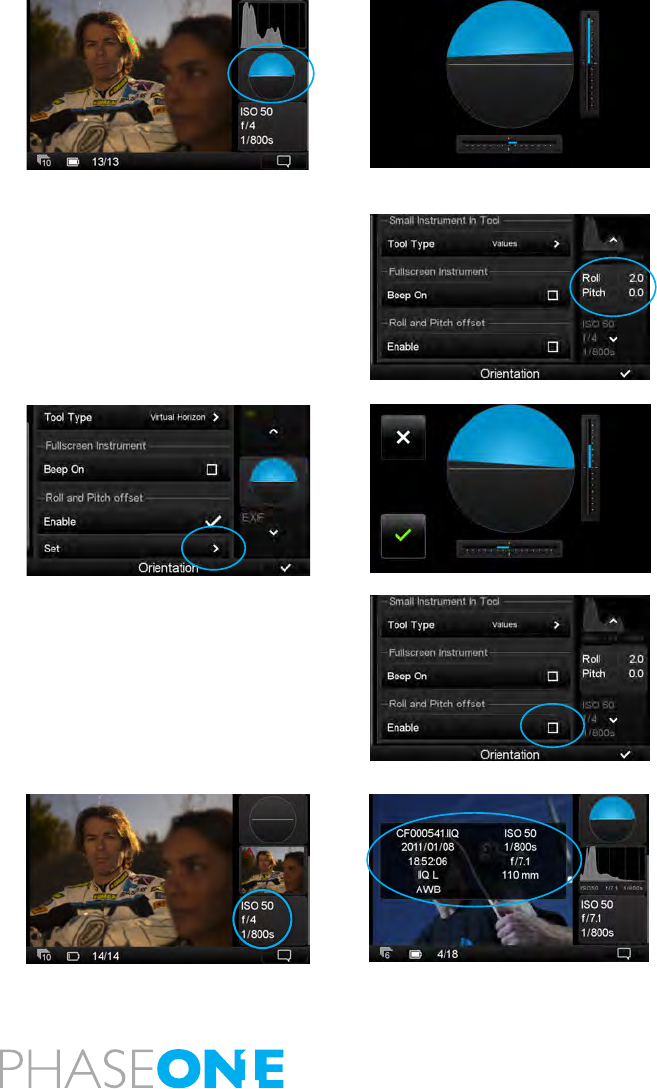
73
Alignment
The Alignment tool helps keep the attached camera in a perfect horizontal or
vertical position. Press the Alignment tool once to make it appear full screen.
Tap the screen or press the upper left (external) button once to return to the
Tool view.
Long press Alignment tool to access a dialog box to alter the Tool’s settings.
Users can choose to view an illustrative virtual horizon or swap to see
numeric Roll and Pitch Values displayed in the Tool. Tap the Beep On option
box to get an audio alert that signals the camera is level.
Roll and Pitch oset: It is possible to realign the virtual horizon to a custom
setting. Press the Set arrow (see circled far left) and the virtual horizon
will appear. Adjust the camera/IQ2 back to get the desired roll and pitch
angles and press the green check mark. This new setting will be enabled
automatically.
Ensure that the Roll and Pitch oset check mark box is not enabled to revert
to the default horizontal or vertical alignment setting.
File Info
The File Info tool displays the ISO rating, f-stop and shutter speed exposure
settings. Tap the File Info tool to see more detailed information that includes
the le name, date and time of capture, le format, exposure mode and the
focal length of the lens.
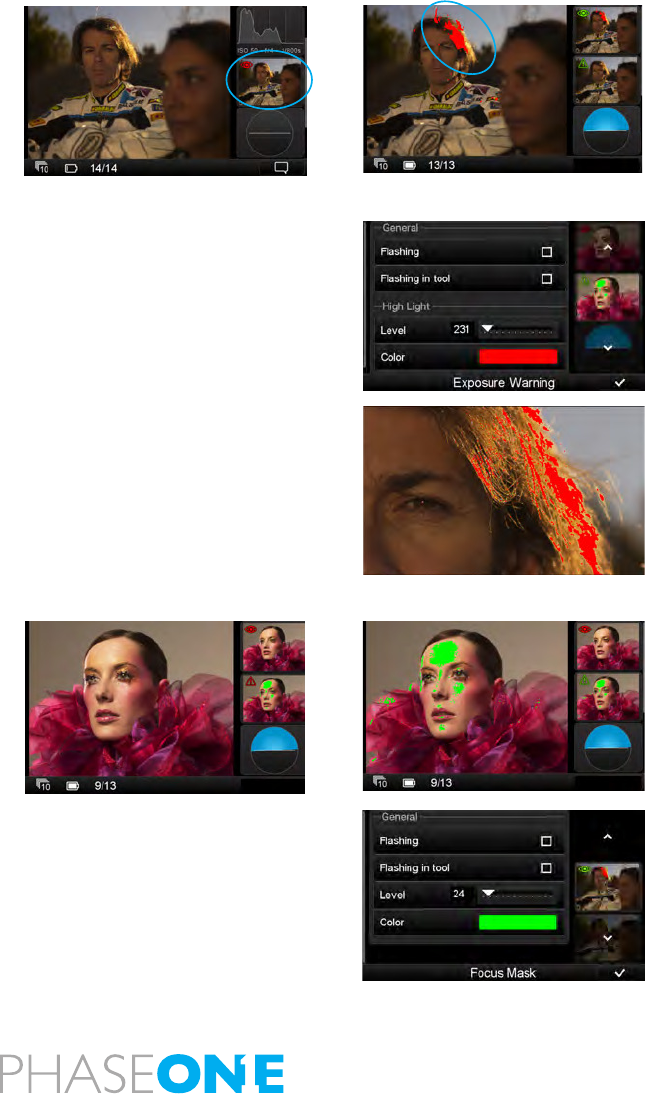
74
Exposure Warning
The Exposure Warning tool highlights areas of a captured image that are
overexposed. Tap the Exposure Warning tool once to display any burned
out areas of an image with a (default red) color overlay. Tap the Exposure
Warning tool again to remove this overlay from view.
Long press the Exposure Warning to access a dialog box to alter the Tool’s
settings. Users can choose to set the Exposure Warning to ash on the
overlay and on the tool. The Highlight level can be changed to make it more
or less sensitive. The color of the warning can also be altered to one of nine
tones to help it stand out against a captured image.
The Exposure Warning overlay can seen in a full screen and a zoomed in
enlarged view. It will ash to alert users to areas in that may be overexposed.
Go back to the Tool view to deactivate the overlay.
Focus Mask
The Focus Mask highlights areas that are in sharp focus. Tap the Focus Mask
tool once to display any areas of sharp focus in an image with a (default
green) color overlay. Tap the Exposure Focus Mask tool again to remove this
overlay from view.
Long press the Focus Mask to access a dialog box to alter the Tool’s settings.
Users can choose to set the Focus Mask to ash on the overlay and on the
tool. The Focus Mask can be adjusted to increase and decrease the threshold
setting for the preferred sharpness. The color of the Mask can also be altered
to one of nine tones to help it stand out against a captured image.
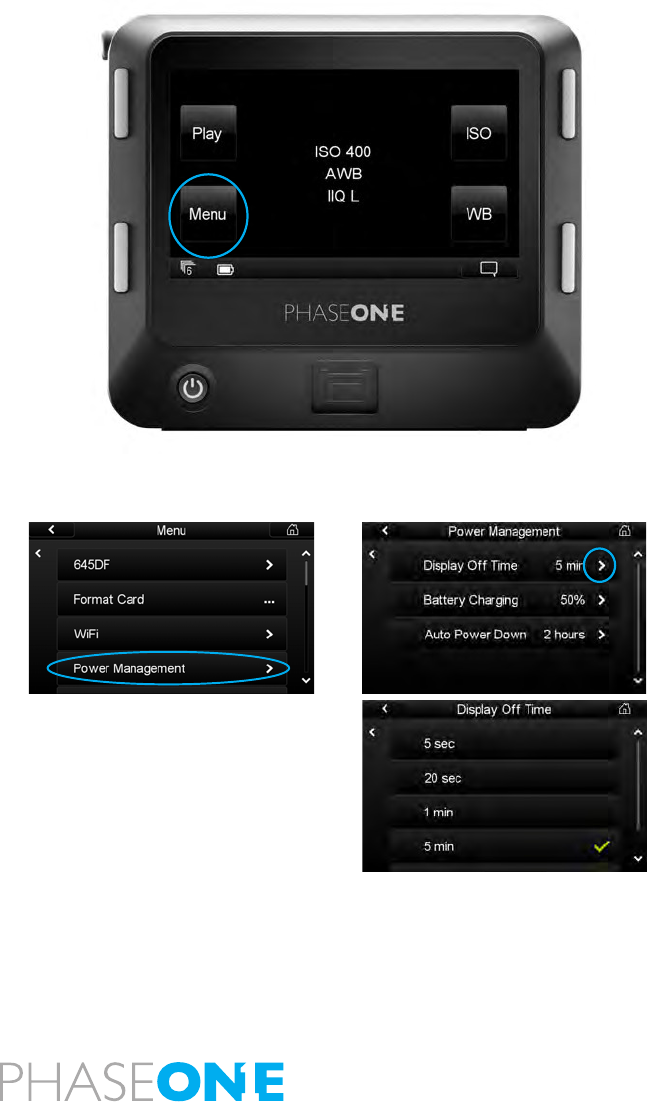
75
7.0 Menu
The Menu can be accessed by either pressing the lower left exterior button
or by tapping Menu directly on the Home Screen.
The Menu can be navigated by using the touch screen functionality or by
following the Enter, Exit, Up and Down arrows and pressing the corresponding
buttons on the IQ2 back.
Long press the upper left (external) button to exit the Menu mode at any
time.
This section will explain the function of each Menu option. All the options in
the Menu section have a default setting so that an IQ2 back is ready to use,
straight out of the box. But the Menu has numerous options that can be used
to congure the setup of the IQ2 back to your specic needs. Some options
have submenus that are indicated by another arrow pointing to the right
side as shown in the Power Management menu. (Left)
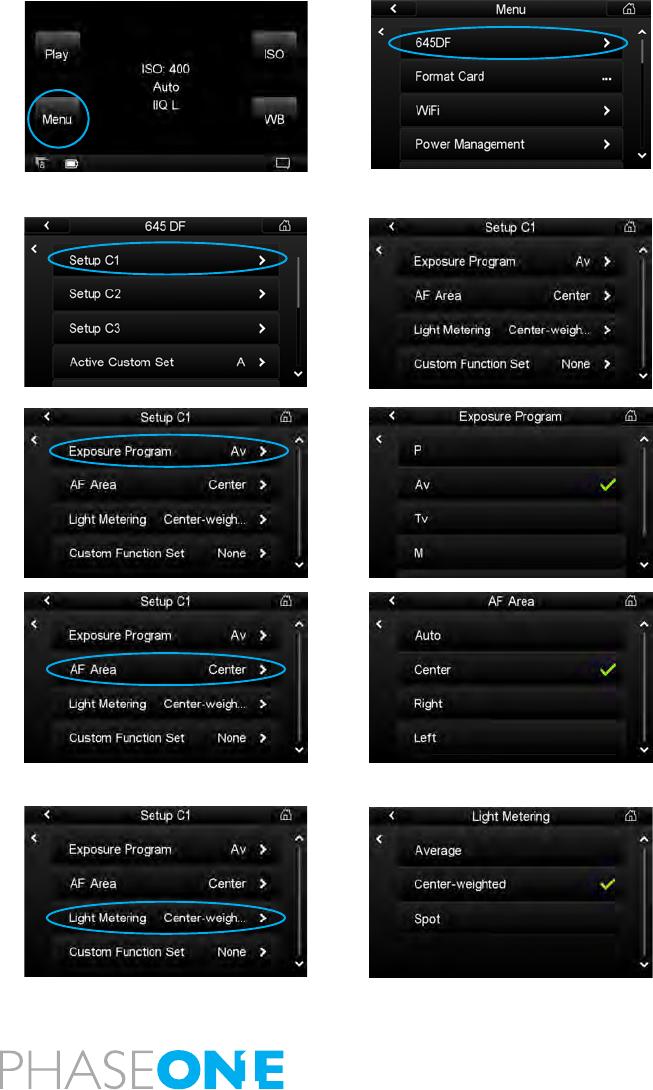
76
7.1 645DF+ (Custom Functionality)
(645 DF pages 76- 83. Click here to skip to next menu section)
The IQ back enables users to set-up custom camera settings when it is used
with a Phase One 645DF+ camera. Access the custom functionality via Menu
> 645 DF. The 645 DF menu option is only present on Mamiya mount IQ
backs. The 645 DF needs to need switched on to access this menu.
Go to page 110 for more information about the 645DF/DF+ custom functions.
7.1.1 Setup C1, C2 or C3
Select Setup C1, C2 or C3 and choose the desired camera exposure, AF and
light meter settings as detailed from 7.3 to 7.5.
7.1.2 Exposure Program
Choose either the X-Mode, P (Program), Av (Aperture Value), Tv (Time Value),
or M (Manual) Exposure Program that you want to use.
Go to page 33 to nd out more about the 645DF+ exposure modes.
7.1.3 AF Area
Select one of the four AF Area settings. The 645DF+ has three AF points that
can be selected individually. The Auto mode (also referred to as Multi Area
Focus) will lock on to the object closest to the camera if multiple objects are
located within the focus frame.
Go to page 34 to nd out more about the 645DF+ AF Area modes.
7.1.4 Light Metering
Select one of the three Light Metering mode.
Go to page 31 to nd out more on the 645DF+ Light Metering modes.
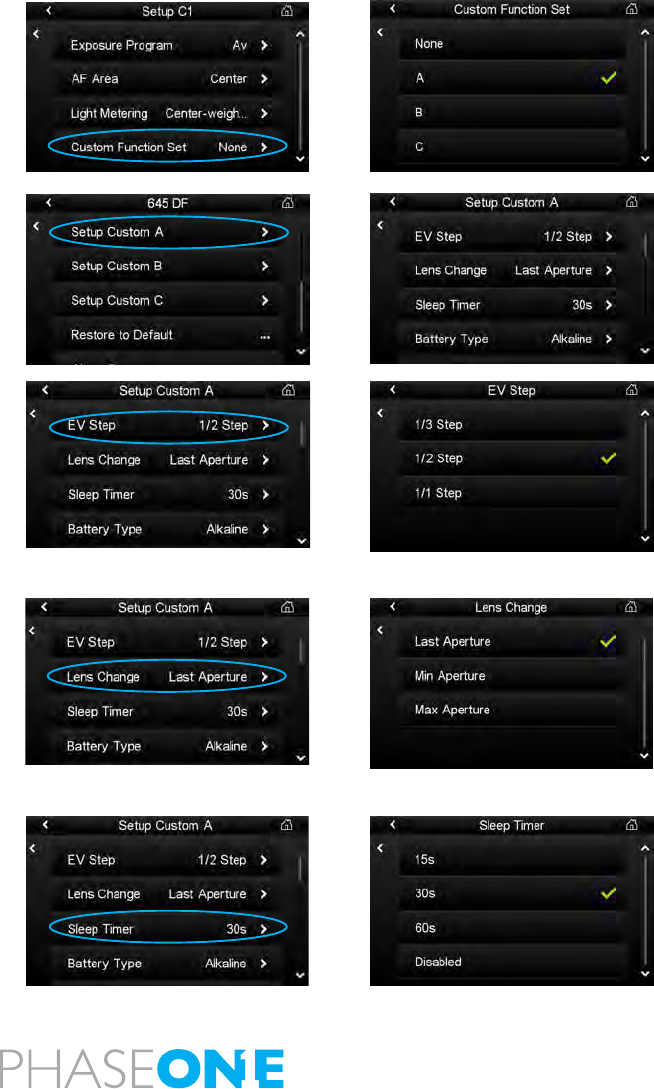
77
7.1.5 Custom Function Set
Assign the letter A, B or C to the chosen exposure mode settings in the
Custom Function Set menu.
N.B. It is possible to see the selected Exposure modes settings from the Setup
C1, 2, 3 menu without having to go into the next menu option.
7.1.6 Setup Custom A, B or C
The Setup Custom menu enable users to adjust and select 19 camera
parameters to attain a precise custom camera set-up. Select either A, B or C.
7.1.7 EV Step
Choose the size of increment adjustments concerning the shutter speed,
f-number and exposure compensation value.
For example, choose 1/1 Step to adjust the aperture value in full f-stop
increments as follows: f2.8, f4, 5.6, f8, f11, f16, f22 etc. Alternatively, choose
1/3 Step to change the aperture setting in smaller increments as follows:
f2.8, f3.2, f3.5, f4, f4.5, f5, f5.6, f6.3, f7.1, f8, f9, f10, f11, f12, f14, f16 and so on.
7.1.8 Lens Change
Choose the desired aperture setting option when a lens is changed on the
645DF+ body. The Last Aperture option adjusts the new lens aperture to
the same setting as the previously used lens when it was removed. The Min
Aperture setting will open the aperture to its fastest setting e.g. f2.8. The
Max aperture choice automatically sets the new lens to its smallest setting
e.g. f22
7.1.9 Sleep Timer
The Sleep Timer menu has three settings that will put the camera body into
sleep mode after either 15, 30 or 60 seconds of inactivity after the camera
power has been switched on (via the Drive Dial). This sleep function helps
prolong the camera’s battery life. Half or full press the camera’s shutter
button to wake the camera. Select the Disabled option to ensure the camera
remains permanently on while the Drive Dial is set to S, C or M.UP.
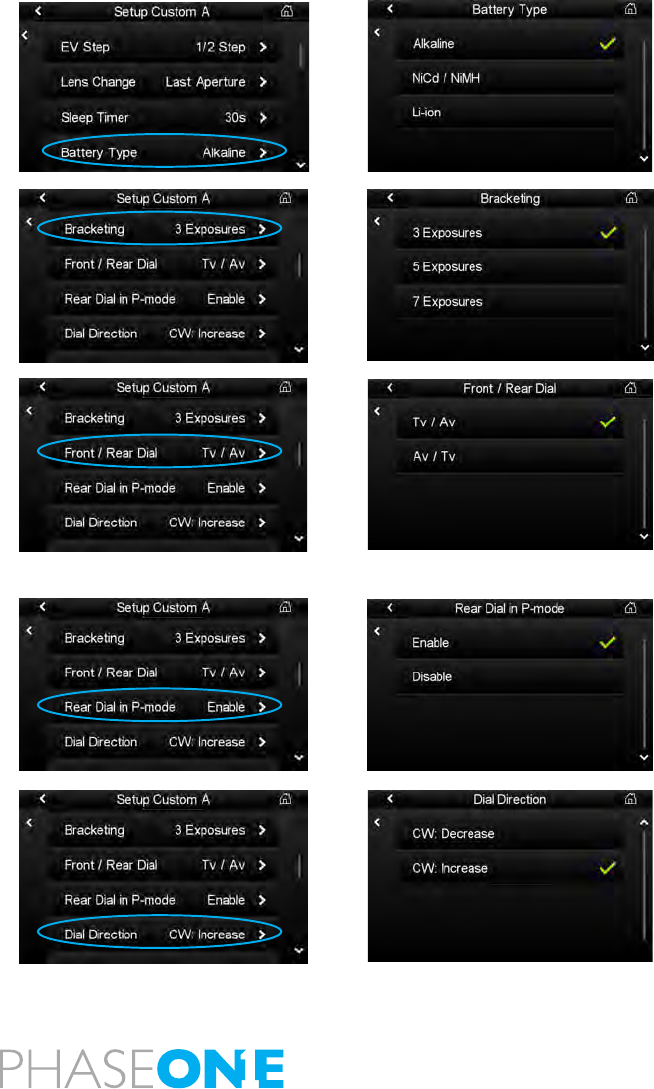
78
7.1.10 Battery Type
The Phase One 645DF+ can be powered by three dierent battery types.
Select the battery type that you want displayed on the external LCD panel to
ensure the remaining battery charge is correctly displayed.
7.1.11 Bracketing
Select 3, 5 or 7 Exposures as the bracketing width for the auto bracketing
setting. Bracketing has to be activated via the 645DF+ camera body controls.
Go to page 100 to nd out more on Bracketing.
7.1.12 Front / Rear Dial
Interchange the function of the front and rear dials when the 645DF+ camera
is used in Manual exposure mode (M). Select Tv / Av to assign the front dial to
adjust the shutter speed (Tv = Time value) and the rear dial to the Aperture
value (Av). The Av /Tv reverses the aforementioned settings.
7.1.13 Rear Dial in P-mode
Assign which dial is used to alter the shutter and aperture value when
shooting in Program (P) exposure mode. Select Enable to use the rear dial in
P mode. Select the Disable option to activate the front dial.
Go to page 38 for more information about the Program exposure mode.
7.1.14 Dial Direction
Choose whether the front and rear exposure dials increase or decrease the
shutter speed, f-number and exposure compensation when rotated in a
clockwise (CW) direction.
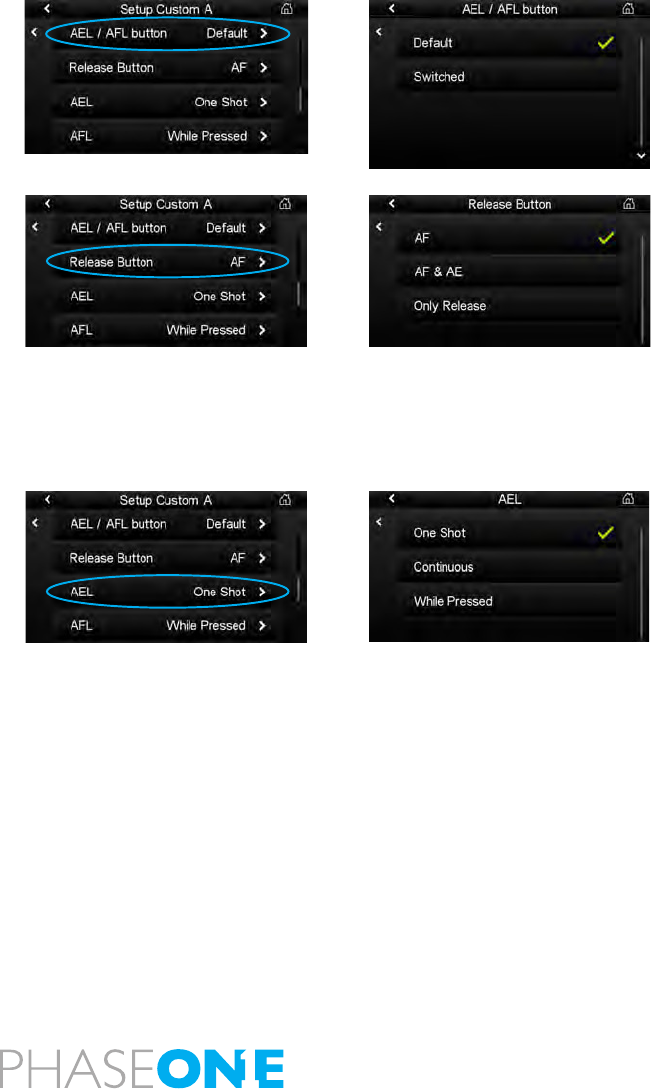
79
7.1.15 AEL / AFL button
Interchange the operations of the front and rear AEL (Auto Exposure Lock)
and AFL (Auto Focus Lock) buttons. Find out the location of these buttons
on page 21.
7.1.16 Release Button
Set the AE Lock and AF operations when the shutter release button is half-
pressed. Select one of the following options:
AF: Activate Auto Focus.
AF & AE: Activate Auto Focus and Auto Exposure Lock.
Only Release: Disable the half-press functionality.
7.1.17 AEL
Assign the function of the AEL button. The AEL button can lock AE (Auto
Exposure) in one of the following ways:
One Shot: Press the AEL button once for the next single exposure to have the
locked setting. This locked exposure setting is released after the shutter is
triggered.
Continuous: Press the AEL button once and all subsequent captures will be
exposed with the locked AEL setting until the AEL button is pressed again.
While Pressed: The AE setting will be locked while the AEL button is pressed.
N.B. The AEL functionality is not applicable when the camera is used in
Manual (M) mode.
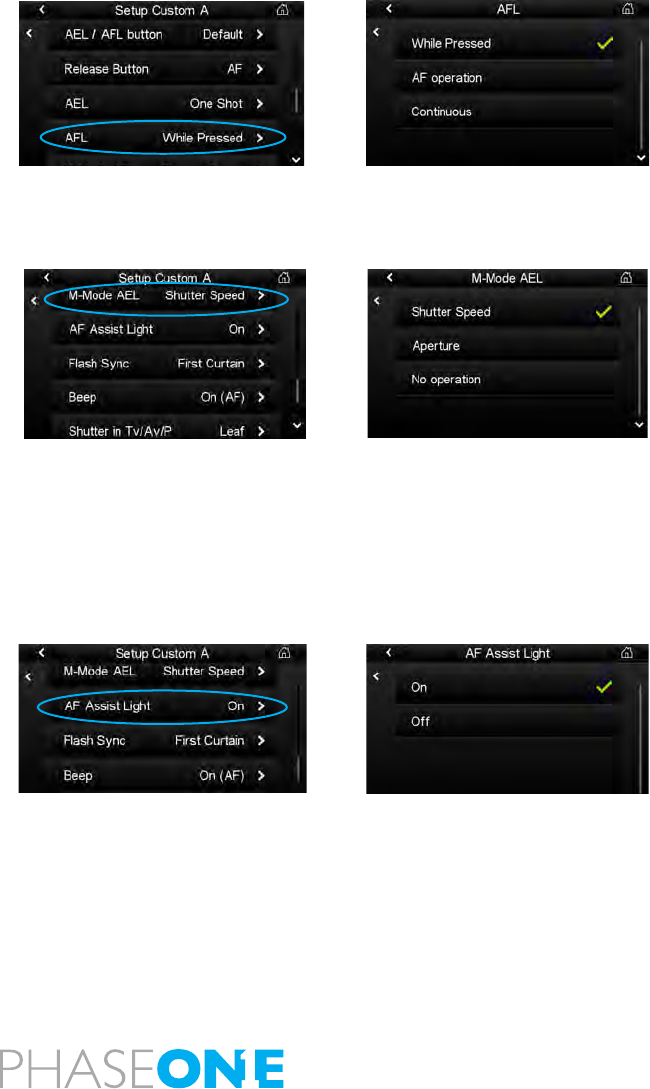
80
7.1.18 AFL
Set the function of the AF Lock button with one of the following options:
While Pressed: Press the AFL to lock focus once.
AF operation: This activates AF every time the AFL button is pressed. (It
performs the same operation as half-pressing shutter button).
Continuous: Locks AF until the AFL button is pressed again.
7.1.19 M-Mode AEL
Assign the AEL button to automatically set an aperture or shutter value when
using M (manual mode). Ensure that the AEL button is pressed for at least
2 seconds to get an aperture or shutter value. Select one of the following
options:
Shutter Speed: A recommended shutter speed will be set when the AEL
button is pressed. The aperture setting will remain unchanged.
Aperture: A recommended f-number will be set when the AEL button is
pressed. The shutter speed setting will remain unchanged.
No operation: This option will disable the AEL button in Manual (M) mode.
7.1.20 AF Assist Light
The AF Assist Light automatically functions to help the performance of Auto
Focus (AF) when shooting in low ambient lighting conditions. The AF Assist
Light can be switched o from this menu. (The AF Assist Light is likely to be
switched o when a ashgun with its own AF Assist lamp is used with the
645DF+ camera).
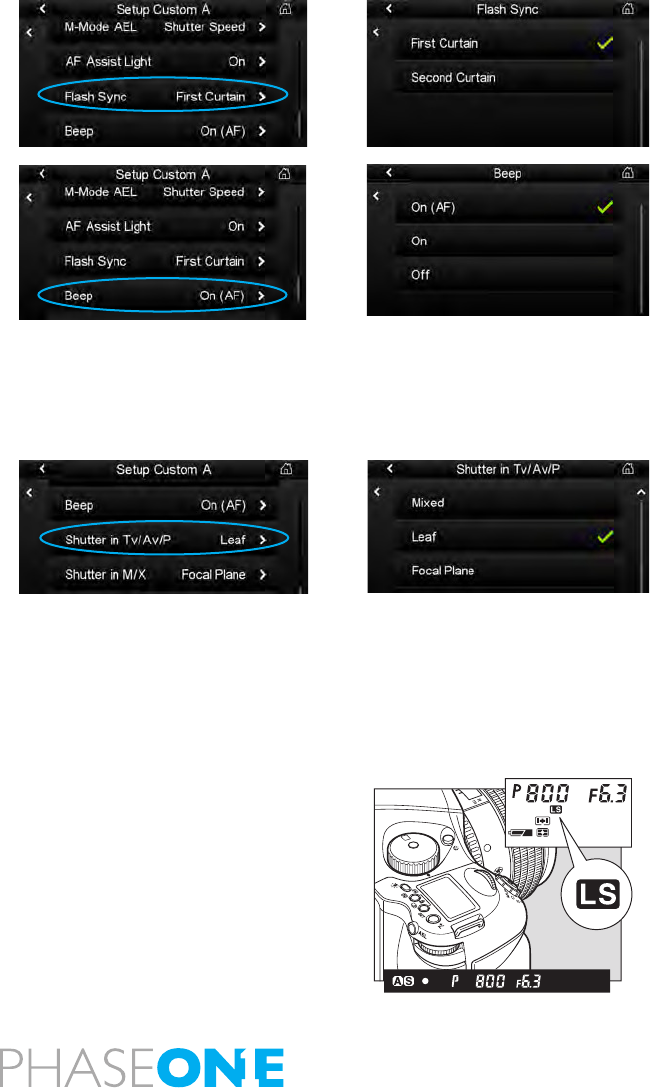
81
7.1.21 Flash Sync
The Flash Sync (synchronization) can be altered to re at the beginning
(First Curtain) or the end (Second Curtain) of an exposure. The First Curtain
mode is the default setting as it is the most commonly used.
7.1.22 Beep
Choose when an audio beep is sounded from the Phase One 645DF+
camera body. Select one of the following options:
On (AF): A beep is sounded when the Auto Focus is set.
On: A beep is sounded when the Auto Focus is set or when any button is
pressed on the 645DF+ camera.
O: The beep sound is disabled.
7.1.23 Shutter in Tv/Av/P
This menu is only applicable when a Phase One 645DF+ camera is used in
either Tv, Av or P exposure modes with a leaf shutter lens. Select one of the
following options:
Mixed: The leaf shutter range from 1 second to 1/1600th second are
selected. Shutter speeds above and below that range use the focal plane
shutter. Flash synchronization is possible on all leaf shutter speeds.
Leaf: Shutter speeds are limited to a leaf shutter range from 1 second to
1/1600th second. Flash synchronization is possible on all shutter speeds.
Focal Plane: Shutter speeds range from 1 minute up to 1/4000th second.
Flash synchronization is only possible from 1/60th to 1/125 second.
(Depending on the ash being used).
N.B. The LCD screen on the Phase One 645DF+ will either display a LS (Leaf
Shutter) or FS (Focal Shutter) icon to correspond to the shutter speed or
custom camera setting.
P
Av
Tv
M
X
CF
C1
C2
C3
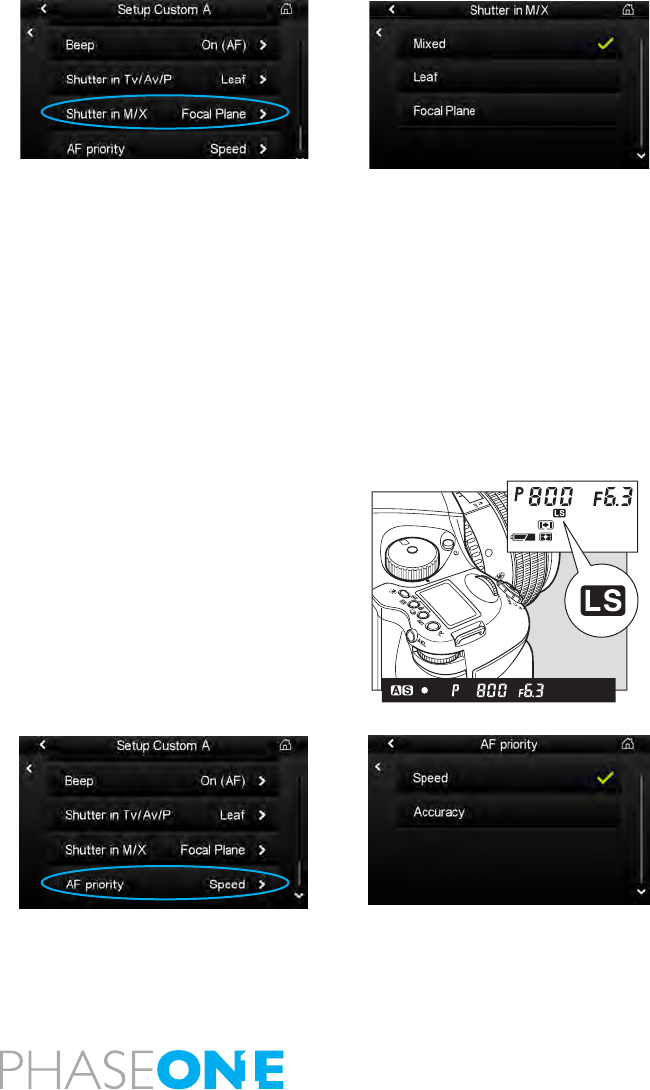
82
7.1.24 Shutter in M/X
This menu is applicable when a Phase One 645DF+ camera is used in
either M or X exposure modes with a leaf shutter lens. Using the X (ash
synchronization) mode limits the shutter speed range from 1/60th second
to 1/125 second irrespective of the selected (Mixed, Leaf or Focal Plane)
mode. Select Manual (M) mode and select one of the following options:
Mixed: The leaf shutter range from 1 second to 1/1600th second are
selected. Shutter speeds above and below that range use the focal plane
shutter. Flash synchronization is possible on all leaf shutter speeds.
Leaf: Shutter speeds are limited to a leaf shutter range from 1 second to
1/1600th second. Flash synchronization is possible on all shutter speeds.
Focal Plane: Shutter speeds range from 1 minute up to 1/4000th second.
Flash synchronization is only possible from 1/60th to 1/125 second.
(Depending on the ash being used).
N.B. The LCD screen on the Phase One 645DF+ will either display a LS (Leaf
Shutter) or FS (Focal Shutter) icon to correspond to the shutter speed or
custom camera setting.
7.1.25 AF priority
Select one of the following AF (Auto Focus) priority options:
Speed: This mode is ideal when capturing moving subject matter.
Accuracy: This the default setting. It is particularly recommended when the
Phase One 645DF+ is used with a lens with a long focal length.
P
Av
Tv
M
X
CF
C1
C2
C3
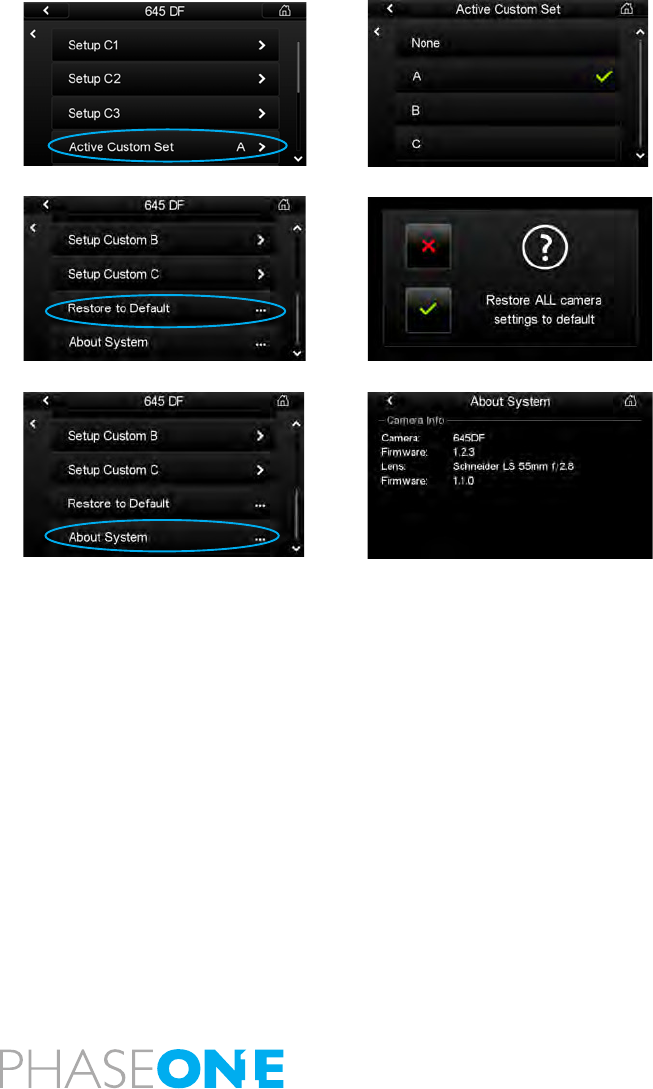
83
7.1.26 Active Custom Set
Select the desired Custom Set for use.
7.1.27 Restore to Default
Select Restore to Default to clear and reset all the current custom settings to
the default. Warning! This cannot be undone once selected.
7.1.28 About System
This menu screen displays the make and model of the camera and lens being
used with the IQ2 back. Remember to check the camera rmware number
against the latest version. Go to www.phaseone.com/Downloads to get
latest rmware version for the 645DF+ camera and IQ2 back.
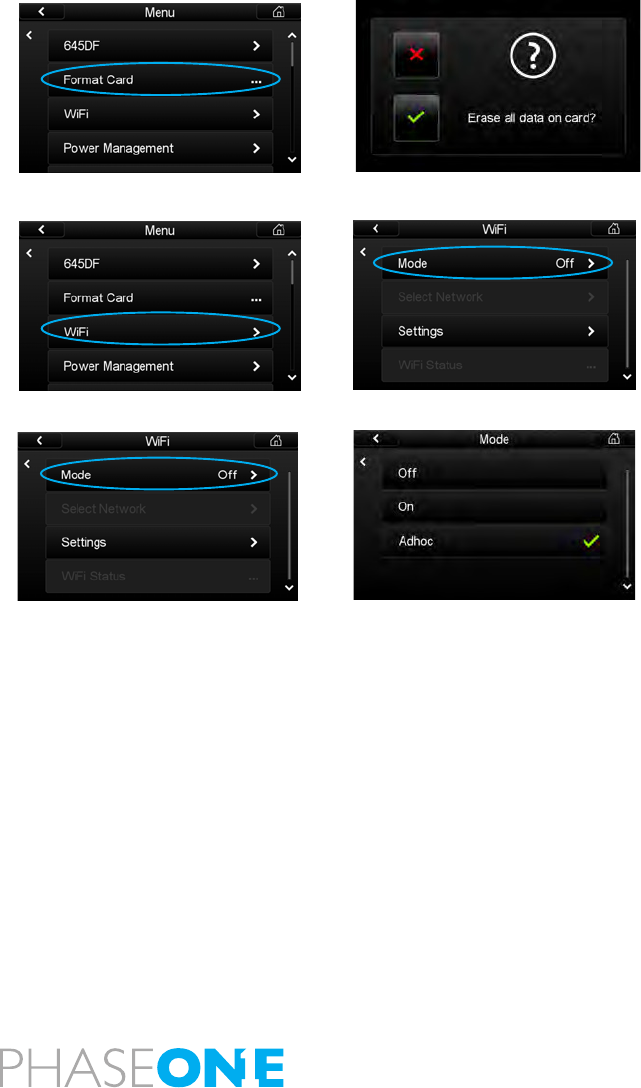
84
7.2 Format Card
Select Format Card to erase all data on a memory card. Memory card
formatting is done in either FAT 16 or FAT 32 depending on card size. (IQ2
backs support CompactFlash cards formatted in both FAT 16 and FAT 32).
7.3 WiFi
All IQ2 digital backs can connect wirelessly with an iOS device like an iPad®
or iPhone®. Before you start, download and install Capture Pilot on your iOS
device from the Apple App Store.
There are two primary ways to connect your IQ2 digital back to an iOS device:
direct for a range of up to 8m/25ft or via a router for a range up to 30m/100ft.
Connect directly using Adhoc mode
1. Go to Menu>WiFi>Mode and tap the Adhoc option. This will publish a
network with default name “PhaseOne[seial number]”
2. From the iPad®/iPhone®: General>WiFi>Connect to network:
“PhaseOne[seial number]”
3. Start Capture Pilot and select the “PhaseOne[serial number]” under Local
Servers
N.B In the iPad Wi-Fi settings use the Icon to unfold the network settings of
the IQ2 network – then switch on the “Auto-Join” to ensure that the
connection will always reconnect if it looses connection.
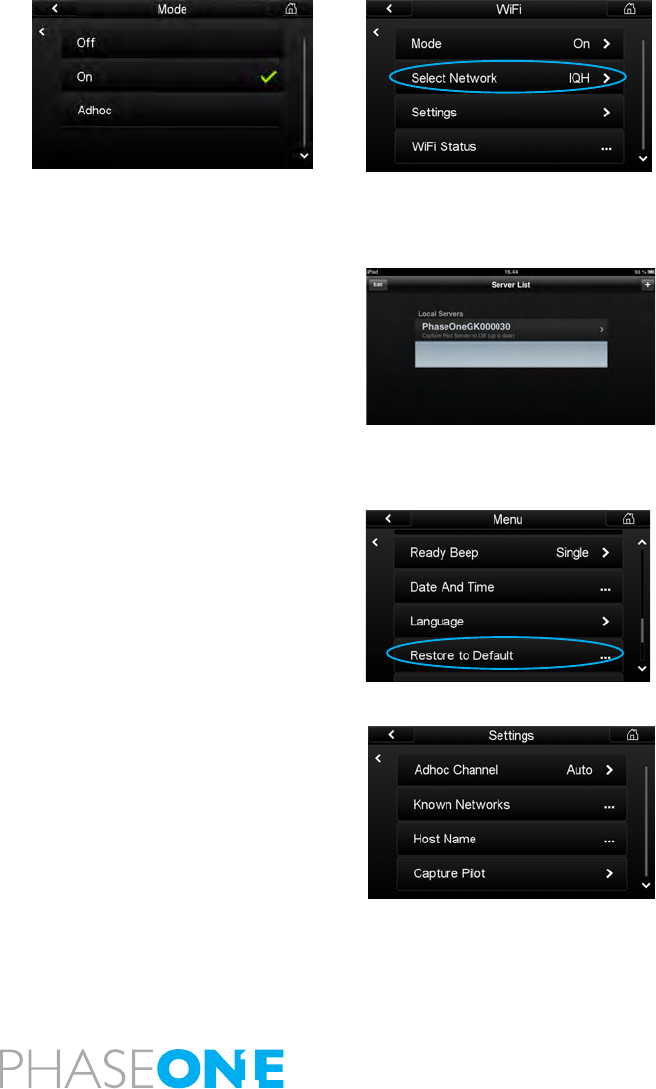
85
Setting up your IQ2 to connect via Router
1. Turn on WiFi: Menu>WiFi>Mode>On
2. Select network: Menu>WiFi>Select Network
3. Type user name and password as prompted from the network.
Connecting Capture Pilot to your IQ2 when using router:
1. From General>WiFi: Select same network as selected on IQ2
2. Open Capture Pilot.
3. Select “PhaseOne[seial number]” under Local Servers in Capture Pilot
To reset all WiFi settings, including all network settings and pin code use:
Menu>Restore to Default
On the IQ260 you can change the hostname, set a pin code or select a
specic network channel under: Menu>WiFi >Settings
N.B. Only basic ASCII (i.e. basic English) characters are supported when
working wirelessly with host names, user names and passwords.
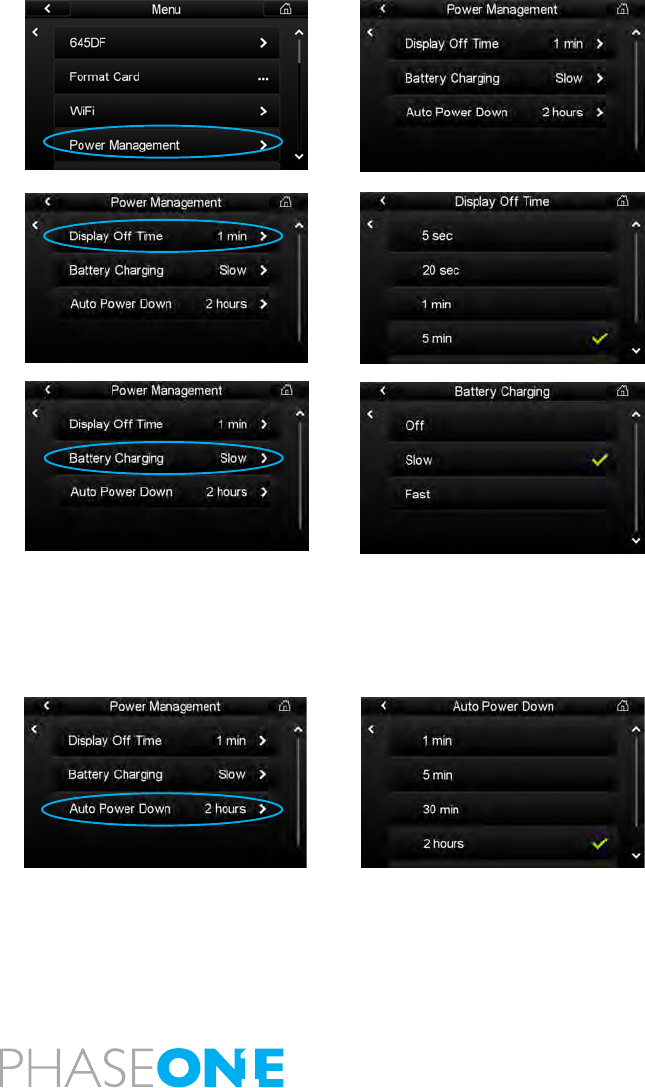
86
7.4 Power Management
The Power Management menu option has three criteria to help preserve
battery life and help keep operating temperatures low when working in hot
conditions. (See below and page 85 for more details).
Display O Time
Switch o the IQ’s display screen after 5 seconds, 20 seconds, 1 minute, 5
minutes. The display can also be set to remain permanently on while the IQ
is in operation with the Always On option.
Battery Charging
The IQ back has an integrated battery charger to ensure that the battery
is charged when shooting tethered via a USB or FireWire connection.
This function can be switched o or set to Slow or Fast. The Slow and O
settings should be chosen to preserve the battery life of a laptop when
shooting tethered.
N.B. The battery will only charge via a USB or FireWire connection when the
IQ back is switched on. Only after it has been switched on, will it continue
to charge when it is turned o. Battery charging is indicated by an orange
LED on the rear of the IQ back when it has been turned o.
Auto Power Down
Auto Power Down determines the amount of time before the IQ back shuts
down, when there is no activity. Choose 1 minute, 5 minutes, 30 minutes, 2
hours or deactivate this function by selecting O.
Press the Power button to switch on and restart the IQ back after it has shut
down.
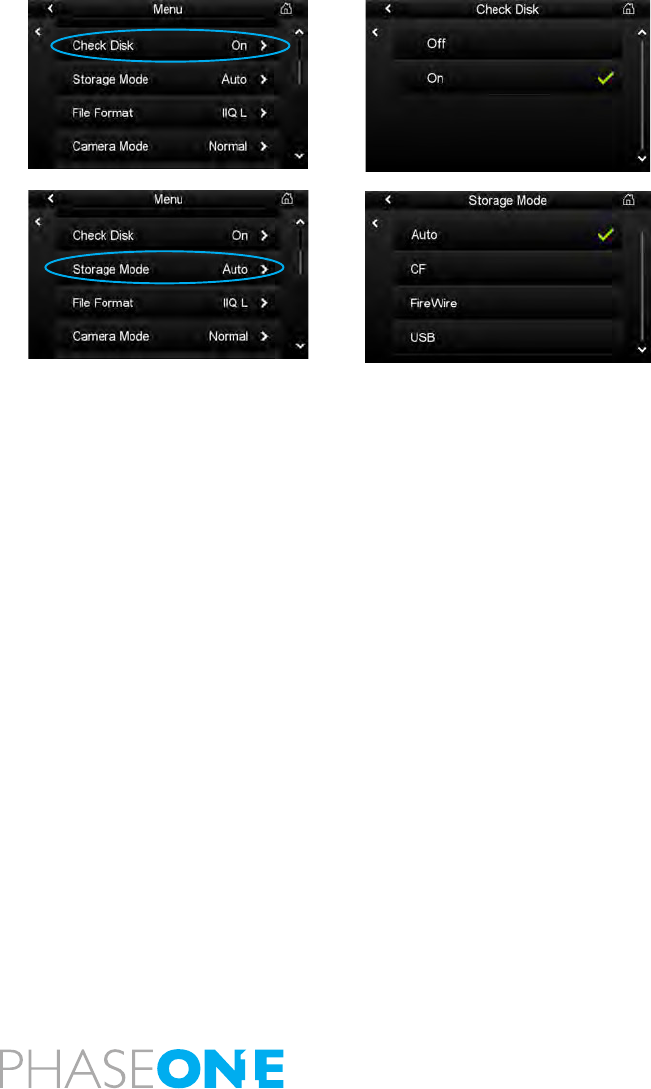
87
7.5 Check Disk
A disk check is performed on every memory card that is inserted into the IQ2
back. Phase One recommends leaving this feature turned on, to maximize
data security on the memory cards. This feature can be deactivated in this
menu. Read more about the Phase One Secure Storage System on page 56
of this User Guide.
7.6 Storage Mode
Storage allows users to congure how an IQ2 back should store the captures
created. Auto is the default storage setting and it will detect and automatically
store images les to a memory card if it has been inserted in the IQ2 back.
If the IQ2 back is being used to shoot tethered, it will store image les directly
to the computer via the connected USB2 or FireWire 800 cable. The USB2 or
FireWire will have priority if a card is in the IQ2 back at the same time as it is
connected by USB2 or FireWire to a computer.
N.B The IQ2 back can be forced to shoot to either CompactFlash or via a
FireWire 800 or USB2 or cable to a computer by selecting CF, USB2 or FireWire
respectively. An Error Message will appear on the IQ2 screen if the IQ2 back is
not tethered to a computer and the IQ2 card slot is empty.
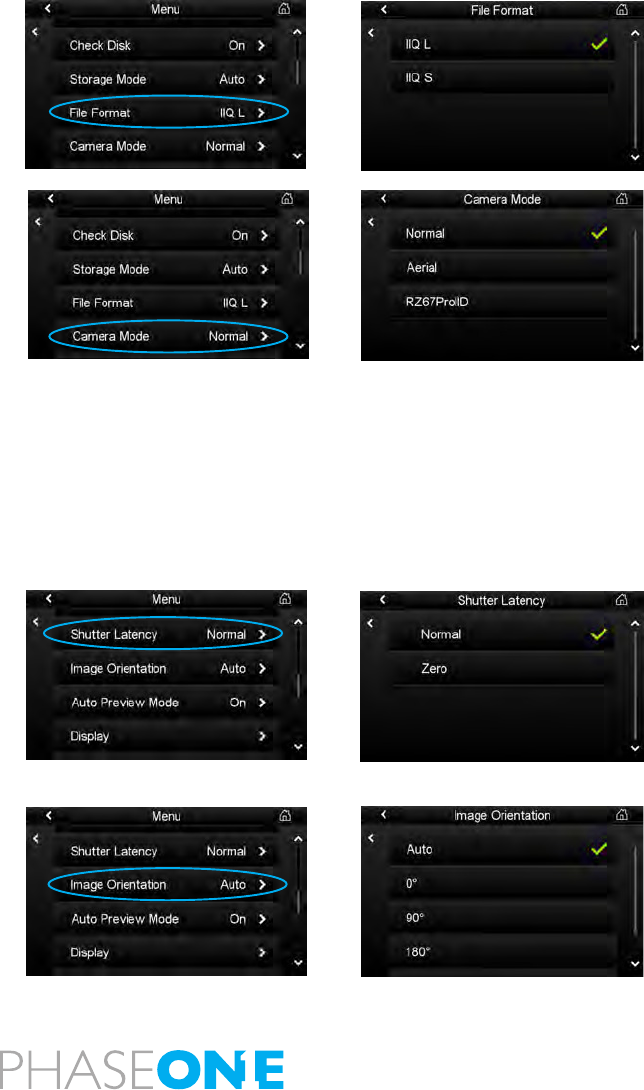
88
7.7 File Format
An IQ back can save les in two dierent formats; IIQ Raw L and IIQ Raw S. IIQ
stands for Intelligent Image Quality Raw. IIQ L is the default setting and it is
a lossless capture format. IIQ S is a smaller le that is not a totally lossless format.
The IIQ L is approximately 1/3 le size of a processed TIFF le. IIQ S is approximately
1/5 of a processed TIFF.
7.8 Camera Mode
There are two primary choices in the Camera Mode menu. Mamiya mount
IQ backs have three choices. Select one of the following options:
Normal: The recommended default setting.
Aerial: This mode is design for highly specialist purposes only. It is not rec-
ommended for use without consultation. Contact your Phase One dealer to
nd out more about the Aerial mode.
Warning! Images will be degraded in the Aerial mode unless used with
specialist hard/software.
RZ67ProIID: This mode is designed to optimize the IQ back’s operating per-
formance with the Mamiya RZ67 Pro IID camera body.
7.9 Shutter Latency
The IQ CCD is put to sleep to reduce power consumption when it is not in
use. The IQ needs to wake up before shooting and the timing of this wake
up signal is referred to as the Latency. The recommended setting is Normal
Latency if the IQ is used with the Phase One 645DF+. Only change to Zero
Latency if you work on technical, large format cameras or certain manual
cameras in special situations. Find out more in the Appendix from page 128.
7.10 Image Orientation
The Image Orientation function sets and stores the orientation of all
subsequently captured images. Select 0, 80, 180 or 270 to force the back to
mark images as captured with that orientation. The Auto setting uses the
back’s built in orientation sensor to determine the orientation at the moment
of capture. Changing this setting will not aect how captured images are
displayed on the LCD.
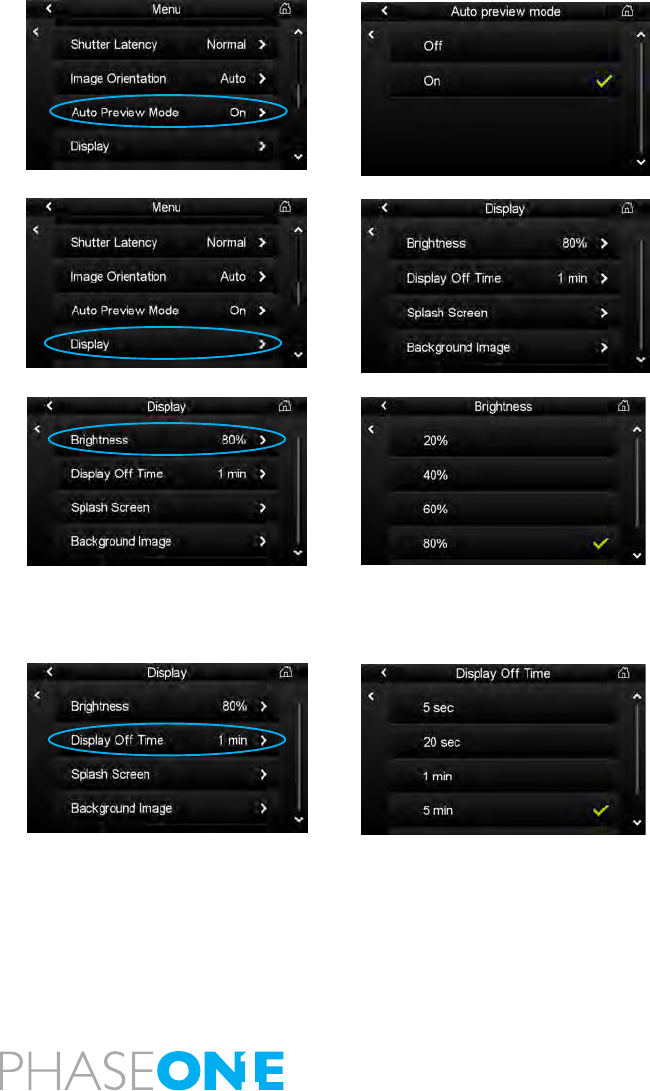
89
7.11 Auto Preview Mode
The Auto Preview option can be switched On or O. Select On to revert to a
Play mode when shooting. Select O to remain on the same display.
7.12 Display
The Display menu option has four options: Brightness, Display O Time,
Splash Screen and Background Image. (See below and page 88 for more
details).
Brightness
Set the brightness of the preview LCD screen to suit ambient viewing
conditions. The default setting is 80% but in bright outdoor illumination
this can be increased up to 100%. Users may choose to lower the Brightness
when working in low light environments, such as a photographic studio.
Altering the Brightness setting will only aect the brightness of the screen.
It will NOT aect the Exposure Warning, Histogram and exposure of a nal
capture.
Display O Time
Switch o the IQ’s screen after 5 seconds, 20 seconds, 1 minute, 5 minutes.
The display can also be set to remain permanently on while the IQ is in
operation with the Always On option.
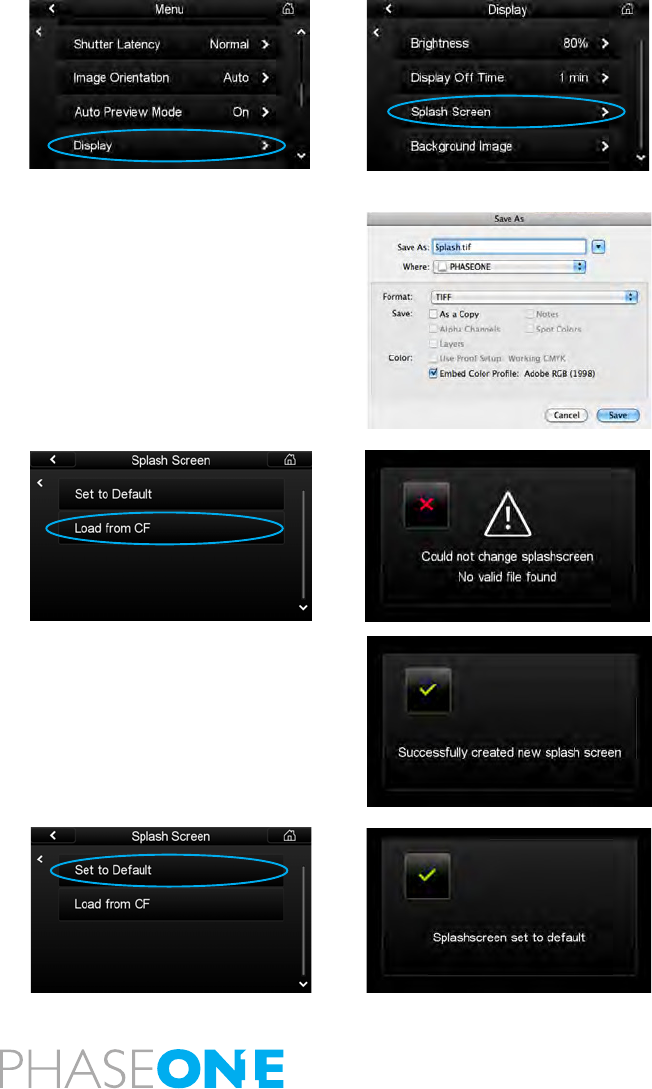
90
Splash Screen
Follow the proceeding steps to customize the splash screen on the IQ back.
1.Save the image le to a maximum 800 x 480 pixels resolution (landscape
format). A smaller le will also be accepted and placed in the center of the
screen with the surrounding space lled with black.
2. Save the le as a 24 bit BMP or 24 bit TIF format le. Name the le ‘Splash’
followed by the le extension. E.g. Splash.bmp or Splash.tif.
3. Transfer the Splash.bmp or Splash.tif le onto a CompactFlash card. En-
sure it is not in any sub-folder.
4. Insert the CompactFlash card into the IQ back and select Menu > Display
> Splash Screen > Load from CF. An error screen will appear if the le is in a
sub-folder or named incorrectly.
5. A conrmation screen will appear stating that a ‘Successfully created new
splash screen’. The image will appear on-screen each time the IQ back is
switched on.
6. Select Set to Default to remove the selected splash screen and return to
a blank black splash screen. A conrmation screen will appear stating that a
‘Splashscreen set to default’.
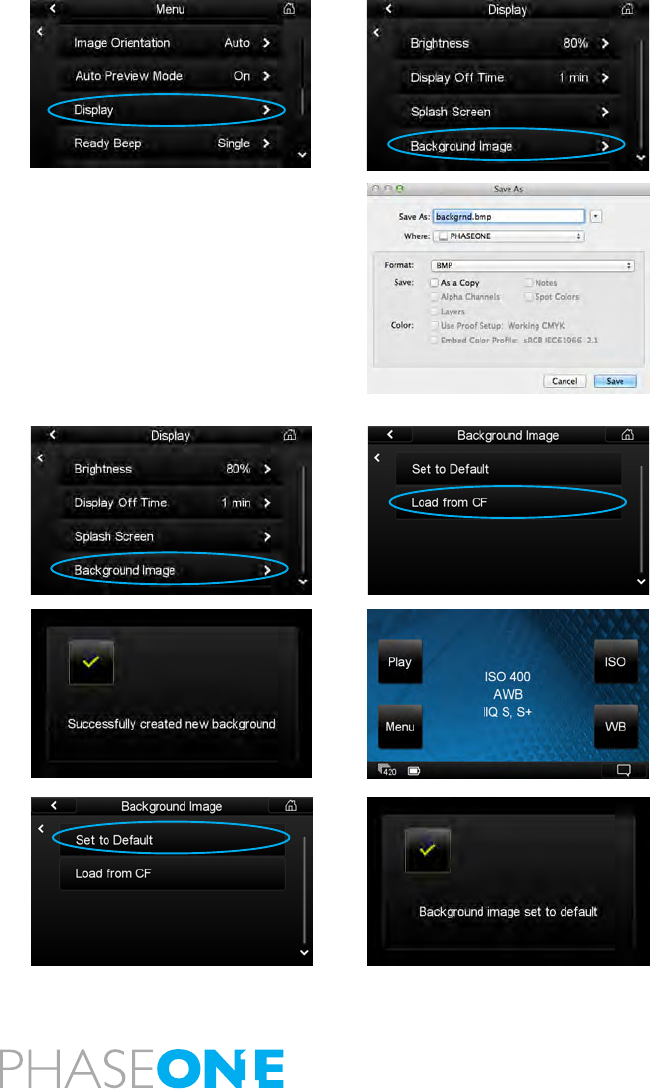
91
Background Image
Customize the background image on the IQ back Home Screen.
1.Save the image le to a maximum 800 x 480 pixels resolution (landscape
format). A smaller le will also be accepted and placed in the center of the
screen with the surrounding space lled with black.
2. Save the le as a 24 bit BMP or 24 bit TIF format le. Name the le
‘backgrnd’ followed by the le extension. E.g. backgrnd.bmp or
backgrnd.tif. Transfer the backgrnd.bmp or backgrnd.tif le onto a Com-
pactFlash card. Ensure it is not in any sub-folder.
3. Insert the CompactFlash card into the IQ back and select Menu > Display
> Background Image > Load from CF. An error screen will appear if the le is
in a sub-folder or named incorrectly.
4. A conrmation screen will appear stating that a ‘Successfully created new
background’. The image will now appear on the Home Screen.
5. Select Set to Default to remove a background image and return to a
blank black Home Screen. A conrmation screen will appear stating ‘Back-
ground image set to default’.
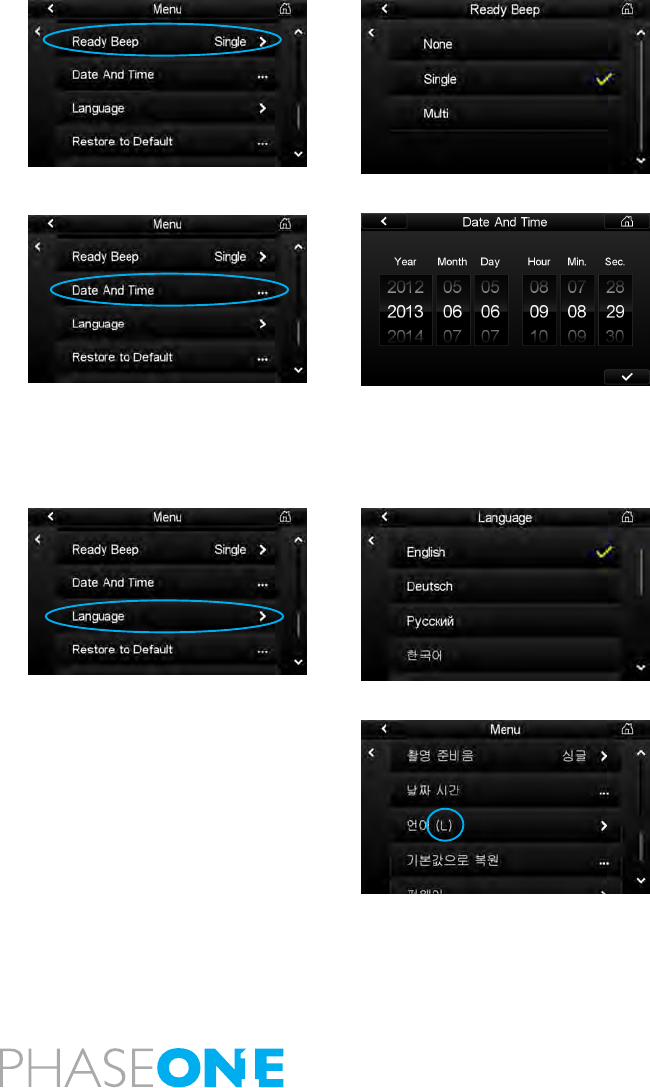
92
7.13 Ready Beep
The IQ back will emit a small audio beep after every capture is taken. This
Ready Beep signals that a capture has been completed, and that the IQ
back is ready for next shot.
The Ready Beep can set to either None, Single or Multi. The default setting
is Single. Multi is ideal for use in noisy surroundings. None deactivates the
audio Beep noise.
7.14 Date and Time
Set the Date and Time to your local time zone. The default Date and Time
is GMT+1. Tap the screen and scroll through the numbers to attain the
appropriate date and time. Tap the check mark icon, which will appear in
the bottom right hand corner of the screen to conrm your entry. The time
and date is applied to the EXIF data in all les captured with the IQ back.
If the IQ back has been without power for a long period of time, it will
automatically ask you to set the time and date on the next occasion it is
powered up.
7.15 Language
Is it possible to change the default English language setting for the IQ
user interface and menu system to one of nine others including German,
French, Swedish, Italian, Spanish, Chinese (simplied), Japanese, Korean
and Russian.
N.B. If a language is selected that is not understandable, select the menu
option with the ‘(L)’ to reselect. (See example circled left)
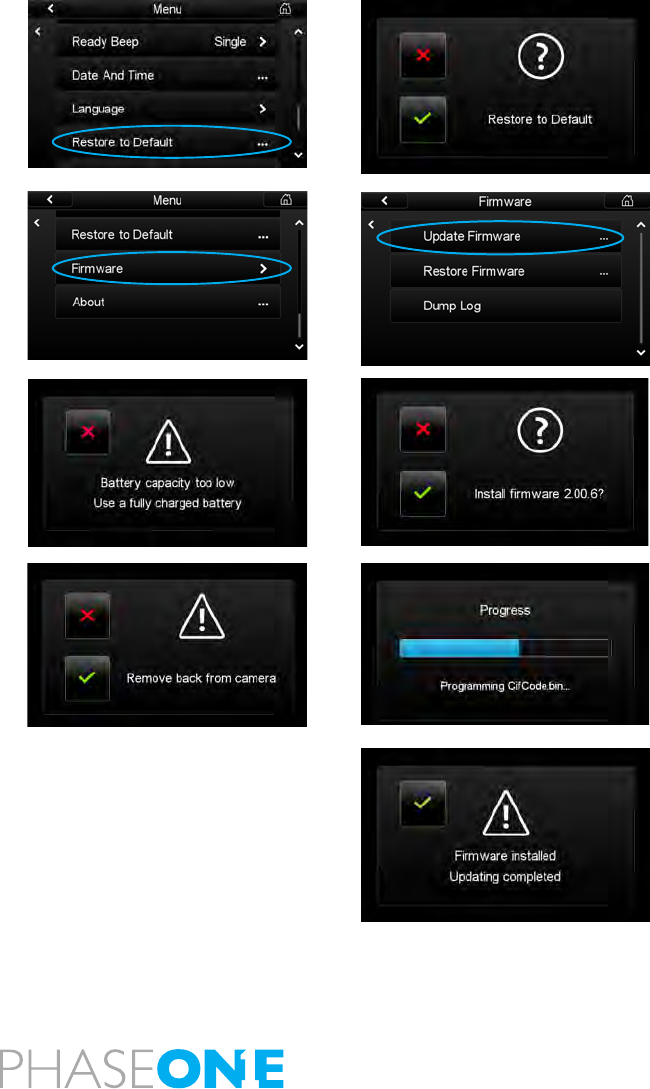
93
7.16 Restore to Default
Select Restore to Default to restore the IQ unit back to its default factory
settings. Caution! All previous settings will be lost.
7.17 Firmware
It is important to keep the IQ’s rmware up-to-date to ensure you get new
features and remove any bugs or errors from previous rmware versions.
1. Download the latest rmware update from
www.phaseone.com/ Downloads
2. Transfer the rmware (.fwr) le to a CompactFlash card and insert it into
the IQ’s card slot. Go to Menu > Firmware > Update Firmware. It is not pos-
sible to update the rmware unless the digital back battery is fully charged.
A warning screen will appear if the battery life is too low. (See far left). Tap
the green check mark to install the rmware. (See left).
3. Ensure that the IQ back has been removed from the camera. A progress
bar will appear on screen during installation.
4. A conrmation screen will appear once installation is complete. The IQ
back will automatically restart itself.
N.B. It is best practice to perform a hard reboot of the digital back after the
update is complete by unplugging and reinserting the battery.
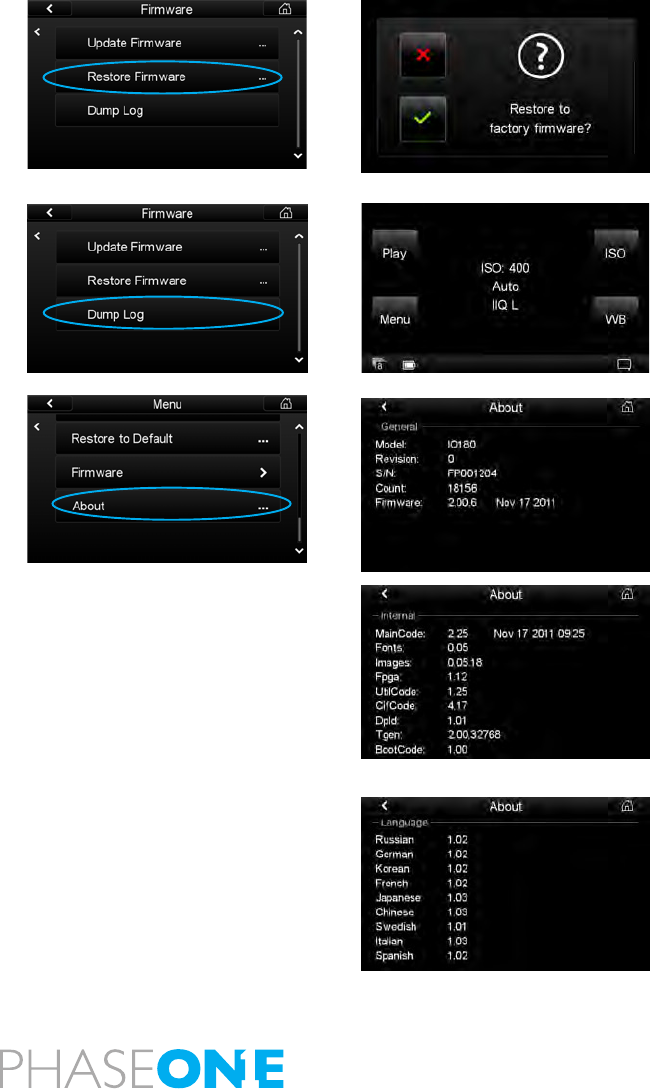
94
Restore Firmware
Select Restore Firmware to revert to the factory rmware version. (Camera
settings are not aected).
Dump Log
Select Dump Log to transfer Log information to a CompactFlash card for
analysis.
7.18 About
The About menu displays technical information about the hardware and
embedded rmware in the IQ back. This is especially useful if support is
needed or if you want to check if Phase One is oering a newer rmware
update. Please make a note of the About menu contents (see left) before
contacting your dealer or Phase One Support.
Scroll down the screen to reveal Internal technical data.
Scroll to the bottom of the screen to reveal Language version information.
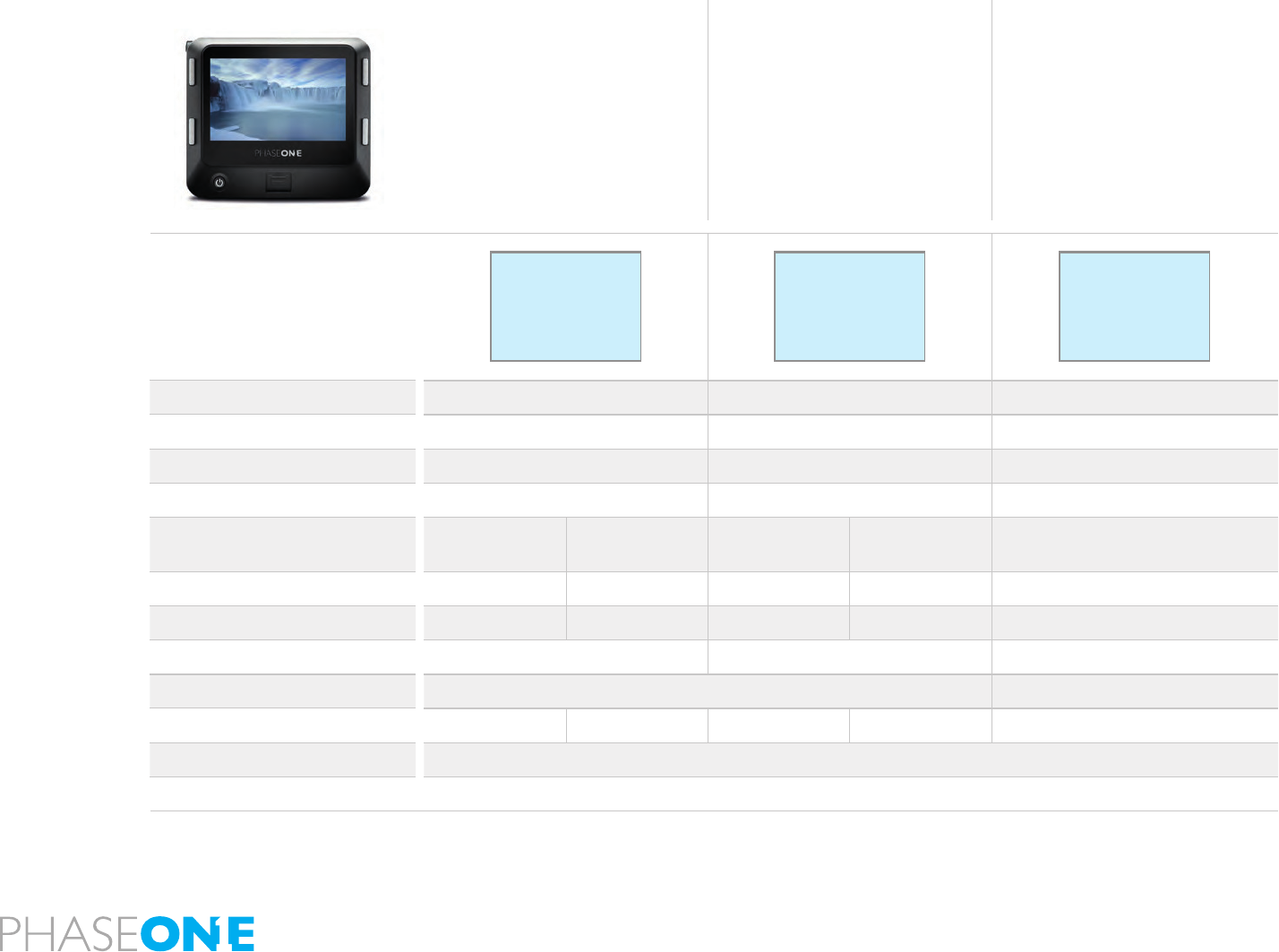
95
8.0 IQ2 Digital Back Overview
1.0 1.0 1.0
53.7 x 40.4 mm 53.9 x 40.4 mm 53.7 x 40.3 mm
10328 x 7760 8984 x 6732 8964 x 6716
5162 x 3878 4490 x 3364 -
Full res.
5.2 x 5.2
Sensor+
10.4 x 10.4
Full res.
6 x 6
Sensor+
12 x 12
Full res.
6 x 6
80 20 60 15 60
35 - 800 140 - 3200 50 - 800 200 - 3200 200 - 3200
1/10.000 sec. - 2 minutes 1/10.000 sec. - 1 hour 1/10.000 sec. - 2 minutes
16bit-OptiColor +, 13 f-stops Dynamic Range 13 f.stops
0.7 0.9 1.0 1.4 1.0
1 GB Advanced high speed RAM
3.2” touch screen with 1.15 megapixels, 290 ppi(dpi), 16 million colors, 170º viewing angle
Sensors
Lens Factor
CCD size effective
Active pixels full resolution
Active pixels Sensor+
Pixel size (micron)
Resolution (megapixels)
Light sensitivity (ISO)
Exposure time
Image quality
Capture time (frames per sec.*)
Image buffer
Display
53.9 mm
40.4 mm
53.7 mm
40.4 mm
IQ280
The IQ280 is the pinnacle of
image quality. The highest
resolution captures of any
commercially available cameras.
The 80 megapixel captures,
dynamic range and unparalleled
image quality makes it an ideal
solution for a wide array of
photographic disciplines.
IQ260
The IQ260 goes beyond the
norm; it’s made for extraordinary
captures. It can deliver long
exposures of up to one hour and
produce 60 megapixel captures
that are virtually noise free.
IQ260 Achromatic
The IQ260 Achromatic offers pure
or interpolation applied. The 60
megapixel captures are stunning
and pin sharp. there are endless
opportunities to create very
distinct imagery both for artistic
*) Maximum expected performance. The actual performance will be dependent on the camera model and on the camera and digital back capture modes.
Content is subject to change without notice
53.7mm
40.3 mm
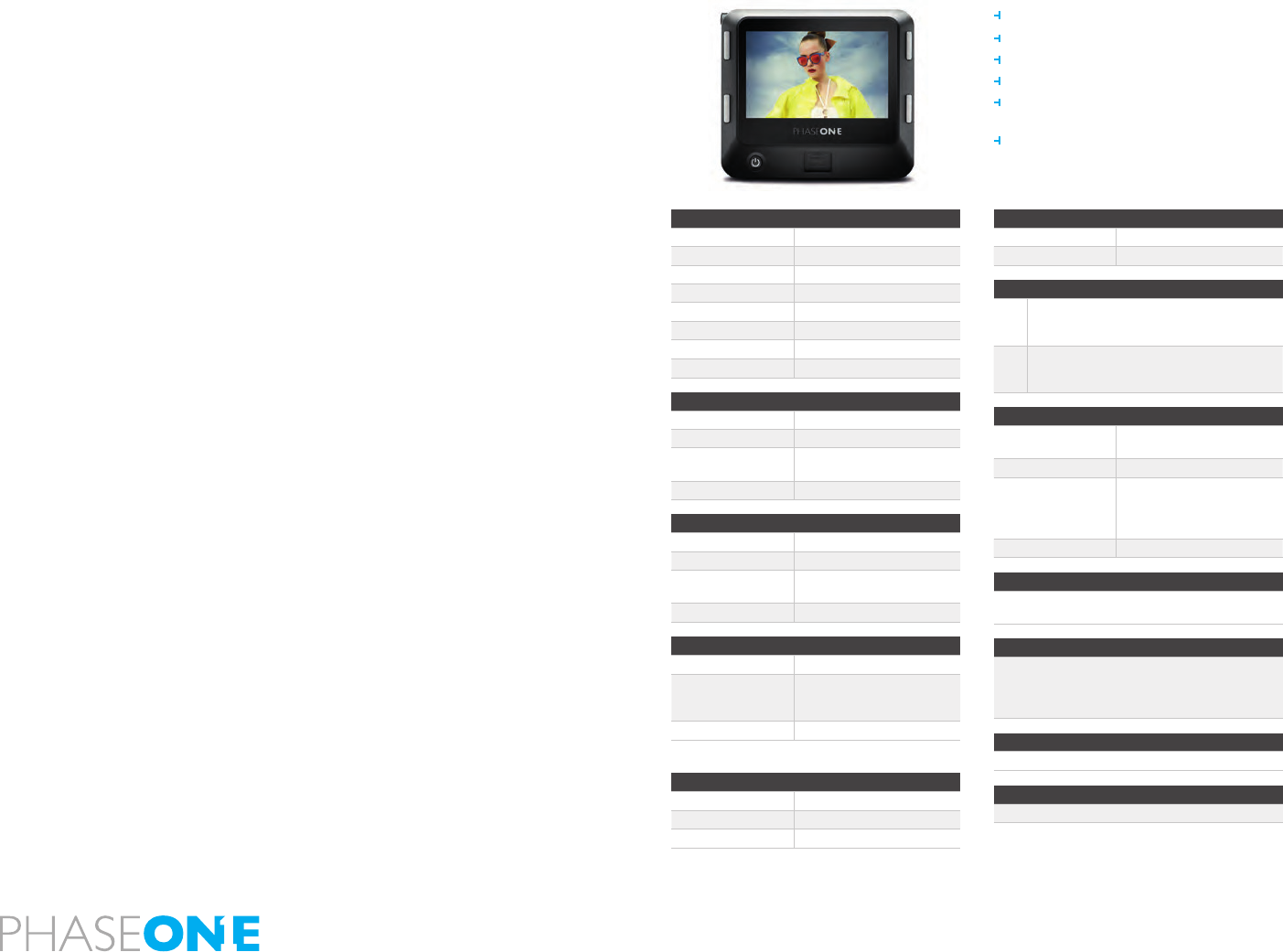
96
8.1 IQ280 Digital Back Specifications
80 megapixel resolution for extreme detail level
645 full-frame CCD
Built in wireless technology
Extreme 13 f-stops dynamic range
1.15 megapixel resolution 3.2” display with
vibrant colors
Touch screen functionality to pan, browse and
zoom up to 400%
IMAGING TECHNOLOGY
CCD Full frame CCD
Lens factor 1.0 / Full frame
Resolution 80 megapixel
Active pixels 10320 x 7752 pixels
CCD size effective 53.7 mm x 40.4 mm
Pixel size 5.2 x 5.2 micron
Image ratio 4:3
Dynamic range 13 f-stops
OPERATING CONDITIONS
Temperature -10º to 50ºC (14º to 122ºF)
Humidity 15 to 80% RH (non-condensing)
IQ BACK MOUNTS
Phase One/ Mamiya Phase One 645DF+/AF
Mamiya 645DF+/AFDIII
Phase One H101 Hasselblad H1 and H2
Hasselblad V
Hasselblad 555ELD, 553ELX, 503CW
and 501CM
Via adaptor: Mamiya RZ67 Pro II
Mamiya RB67
Contax Contax 645AF
WIDE ANGLE & TECHNICAL CAMERAS
4 x 5” via FlexAdaptor: Arca Swiss, Cambo, Linhof, Toyo, Sinar,
Plaubel, Horseman.
SOFTWARE
Capture One 7.1 or later
CERTIFICATIONS
CE
STORAGE FILES
The default IIQ RAW-large format is completely lossless.
COMPUTER MINIMUM REQUIREMENTS
Mac
Fast Intel Core™ 2 Duo or later CPU, 4 GB RAM, Fast HDD:
8800 series graphics card or newer
PC
Intel® Pentium® 4, 4 GB RAM, 64bit,10 GB free hard disk
space, IEEE 1394 interface, Windows XP®, Service Pack 3
or Windows Vista®, Service Pack 1
IQ280 FULL RESOLUTION CAPTURE MODE
Resolution 80 megapixel
Pixel size 5.2 x 5.2 micron
IIQ large: 80 MB
IIQ small: 54 MB
ISO 35, 50, 100, 200, 400, 800
SENSOR + CAPTURE MODE
Resolution 20 megapixel
Pixel size 10.4 x 10.4 micron
IIQ large: 20 MB
IIQ small : 13.5 MB
ISO 140, 200, 400, 800, 1600, 3200
OUTPUT FILES (VIA CAPTURE ONE)
Color depth 16 bit per color
All output formats of Capture One
are possible: TIFF-RGB, TIFF-CMYK,
JPEG
Color management
LCD SCREEN
Size 3.2”
Resolution 1.15 megapixel touch screen
Viewing angle 170º Content is subject to change without notice
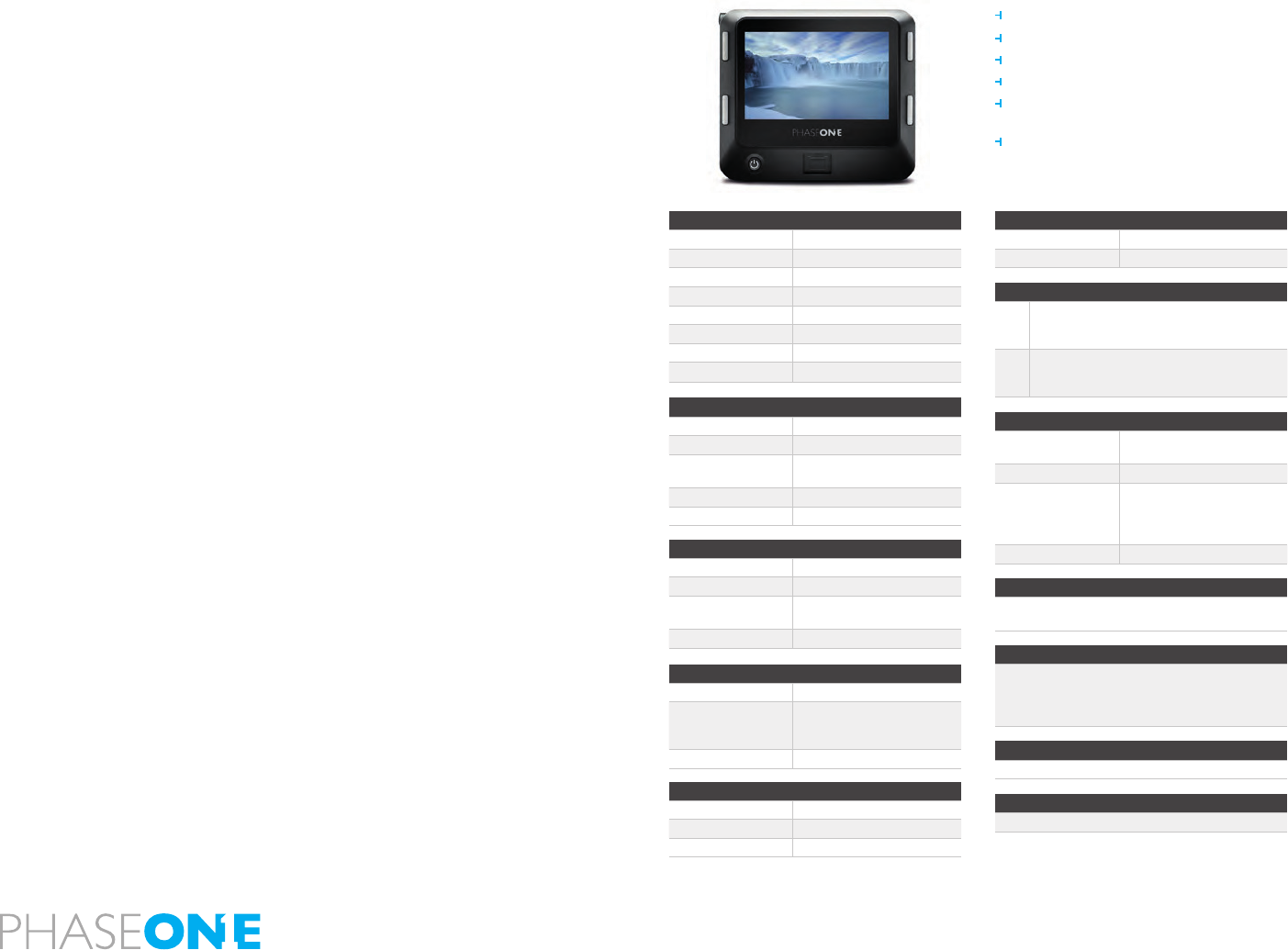
97
8.2 IQ260 Digital Back Specifications
60 megapixel full-frame 645 CCD
Designed for long exposure (up to one hour)
Built in wireless technology
Extreme 13 f-stops dynamic range
1.15 megapixel resolution 3.2” display with
vibrant colors
Touch screen functionality to pan, browse and
zoom up to 400%
IMAGING TECHNOLOGY
CCD Full frame CCD
Lens factor 1.0 / Full frame
Resolution 60 megapixel
Active pixels 8984 x 6732 pixels
CCD size effective 53.9 mm x 40.4 mm
Pixel size 6 x 6 micron
Image ratio 4:3
Dynamic range 13 f-stops
OPERATING CONDITIONS
Temperature -10º to 50ºC (14º to 122ºF)
Humidity 15 to 80% RH (non-condensing)
IQ BACK MOUNTS
Phase One/ Mamiya Phase One 645DF+/AF
Mamiya 645DF+/ AFDIII
Phase One H101 Hasselblad H1 and H2
Hasselblad V
Hasselblad 555ELD, 553ELX, 503CW
and 501CM
Via adaptor: Mamiya RZ67 Pro II
Mamiya RB67
Contax Contax 645AF
WIDE ANGLE & TECHNICAL CAMERAS
4 x 5” via FlexAdaptor: Arca Swiss, Cambo, Linhof, Toyo, Sinar,
Plaubel, Horseman.
SOFTWARE
Capture One 7.1 or later
CERTIFICATIONS
CE
STORAGE FILES
The default IIQ RAW-large format is completely lossless.
COMPUTER MINIMUM REQUIREMENTS
Mac
Fast Intel Core™ 2 Duo or later CPU, 4 GB RAM, Fast HDD:
8800 series graphics card or newer
PC
Intel® Pentium® 4, 4 GB RAM, 64bit,10 GB free hard disk
space, IEEE 1394 interface, Windows XP®, Service Pack 3
or Windows Vista®, Service Pack 1
IQ260 FULL RESOLUTION CAPTURE MODE
Resolution 60 megapixel
Pixel size 6 x 6 micron
IIQ large: 60 MB
IIQ small: 40 MB
ISO 50, 100, 200, 400, 800
Long exposure ISO 140, 200, 400, 800
SENSOR + CAPTURE MODE
Resolution 15 megapixel
Pixel size 12 x 12 micron
IIQ large: 15 MB
IIQ small : 10 MB
ISO 200, 400, 800, 1600, 3200
OUTPUT FILES (VIA CAPTURE ONE)
Color depth 16 bit per color
All output formats of Capture One
are possible: TIFF-RGB, TIFF-CMYK,
JPEG
Color management
LCD SCREEN
Size 3.2”
Resolution 1.15 megapixel touch screen
Viewing angle 170º Content is subject to change without notice
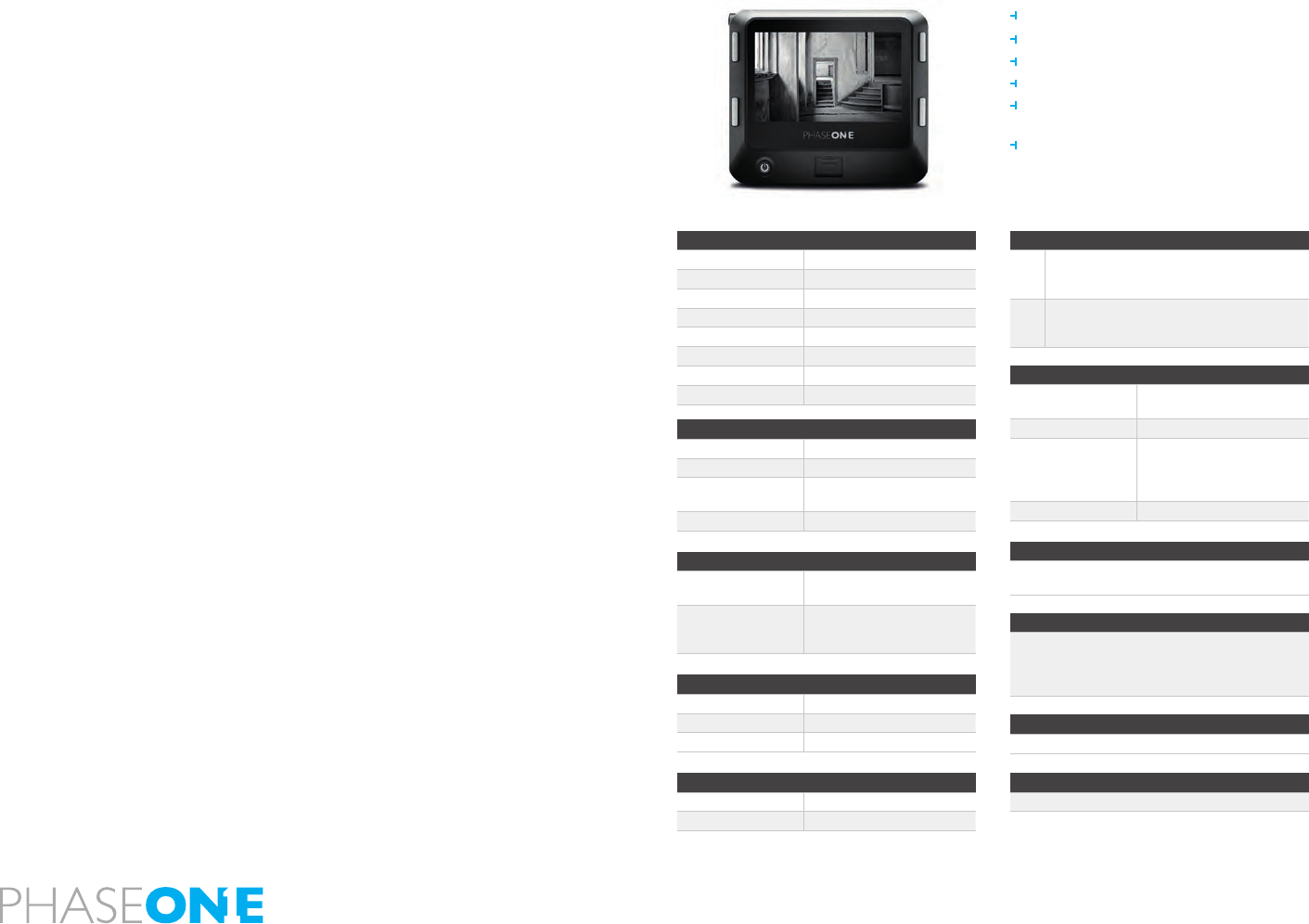
98
8.3 IQ260 Arhromatic Digital Back Specifications
60 megapixel monochrome full-frame 645 CCD
Designed for pure Black and White Photography
Built in wireless technology
Extreme 13 f-stops dynamic range
1.15 megapixel resolution 3.2” display with
vibrant colors
Touch screen functionality to pan, browse and
zoom up to 400%
IMAGING TECHNOLOGY
CCD Full frame Monochrome CCD
Lens factor 1.0 / Full frame
Resolution 60 megapixel
Active pixels 8964 x 6716 pixels
CCD size effective 53.7 mm x 40.3 mm
Pixel size 6 x 6 micron
Image ratio 4:3
Dynamic range 13 f-stops
OPERATING CONDITIONS
Temperature -10º to 50ºC (14º to 122ºF)
Humidity 15 to 80% RH (non-condensing)
IQ BACK MOUNTS
Phase One/ Mamiya Phase One 645DF+/AF
Mamiya 645DF+/ AFDIII
Phase One H101 Hasselblad H1 and H2
Hasselblad V
Hasselblad 555ELD, 553ELX, 503CW
and 501CM
Via adaptor: Mamiya RZ67 Pro II
Mamiya RB67
Contax Contax 645AF
WIDE ANGLE & TECHNICAL CAMERAS
4 x 5” via FlexAdaptor: Arca Swiss, Cambo, Linhof, Toyo, Sinar,
Plaubel, Horseman.
SOFTWARE
Capture One 7.1 or later
CERTIFICATIONS
CE
STORAGE FILES
The default IIQ RAW-large format is completely lossless.
COMPUTER MINIMUM REQUIREMENTS
Mac
Fast Intel Core™ 2 Duo or later CPU, 4 GB RAM, Fast HDD:
8800 series graphics card or newer
PC
Intel® Pentium® 4, 4 GB RAM, 64bit,10 GB free hard disk
space, IEEE 1394 interface, Windows XP®, Service Pack 3
or Windows Vista®, Service Pack 1
IQ260 ACHROMATIC FULL RESOLUTION CAPTURE MODE
Resolution 60 megapixel
Pixel size 6 x 6 micron
IIQ large: 60 MB
IIQ small: 40 MB
ISO 200, 400, 800, 1600, 3200
OUTPUT FILES (VIA CAPTURE ONE)
Color depth 16 bit Monochromatic Black and
White
All output formats of Capture One
are possible: TIFF-RGB, TIFF-CMYK,
JPEG
LCD SCREEN
Size 3.2”
Resolution 1.15 megapixel touch screen
Viewing angle 170º
Content is subject to change without notice